Contents
- 1. Manual 1
- 2. Manual 2
- 3. Manual 3
Manual 2

115 Calendar
Changing Calendar settings
You can change Calendar settings to specify how it displays events and how it notifies
you of upcoming events. In any Calendar view, press MENU and then tap More >
Settings to access Calendar’s settings.
Reminder settings
Choose how you want Calendar to issue event reminders when there are upcoming
events.
All calendars Select this check box to use the same event reminder settings
for all types of calendars. If you clear this check box, you can
set different reminder settings for each calendar.
Set alerts & notifications Configure event reminders to open an alert, send you a
notification, or turn off event notifications on your phone.
Default reminder time Choose how soon before an event you want to be notified.
Select ringtone Choose a ringtone to sound when you receive an event
reminder.
Vibrate Choose whether you want your phone to vibrate when you
receive an event notification.
Hide declined events Choose whether to show or hide events to which you’ve
declined invitations.
Calendar view settings
Choose what appears in Calendar when opened and what’s shown in Day, Week, and
Month views.
Start in Choose the default Calendar view that is displayed when you
open Calendar.
Day views Choose whether to display Day view in the form of an event
list or time list.
First day of week Set the Month and Week views to start on a Sunday or
Monday.
Include weather Make sure this check box is selected so that weather
information is shown in Day view’s event list.
City By default, Day view displays your current location’s weather.
You can change it to display the weather of another city.
About the Calendar widget
There’s a Calendar widget available that you can add to your Home screen, and it
comes in different calendar views. Tapping a day or event on the widget brings you
to the Calendar app. To find out how you can add a widget, see “Personalizing your
Home screen with widgets” in the Personalizing chapter.

116 Clock and Weather
Clock and Weather
About the HTC Clock widget
Use the HTC Clock widget to see your current date, time, and location. It’s added by
default on your Home screen. Tap the weather image to open the Weather app and
check for more weather forecasts. See “Checking weather” for details.
If you want to show the time of another city, just add another clock widget to the
extended Home screen. Select from a variety of looks and designs. To find out how
you can add a widget, see “Personalizing your Home screen with widgets” in the
Personalizing chapter.
About the Clock app
Get more from the Clock app than just the regular date and time. Use your phone as
a desk clock complete with weather information. Or let it serve as a night clock or a
screensaver. As a world clock, see what time it is in several cities across the globe. You
could also use it as an alarm clock, stopwatch, and countdown timer.
To open the Clock app, you can:
Tap the HTC Clock widget on the Home screen.
From the Home screen, tap , and then tap Clock.
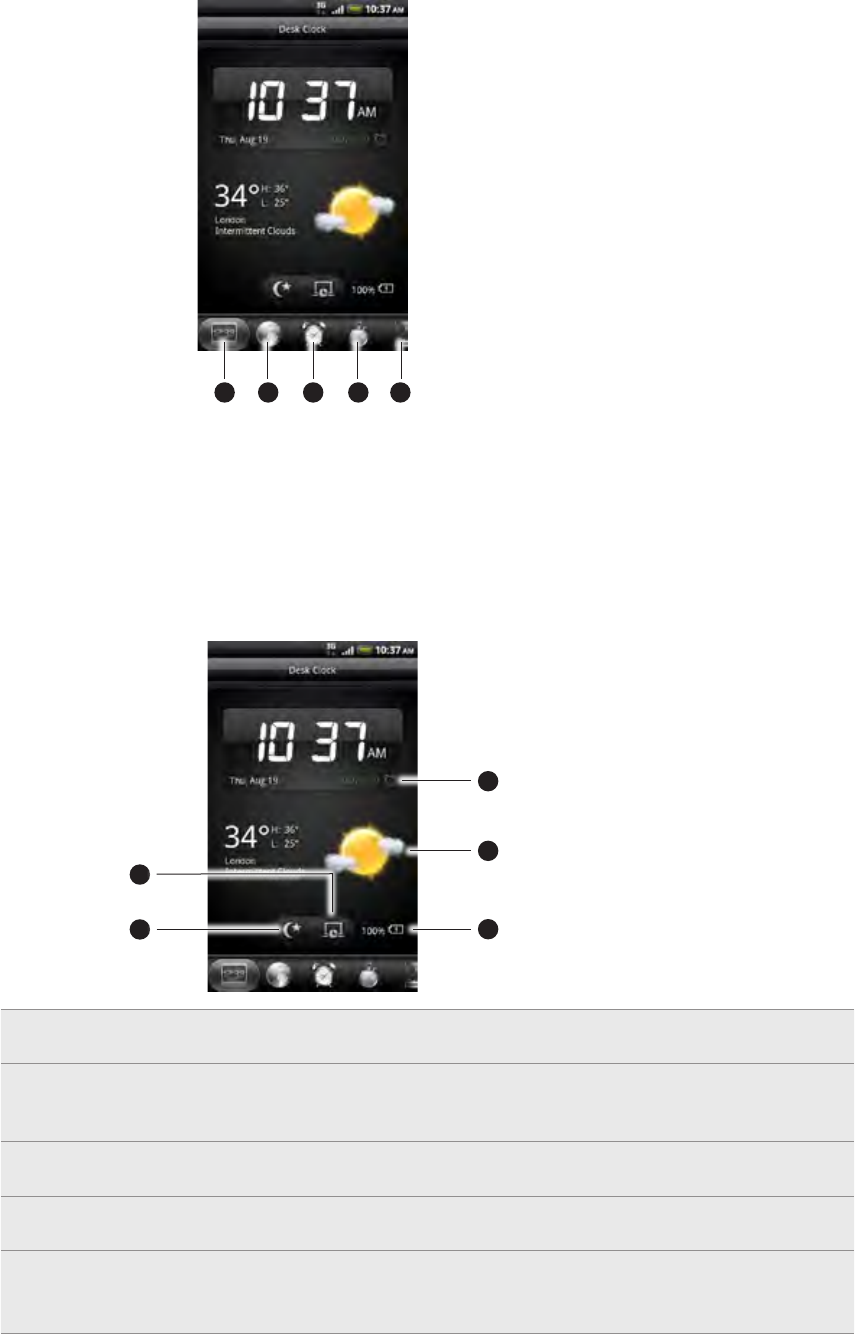
117 Clock and Weather
Tap the tabs at the bottom row or slide your finger across the tabs to switch between
the different functions of the Clock app.
2 3 451
1 Desk Clock tab
2 World Clock tab
3 Alarm Clock tab
4 Stopwatch tab
5 Timer tab
Using Desk Clock
Opening the Clock app brings you directly to the Desk Clock screen.
The Desk Clock displays the current date, time, and weather. It also an alarm clock
indicator and a battery charging indicator. You can dim the screen to show only the
time and date on the Desk Clock.
2
3
4
5
1
1 Shows whether the alarm clock is on or off. To find out how to turn on and set the alarm
clock, see “Setting the alarm clock.”
2 Shows the weather information of your current location. Tapping it brings you to the
Weather app where you can see weather forecasts of the next few days. See “Checking
weather” for more information about the Weather app.
3 Shows the battery charge level. You’ll see it only when your phone is plugged with the
power adapter or connected to your computer.
4 Tap to dim the screen and display only the time and date on the Desk Clock. To light up the
screen again, tap anywhere on the screen or press the BACK button on your phone.
5 Tap to dim the screen and go into screensaver mode. When in screensaver mode, the time
and date will change position on the screen after every few minutes. To light up the screen
again, tap anywhere on the screen or press the BACK button on your phone.
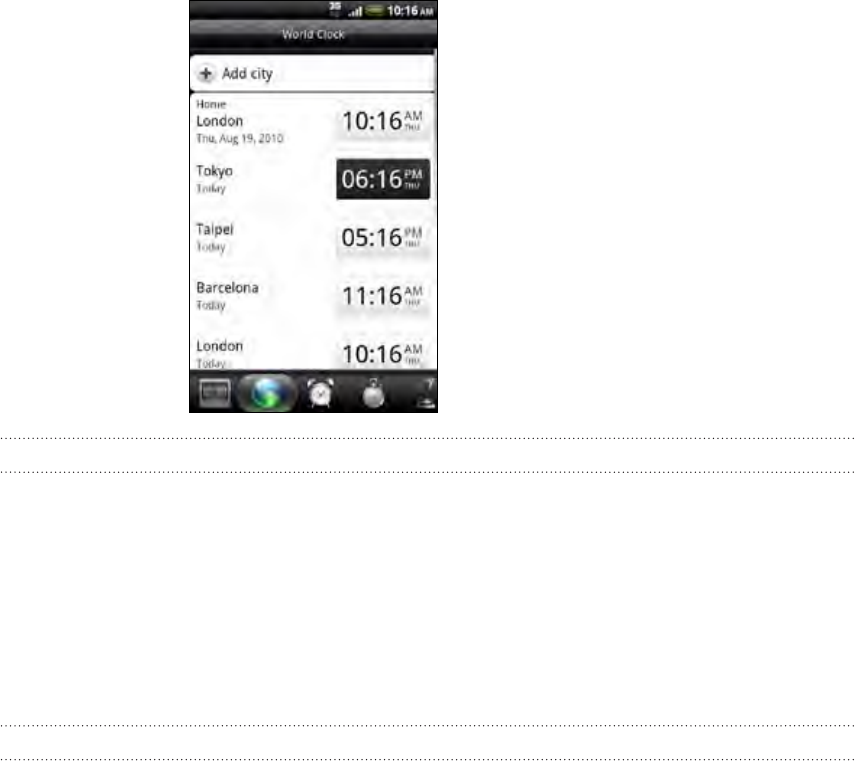
118 Clock and Weather
You can change the Desk Clock screen to display the date and time of another time
zone. To find out how to select a different time zone, see “Setting the time zone, date,
and time.”
Using World Clock
Use the Clock app’s World Clock screen to check the current time in several places
around the globe simultaneously. You can also set your home city, add more cities to
the world clock list, and manually set your time zone, date, and time.
Setting your home city
Tap the HTC Clock widget on the Home screen.
Tap the World Clock tab.
Press MENU and then tap Home settings.
Enter your home city’s name. As you enter letters, the list is filtered to show
matching cities and countries.
Scroll through the list and tap your home city.
Setting the time zone, date, and time
To set the time zone, date, and time on your phone manually, you need to turn off auto
time synchronization first.
Tap the HTC Clock widget on the Home screen.
Tap the World Clock tab.
Press MENU and then tap Local time settings to open the Date & time settings
screen.
Clear the Automatic check box.
Tap Select time zone. Scroll through the list and then tap the time zone that you
want.
1.
2.
3.
4.
5.
1.
2.
3.
4.
5.
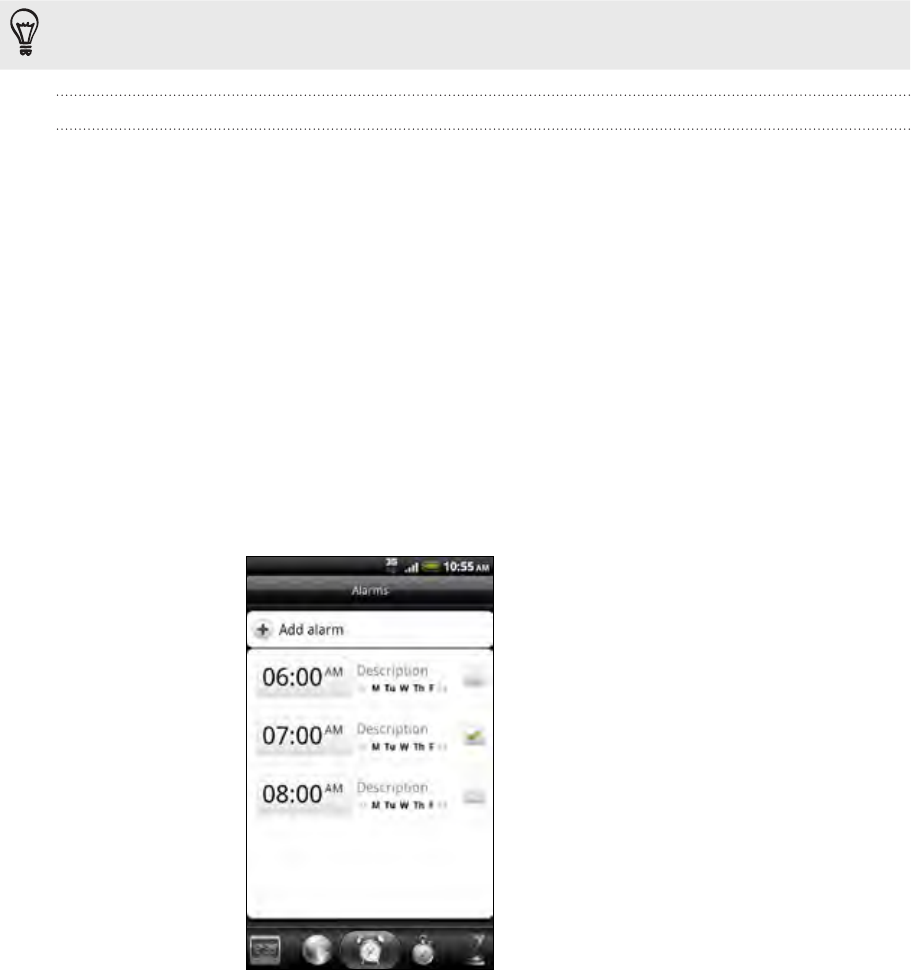
119 Clock and Weather
To change the date, tap Set date. Adjust the date by rolling the day, month, and
year scroll wheels onscreen and then tap OK.
To change the time, tap Set time. Adjust the time by rolling the hour and minute
scroll wheels onscreen and then tap OK.
Tap the Use 24-hour format check box to toggle between using a 12-hour or a
24-hour time format.
Tap Select date format then select how you want dates to be displayed. (The
selected date format also applies to the date displayed in the alarm clock.)
From the Home screen, you can also press MENU and then tap Settings > Date & time to open
the Date & time settings screen.
Adding a city to the World Clock screen
Add more cities to the World Clock screen so you can instantly check the date and
time in these cities. In addition to the current and home cities, the World Clock screen
can display up to 15 cities.
Tap the HTC Clock widget on the Home screen.
Tap the World Clock tab.
Tap Add city. Enter the city name you want to add. As you enter letters, the list
is filtered to show matching cities and countries.
Scroll through the matching list and tap the city that you want to add.
Setting the alarm clock
You can use the Clock app’s Alarms screen to set up one or more wake-up alarms.
6.
7.
8.
9.
1.
2.
3.
4.
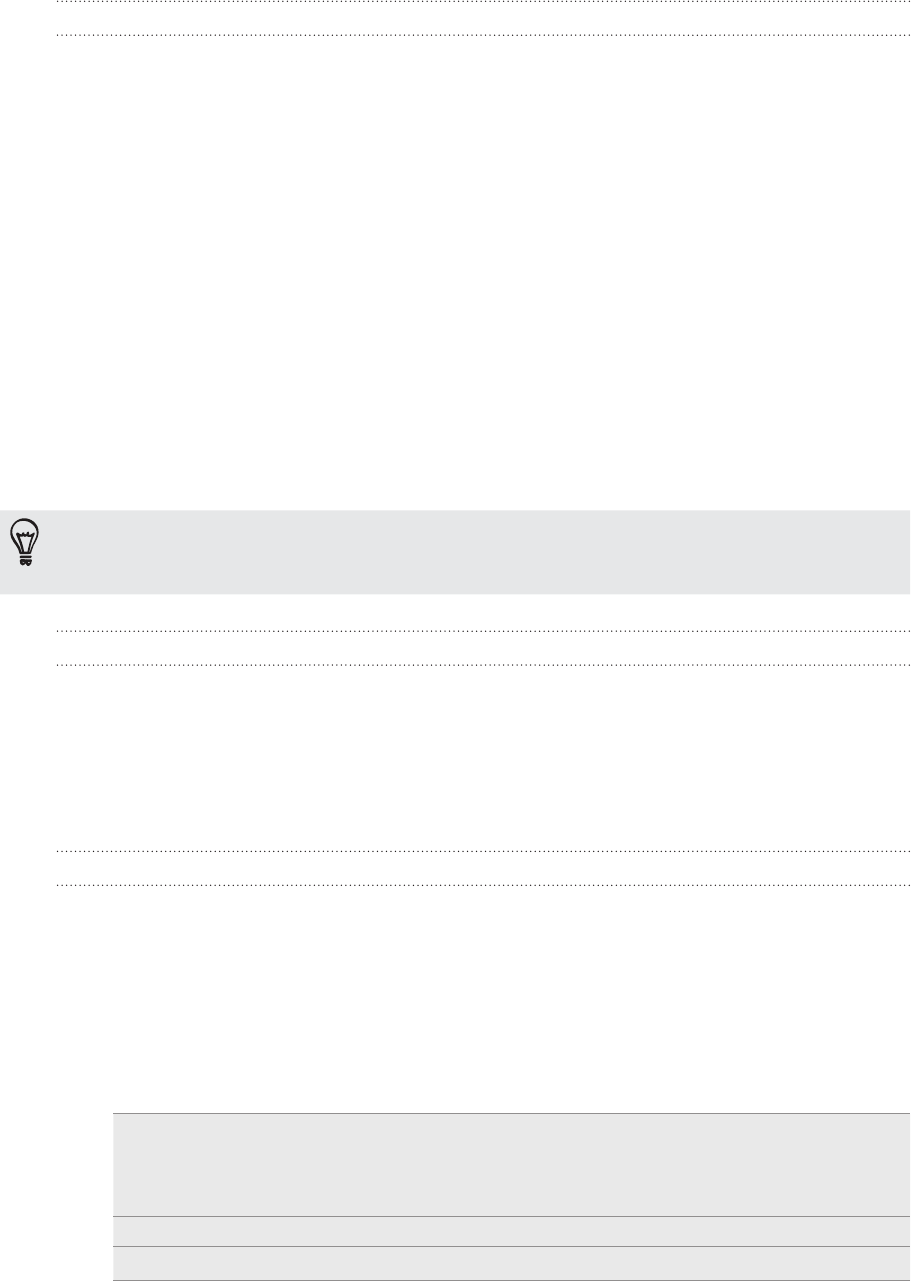
120 Clock and Weather
Setting an alarm
1. Tap the HTC Clock widget on the Home screen.
2. Tap the Alarms tab.
3. Select the check box of an alarm. and then tap that alarm.
4. On the Set alarm screen, drag your finger up or down to roll the time scroll
wheels and set the alarm time.
5. Scroll through the Set alarms screen to see all the available alarm options. You
can:
Enter the alarm Description and choose the Alarm sound to use.
Tap Repeat. Select what days of the week to sound the alarm and then tap
OK.
Select the Vibrate check box if you want your phone to also vibrate when
the alarm goes off.
6. When you’ve finished setting the alarm, tap Done.
To turn off an alarm, tap (clear) the check box of that alarm.
If you need to set more than three alarms, press MENU while you’re on the Alarms screen
and then tap Add alarm.
Deleting an alarm
Tap the HTC Clock widget on the Home screen.
Tap the Alarms tab.
On the Alarms screen, press MENU and then tap Delete.
Select the alarms you want to delete and then tap Delete.
Changing alarm sound settings
If you’ve set one or more alarms, you can change their settings such as the alarm
volume, how long to snooze the alarm, and more.
Tap the HTC Clock widget on the Home screen.
Tap the Alarms tab.
On the Alarms screen, press MENU and then tap Settings. You can change the
following settings:
Alarm in silent mode Selected by default, this option allows the alarm to sound
even when your phone’s volume is set to silent mode.
Clear this check box if you want to silence the alarm when
the volume is in silent mode.
Alarm volume Set the volume level that you want for the alarm.
Snooze duration Set how long to snooze between alarms.
1.
2.
3.
4.
1.
2.
3.
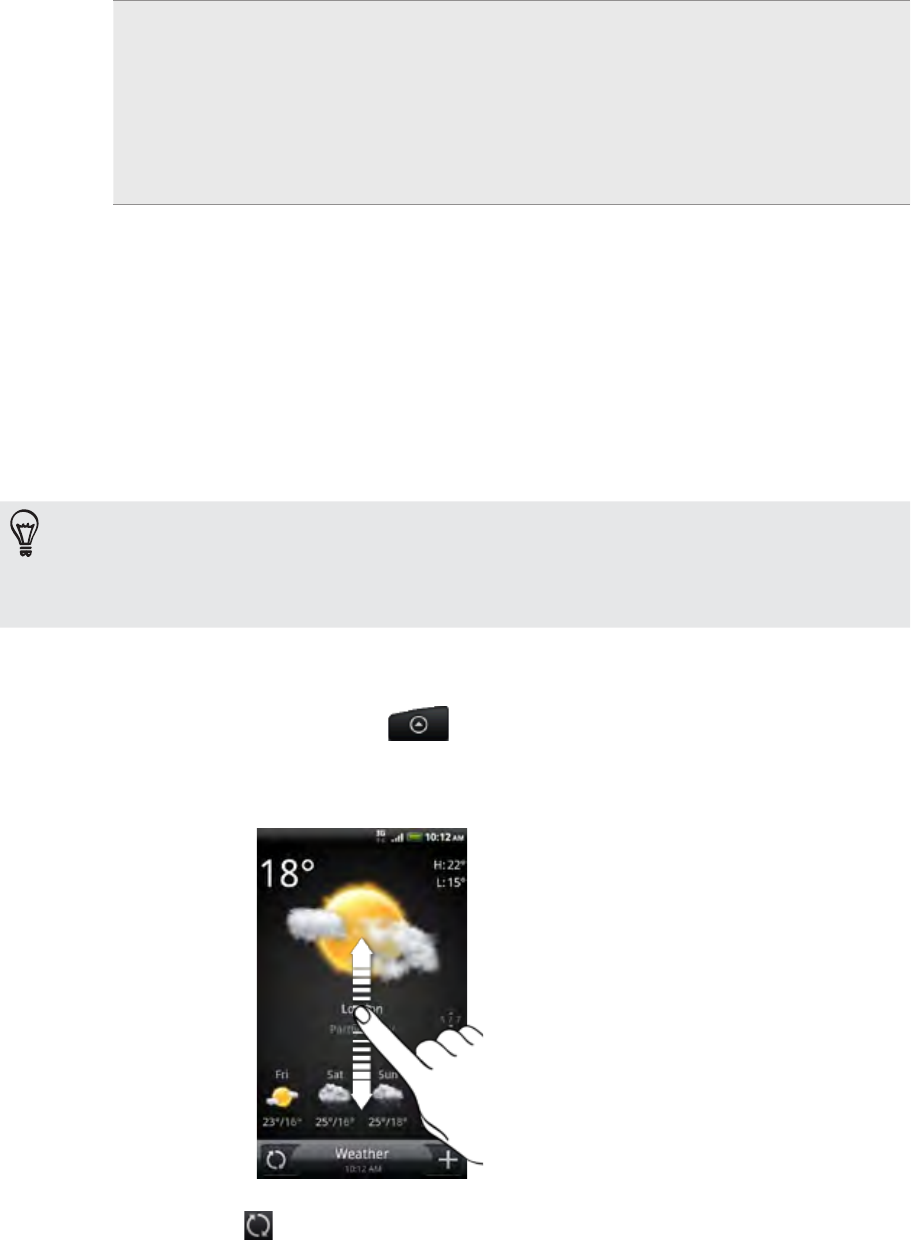
121 Clock and Weather
Side button behavior Choose what happens to the alarm when pressing the side
button (VOLUME UP/DOWN) of your phone. You can set
the button to snooze, dismiss the alarm, or disable the
button.
The side button works only when the phone’s screen is not
locked. While on the lock screen, tap the onscreen Snooze
button to snooze, or slide down the screen to dismiss the
alarm.
Checking weather
If you consented to turn location service on when you were setting up your phone for
the first time, you’ll see the weather of your current location right on the HTC Clock
widget of your Home screen.
You can also check the current weather and weather forecasts for the next four days
of the week. In addition to your current location’s weather, this app also displays the
weather forecasts of other cities around the globe.
If you declined to turn location service on during first-time setup of your phone, turn location
service on in your phone’s settings so that you’ll be able to check your current location’s
weather on the HTC Clock widget, Weather app, and the Weather widget. From the Home
screen, press MENU, tap Settings > Location, and then select the Use wireless networks check
box.
1. Connect to the Internet using your phone’s Wi-Fi or data connection. To find out
how, see the Internet connections chapter.
2. From the Home screen, tap , and then tap Weather.
3. On the Weather screen, you’ll first see your current location’s weather. To check
the weather in other cities, swipe your finger up or down the screen.
4. The Weather app automatically downloads and displays the latest weather
updates. Tap to update the information anytime.
5. To see more weather details on the Web, tap Weather at the bottom center of
the Weather screen.

122 Clock and Weather
Adding a city to the Weather screen
Add more cities to the Weather screen so you can instantly check the weather
forecasts in these cities. In addition to your current location, the Weather screen can
display up to 15 cities.
On the Weather screen, tap .
Enter the location you want to add. As you type, the list is filtered to show the
possible locations based on the letters you entered.
Tap the desired city to select it.
Changing the order of cities on the Weather screen
On the Weather screen, press MENU and then tap Rearrange.
Press and hold at the end of the item you want to move. When the row is
highlighted in green, drag it to its new position, then release.
Tap Done.
Deleting cities from the Weather screen
On the Weather screen, press MENU and then tap Delete.
Select the cities you want to remove and then tap Delete.
Changing weather options
On the Weather screen, press MENU and then tap Settings.
You can change the following weather settings:
Update automatically Select this check box to automatically download weather
updates.
Update schedule Set an auto update schedule.
Temperature scale Choose whether to display weather in Celsius or
Fahrenheit.
About the Weather widget
Use the Weather widget to instantly check weather forecasts of your current location
and other cities without having to open the Weather app. The Weather widget comes
in different looks and styles.
You can add this widget to the Home screen, if it’s not yet added. To find out how
you can add a widget, see “Personalizing your Home screen with widgets” in the
Personalizing chapter.
1.
2.
3.
1.
2.
3.
1.
2.
1.
2.

123 Internet connections
Internet connections
Data connection
Your phone will be automatically set up to use your mobile operator’s data connection
when you turn on your phone (if the SIM card is inserted) for the first time.
Checking the data connection you are using
From the Home screen, press MENU, and then tap Settings
Tap Wireless & networks > Mobile networks > Network operators or Access
Point Names.
Turning the data connection on or off
Turning your data connection off can help save battery life and save money on data
charges. However, if you don’t have data connection turned on and you’re also not
connected to a Wi-Fi network, you won’t receive automatic updates to your email,
social network accounts, and other synchronized information.
From the Home screen, press MENU, and then tap Settings.
Tap Wireless & networks.
Select the Mobile network check box to turn on the data connection; clear the
check box to turn off the data connection.
Creating a new access point
Before you add another data connection on your phone, have the access point name
and settings (including username and password if required) from your mobile operator
ready.
From the Home screen, press MENU, and then tappress MENU, and then tap Settings.
Tap Wireless & networks > Mobile networks > Access Point Names.
On the APNs screen, press MENU and then tap New APN.
On the Edit access point screen, enter the APN settings. Tap the APN setting
item to edit it.
Press MENU and then tap Save.
1.
2.
1.
2.
3.
1.
2.
3.
4.
5.

124 Internet connections
Enabling data roaming
Connect to your mobile operator’s partner networks and access data services when
you’re out of your mobile operator’s coverage area.
Using data services while roaming will be costly. Check with your mobile operator for data
roaming rates before you use data roaming.
From the Home screen, press MENU, and then tappress MENU, and then tap Settings.
Tap Wireless & networks > Mobile networks, and then select the Data roaming
check box.
Select the Data roaming sound check box if you’d like your phone to play a
sound so you’ll know when it’s connecting to a roaming network.
Wi-Fi
To use Wi-Fi on your phone, you need access to a wireless access point or “hotspot”.
The availability and strength of the Wi-Fi signal will vary depending on objects, such
as buildings or simply a wall between rooms, the Wi-Fi signal has to pass through.
Turning Wi-Fi on and connecting to a wireless network
From the Home screen, press MENU, and then tap Settings.
Tap Wireless & networks, and then select the Wi-Fi check box to turn Wi-Fi on.
The phone then scans for available wireless networks.
Tap Wi-Fi settings. The network names and security settings of detected Wi-Fi
networks are displayed in the Wi-Fi networks section.
If the wireless network you want to connect to is not in the list of detected
networks, scroll down the screen, and then tap Add Wi-Fi network. Enter the
wireless network settings, and then tap Save.
Tap the Wi-Fi network you want to connect to.
If you selected an open network, you’ll be automatically connected to the
network.
If you selected a network that is secured with WEP, enter the key and then
tap Connect.
Depending on the network type and its security settings, you may also need to enter more
information or choose a security certificate.
When your phone is connected to a wireless network, the Wi-Fi icon appears in the
status bar and tells you the approximate signal strength (number of bands that light
up).
The next time your phone connects to a previously accessed secured wireless network,
you won’t be asked to enter the key or other security information again, unless you
reset your phone to its factory default settings.
1.
2.
1.
2.
3.
4.
5.

125 Internet connections
Connecting to a Wi-Fi network with EAP-TLS security
You may need to install a network certificate (*.p12) to your phone before you can
connect to a Wi-Fi network with EAP-TLS authentication protocol.
Save the certificate file to the root folder of the storage card.
From the Home screen, press MENU, and then tap Settings.
Tap Security > Install from SD card.
Select the network certificate needed to connect to the EAP-TLS network.
Follow the steps in the previous section to connect to the Wi-Fi network.
Checking the wireless network status
From the Home screen, press MENU, and then tap Settings.
Tap Wireless & networks.
On the Wireless & networks screen, tap Wi-Fi settings, and then tap the wireless
network that the phone is currently connected to.
A message box is then displayed showing the Wi-Fi network name, status, speed,
signal strength, and more.
If you want to remove the wireless network settings on your phone, tap Forget. You’ll need to
enter the settings again if you want to connect to this wireless network.
Connecting to another Wi-Fi network
From the Home screen, press MENU, and then tap Settings.
Tap Wireless & networks > Wi-Fi settingsWi-Fi settings. Detected Wi-Fi networks are displayed
in the Wi-Fi networks section.
To manually scan for available Wi-Fi networks, on the Wi-Fi settings screen,
press MENU and then tap Scan.
Tap another Wi-Fi network to connect to it.
1.
2.
3.
4.
5.
1.
2.
3.
1.
2.
3.
4.

126 Internet connections
Adding connection widgets
Add the Mobile Network and Wi-Fi widgets or the Data dashboard widget to the
Home screen to make it faster for you to turn on or off these connections. Tap the
widget or icon on the dashboard to turn on or off the connection.
To find out how to add widgets, see “Adding a widget to your Home screen” in the
Personalizing chapter.
Connecting to a virtual private network (VPN)
Add, set up, and manage virtual private networks (VPNs) so you can connect and
access resources inside a secured local network, such as your corporate network.
Depending on the type of VPN you’re using at work, you may be asked to enter
your login credentials and install security certificates before you can connect to
your company’s local network. You can get this information from your network
administrator.
Also, your phone must first establish a Wi-Fi or data connection before you can start
a VPN connection. For information about setting up and using these connections on
your phone, see “Data connection” and “Wi-Fi” in this chapter.
Setting up secure credential storage
If your network administrator tells you to download and install security certificates,
you must first set up the phone’s secure credential storage.
From the Home screen, press MENU, and then tap Settings.
Tap Security > Set password.
Enter a new password for the credential storage.
Scroll down and confirm the password, and then tap OK.
Select the Use secure credentials check box.
You can then download and install the certificates needed to access your local
network. Your network administrator can tell you how to do this.
1.
2.
3.
4.
5.

127 Internet connections
Adding a VPN connection
From the Home screen, press MENU, and then tappress MENU, and then tap Settings.
Tap Wireless & networks > VPN settings.
Tap Add VPN, and then tap the type of VPN you want to add.
Tap the VPN settings and set them up according to the security details your
network administrator gave you.
Press MENU, and then tap Save.
The VPN is then added to the VPNs section of the VPN settings screen.
Connecting to a VPN
From the Home screen, press MENU, and then tapress MENU, and then tap Settings.
Tap Wireless & networks > VPN settings.
In the VPNs section, tap the VPN that you want to connect to.
When asked, enter your log in credentials, and then tap Connect.
When you’re connected, the VPN connected icon appears in the notification
area of the title bar.
You can then open the web browser to access resources such as your corporate
network intranet.
Disconnecting from a VPN
Press and hold the title bar, and then slide down your finger to open the
Notifications panel.
Tap the VPN connection to return to the VPN settings screen, and then tap the
VPN connection to disconnect from it.
When your phone has disconnected from the VPN, the VPN disconnected icon is
displayed in the notification area of the title bar.
Using your phone as a modem (tethering)
No Internet connection available for your computer? No problem. Use your phone’s
data connection to connect to the Internet using your computer.
You need your SIM card inserted on your phone to use the data connection. To find
out how to set up and use the data connection, see “Data connection” earlier in this
chapter.
Before you can use your phone as a modem, be sure to install HTC Sync on your
computer first. To find out how to install HTC Sync, see “Synchronizing with your
computer” in the Accounts and sync chapter.
Make sure your phone’s data connection is turned on. See “Turning the data
connection on or off” earlier in this chapter to find out how to turn on the
phone’s data connection.
1.
2.
3.
4.
5.
1.
2.
3.
4.
1.
2.
1.

128 Internet connections
Connect the phone to the computer using the provided USB cable.
On the Connect to PC screen, select Mobile network sharing, and then tap Done.
Connecting your phone to the Internet through
a computer (Internet Pass-through)
If you don’t have a data plan for your phone or you don’t have access to a Wi-Fi
network, you can still go online on your phone by using your computer’s Internet
connection.
Before you can use your computer as a modem, be sure to install HTC Sync on your
computer first. To find out how to install HTC Sync, see “Synchronizing with your
computer” in the Accounts and sync chapter.
Make sure your computer is connected to the Internet.
Two things to check for your computer’s Internet connection. One, we recommend that you
turn off your local network’s firewall. Two, if your computer connects to the Internet via PPP
(e.g. Dial UP, xDSL, or VPN), Internet Pass-through will only support TCP protocol.
2. Connect the phone to the computer using the provided USB cable.
3. On the Connect to PC screen, select Internet Pass-through, and then tap Done.
4. On the message window, tap OK.
Using your phone as a wireless router
Share your data connection with other devices by turning your phone into a wireless
router. Make sure your phone’s data connection is turned on before you use it as a
wireless router. To find out how to turn on your phone’s data connection, see “Data
connection” earlier in this chapter.
From the Home screen, press MENU, and then tap Settings.
Tap Wireless & networks > Portable Wi-Fi hotspot settings.
The first time you open Portable Wi-Fi hotspot, a brief introduction describing the application
is displayed. Tap OK.
3. Enter a name in Router name (SSID), or use the default router name.
4. Choose the type of Security and set the Password (key) for your wireless router.
If you selected None in Security, you don’t need to enter a password.
The password is the key other people need to enter on their device so they can
connect and use your phone as a wireless router.
5. Select the Portable Wi-Fi Hotspot check box to turn on your phone’s wireless
router.
Your phone is ready to be used as a wireless router when you see on the status bar.
Only two devices can connect to your phone’s wireless router at one time so if a third
device tries to connect to your phone, it won’t be able to.
2.
3.
1.
1.
2.
Please note that personal hotspot capabilities are enabled only in 802.11 b/g/n channel 1~11. The
personal hotspot capabilities are always disabled by firmware on 802.11bgn channel 12~ 14, and all
802.11a sub-bands, 5150 ~ 5250MHz, 5250~ 5350MHz, 5350~ 5470MHz and 5725~5850MHz.
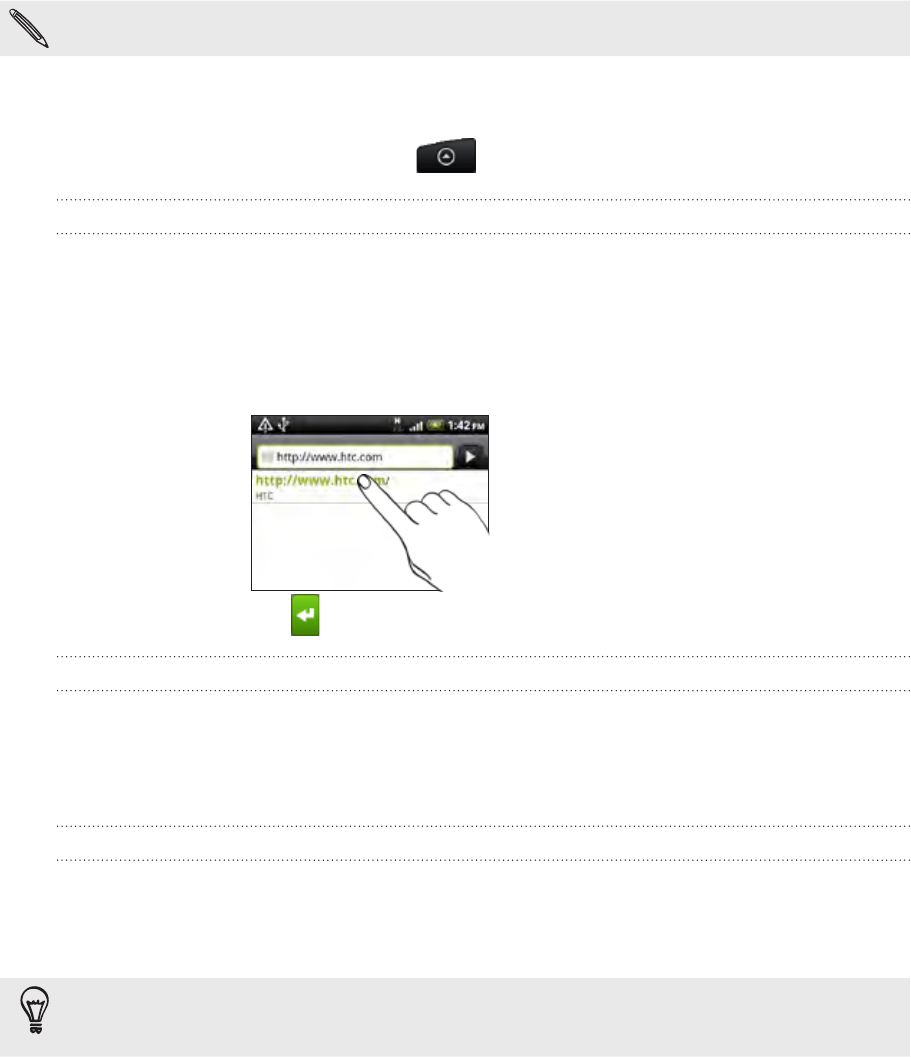
129 Web browser
Web browser
Using your phone’s web browser
You must have an active data connection or Wi-Fi connection to access the Internet.
Do one of the following to open the web browser and start surfing the Web:
On the Home screen, tap Internet.
From the Home screen, tap > Internet.
Going to a webpage
On the browser screen, press MENU and then tap the URL field on top of the
screen.
2. Enter the webpage address using the keyboard. As you enter the address,
matching webpage addresses will appear on the screen. Tap an address to go
directly to that webpage or continue entering the webpage address.
3. Tap the Enter key on the onscreen keyboard.
Setting your home page
From the browser screen, press MENU, and then tap More > Settings > Set home
page.
On the Set home page screen, select the home page you want to use.
Changing the screen orientation
The phone automatically changes the screen orientation depending on how you’re
holding your phone.
Turn your phone sideways to display the web browser in landscape orientation.
If the screen orientation doesn’t change automatically, please switch automatic screen
orientation on. From the Home screen, press MENU, tap Settings > Display, and then select
the Auto-rotate screen check box.
1.
1.
2.
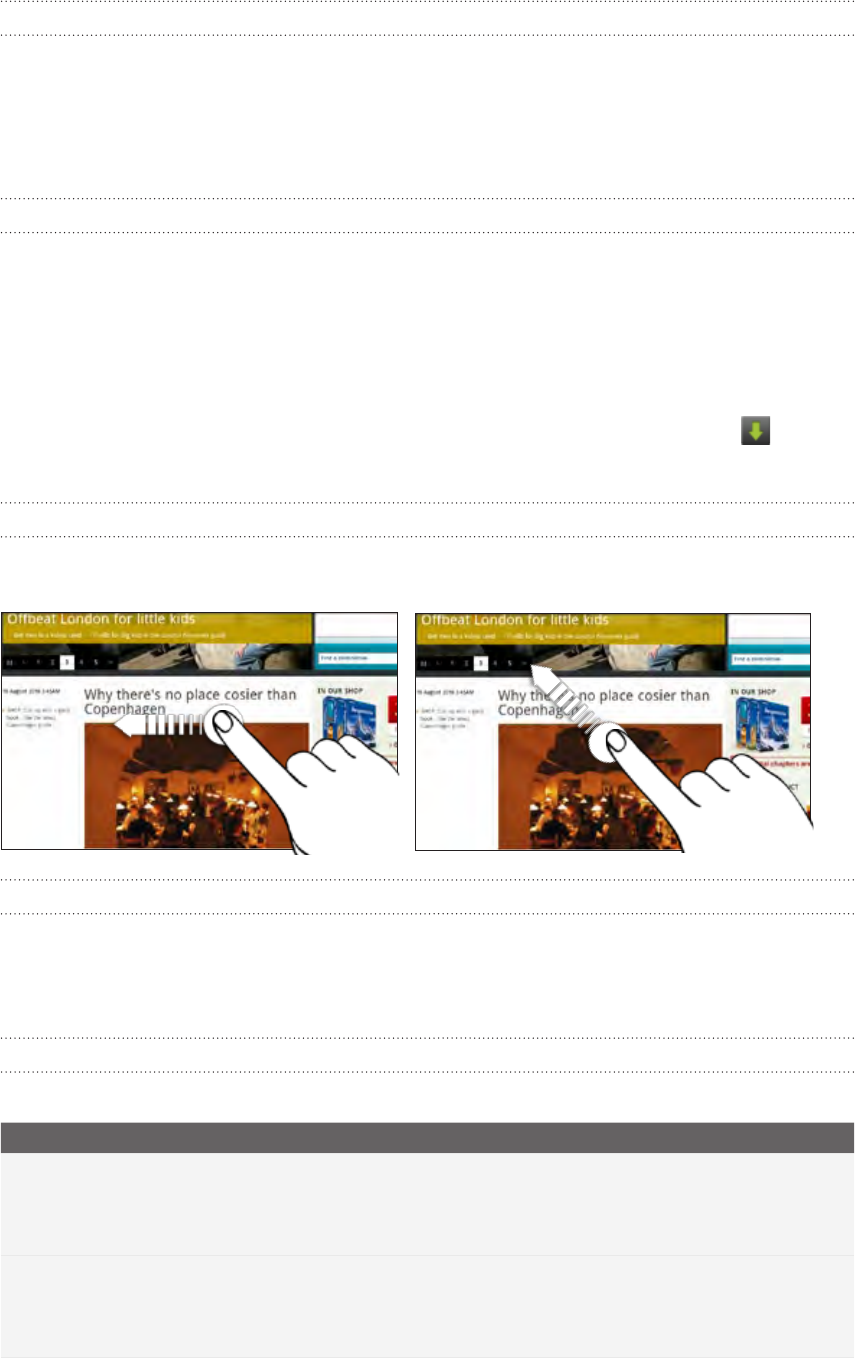
130 Web browser
Browsing full versions of all websites
Some websites display a mobile version of their pages on phone web browsers. You
can choose to view the full version of all pages, even for these sites.
From the browser screen, press MENU, tap More > Settings, and then clear the Mobile
view check box.
Choosing when to show Flash content
Choose which Flash® content you want to see by switching to On demand. By
switching to On demand, you decide when Flash content appear on a webpage.
From the browser screen, press MENU, and then tap More > Settings > Enable
plugins.
Tap On demand.
After switching to On demand, you can show the Flash content by tapping on the
web page.
Navigating on a webpage
You can swipe your finger on the screen to navigate and view other areas of the
webpage.
Zooming in or out on a webpage
Tap the screen twice quickly to zoom in, then tap the screen twice quickly again to
zoom out. You can also use your fingers to spread or pinch the screen to zoom in and
out.
Selecting a link in a webpage
You can tap a link with your finger to open it, or press and hold a link for more options.
Link What to do
Webpage address
(URLs)
Tap the link to open the webpage.
Press and hold the link to open a menu that allows you to open,
bookmark, copy to the clipboard, or share the link via email or your
social networks.
Email address Tap to send an email message to the email address.
Press and hold, then tap Copy on the menu to copy the email
address to the clipboard. You can paste the email address later
when creating a new contact or sending a new email message.
1.
2.
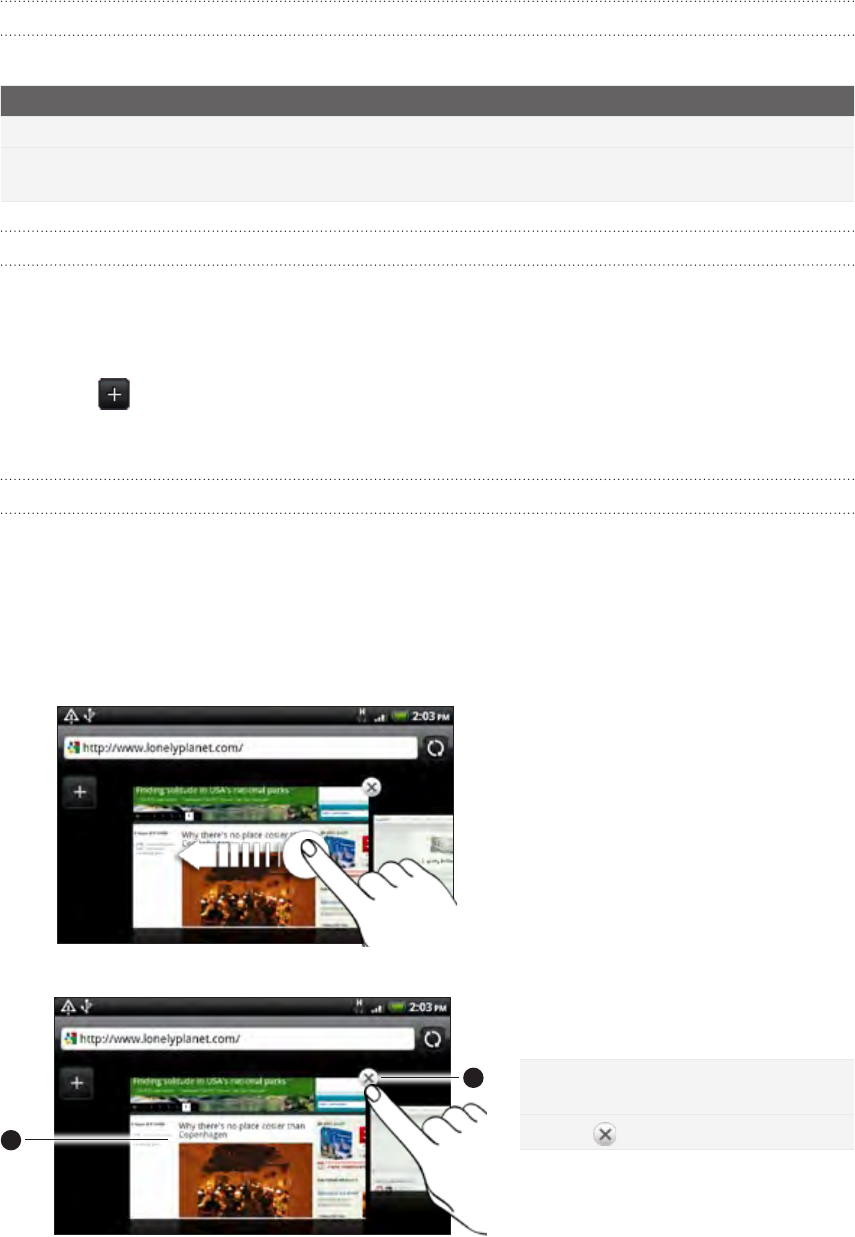
131 Web browser
Selecting an address or phone number in a webpage
You can map an address or call a phone number on a webpage.
Link What to do
Location address Tap the address to copy it or map it using Google Maps™.
Phone number Tap the phone number to copy, call, send a text message to that
number, or save the number to a contact in People.
Opening a new browser window
Open multiple browser windows to make it easier for you to switch from one website
to another. You can open up to 4 browser windows.
While viewing a webpage, press MENU and then tap Windows.
Tap .
A new browser window opens and goes to the home page that is set.
Switching between browser windows
While viewing a web page, do one of the following:
Press MENU and then tap Windows.
Pinch the screen (zoom out) until you see the other browser windows.
2. Select the browser window you want to view by sliding your finger on the screen
from right to left.
You can also do the following:
1
21 Tap a webpage to display it in
full screen.
2 Tap to close a webpage.
1.
2.
1.

132 Web browser
Downloading applications from the web
All downloaded applications are saved to the storage card. Before you download an
application from the web, make sure that you have installed a storage card on your phone. For
information on how to install a storage card, refer to the Basics chapter.
Before you can download applications from the web, you must first enable
downloading from the phone settings.
From the Home screen, press MENU, and then tap Settings.
Tap Applications, and then select the Unknown sources check box.
When the Attention dialog box opens, tap OK.
Applications downloaded from the web can be from unknown sources. To protect your phone
and personal data, download applications only from trusted sources such as Android Market.
Refer to “Finding and installing apps from Android Market” in the More apps chapter for
details.
Viewing your downloads
While viewing a webpage, press MENU and then tap More > Downloads.
Copying text, looking up information, and
sharing
You can select text and then:
Copy it.
Search it using Google Search.
Look it up on Wikipedia, YouTube, or Google Dictionary.
Get a translation of the text from Google Translate.
Share the text in a new email, text, or multimedia message or in your status
update on a social network.
Finding text within a webpage
While viewing a webpage, press MENU and then tap More > Find on page.
Enter what you want to search for. As you enter characters, matching characters
will be highlighted. Tap the left or right arrow to go to the previous or next
matching item.
1.
2.
3.
1.
2.
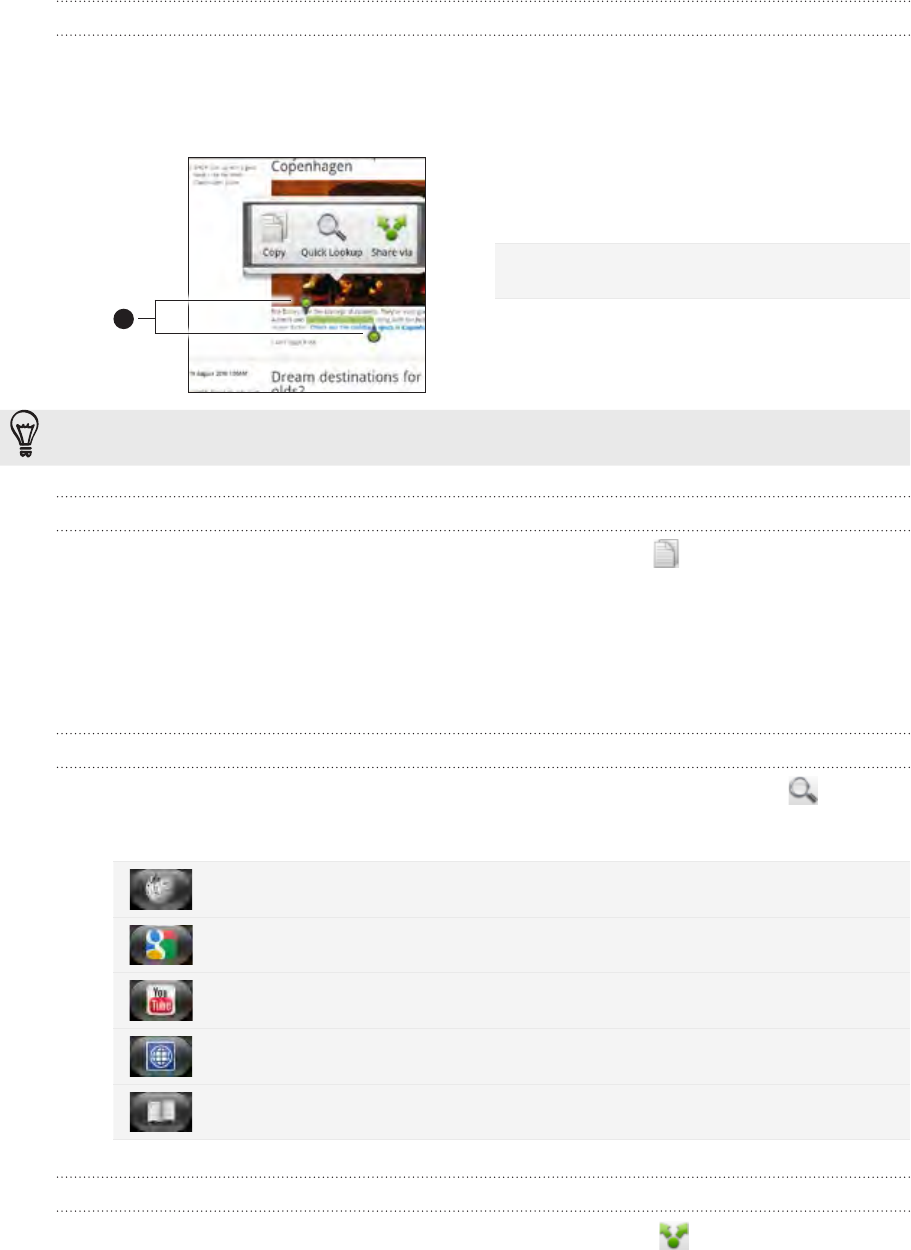
133 Web browser
Selecting text
1. Press and hold on a word.
2. Drag the start and end markers to highlight the surrounding text you want to
select.
1
1 Start and end markers. Drag to increase
or decrease the text selection area.
To select text in a link, press and hold the link, and then tap Copy link URL.
Copying and pasting text
After you have selected the text you want to copy, tap . The selected text is
then copied to the clipboard.
In a text entry field (for example while composing a message), press and hold at
the point where you want to paste the text.
Tap Paste.
Searching or translating text
1. After you have selected the text you want to search or translate, tap .
2. Tap one of the following tabs:
Wikipedia. Look for related information on Wikipedia, based on the text that
you selected.
Google Search. Look for related information using Google Search, based on
the text that you selected.
YouTube. Look for videos on YouTube, based on the text that you selected.
Google Translate. Translate the text to another language.
Google Dictionary. Look up the selected text in the dictionary.
Pasting text in a new message or social network status update
1. After you have selected the text you want to share, tap .
2. Select an option to paste the selected text in a new email, text or multimedia
message or in your status update on a social network such as Twitter. See
the Email, Messages, and Social chapters for more information on using these
features.
1.
2.
3.

134 Web browser
Viewing bookmarks and previously visited
pages
You can store as many bookmarks as you want on your phone. You can also access a
convenient History list of the sites you have visited, or quickly view the pages that you
access most often.
Bookmarking a webpage
While viewing a webpage, press MENU, and then tap Add bookmark.
Edit the bookmark name if needed, and then tap Add.
Opening a bookmark
While viewing a webpage, press MENU, and then tap Bookmarks.
On the Bookmarks tab , navigate to the bookmark you want to open, and
then tap it.
Editing a bookmark
While viewing a webpage, press MENU, and then tap Bookmarks.
On the Bookmarks tab , press MENU and then tap Edit.
Tap the bookmark you want to edit.
Enter your changes, and then tap Add.
Viewing a previously visited page
While viewing a webpage, press MENU, and then tap Bookmarks.
On the History tab , navigate to the page you want to view and then tap the
page.
Clearing the list of previously visited pages
While viewing a webpage, press MENU, and then tap Bookmarks.
On the History tab , press MENU, and then tap Clear history.
Viewing a page that you often visit
While viewing a webpage, press MENU, and then tap Bookmarks.
On the Most visited tab , navigate to the page you want to view, and then
tap the page.
Clearing the list of most visited pages
While viewing a webpage, press MENU, and then tap Bookmarks.
On the Most visited tab , press MENU, and then tap Clear all.
1.
2.
1.
2.
1.
2.
3.
4.
1.
2.
1.
2.
1.
2.
1.
2.

135 Web browser
Changing the view of bookmarks or most visited pages
While viewing a webpage, press MENU, and then tap Bookmarks.
On the Bookmarks tab or the Most visited tab , press MENU, and
then tap Thumbnails, List, or Grid to change the view. For example, if you are in
Thumbnails view and you want to view bookmarks in a grid, press MENU > List,
and then press MENU > Grid.
Setting browser options
Customize the web browser to suit your browsing lifestyle. Set display, privacy, and
security options when using the web browser.
From the browser screen, press MENU, and then tap More > Settings.
1.
2.

136 Bluetooth
Bluetooth
Bluetooth basics
Turning Bluetooth on or off
From the Home screen, press MENU, and then tap Settings > Wireless &
networks.
Select or clear the Bluetooth check box.
An even easier way to turn Bluetooth on or off is with the Bluetooth widget or
Bluetooth setting shortcut on the Home screen. To find out how to add widgets and
shortcuts to the Home screen, see the Personalizing chapter.
Turn off Bluetooth when not in use to save battery power, or in places where using a wireless
device is prohibited, such as on board an aircraft and in hospitals.
Changing the phone name
The phone name identifies your phone to other devices.
From the Home screen, press MENU, and then tap Settings > Wireless &
networks > Bluetooth settings.
If the Bluetooth check box is not selected, select it to turn Bluetooth on.
Tap Device name.
Enter the name for your phone in the dialog box, and then tap OK.
Connecting a Bluetooth headset or car kit
You can listen to music over a Bluetooth stereo headset, or have hands-free
conversations using a compatible Bluetooth headset or car kit. It’s the same procedure
to set up stereo audio and hands-free.
For you to listen to music with your headset or car kit, the headset or car kit
must support the A2DP Bluetooth profile.
Before you connect your headset, you need to make it discoverable so
your phone can find it. You can find out how to do this by referring to your
headset manual.
1. From the Home screen, press MENU, and then tap Settings > Wireless &
networks > Bluetooth settings.
2. If the Bluetooth check box is not selected, select it to turn Bluetooth on.
3. Make sure that the headset is discoverable.
1.
2.
1.
2.
3.
4.

137 Bluetooth
4. Tap Scan for devices. Your phone will start to scan for Bluetooth devices within
range.
5. When you see the name of your headset displayed in the Bluetooth devices
section, tap the name. Your phone then automatically tries to pair with the
headset.
6. If automatic pairing fails, enter the passcode supplied with your headset.
The pairing and connection status is displayed below the hands-free headset or car
kit name in the Bluetooth devices section. When the Bluetooth headset or car kit is
connected to your phone, the Bluetooth connected icon is displayed in the status
bar. Depending on the type of headset or car kit you have connected, you can then
start using the headset or car kit to listen to music and/or make and receive phone
calls.
Reconnecting a headset or car kit
Normally, you can easily reconnect your headset by switching on Bluetooth on your
phone, and then turning on the headset. However, you might have to connect manually
if your headset has been used with another Bluetooth device.
From the Home screen, press MENU, and then tap Settings > Wireless &
networks > Bluetooth settings.
If the Bluetooth check box is not selected, select it to turn Bluetooth on..
Make sure that the headset is discoverable.
Tap the headset’s name in the Bluetooth devices section.
If prompted to enter a passcode, try 0000 or 1234, or consult the headset/car kit
documentation to find the passcode.
If you still cannot reconnect to the headset or car kit, follow the instructions in
“Unpairing from a Bluetooth device”, and then follow the steps under “Connecting a
Bluetooth headset or car kit.”
Disconnecting or unpairing from a Bluetooth
device
Disconnecting a Bluetooth device
From the Home screen, press MENU, and then tap Settings > Wireless &
networks > Bluetooth settings.
In the Bluetooth devices section, press and hold the device to disconnect.
Tap Disconnect.
Unpairing from a Bluetooth device
You can make your phone forget its pairing connection with another Bluetooth device.
To connect to the other device again, you may need to enter or confirm a passcode
again.
1.
2.
3.
4.
5.
1.
2.
3.
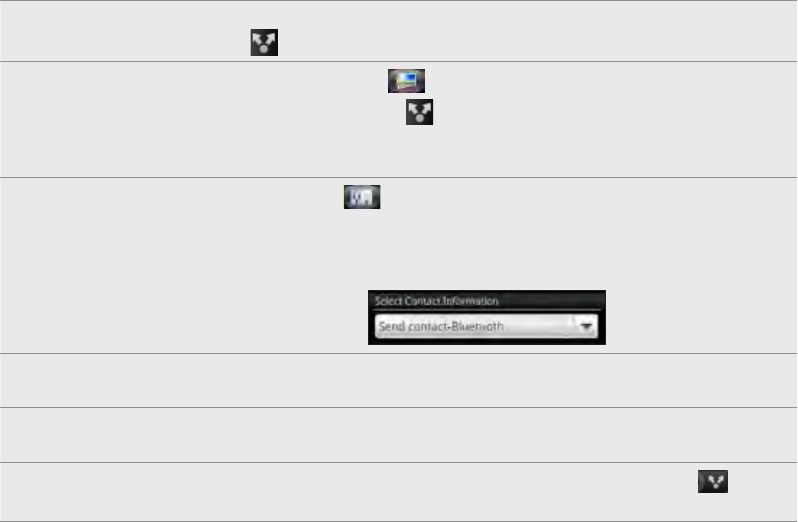
138 Bluetooth
From the Home screen, press MENU, and then tap Settings > Wireless &
networks > Bluetooth settings.
In the Bluetooth devices section, press and hold the device to unpair.
Tap Disconnect & unpair.
Or, tap Unpair if the Bluetooth device is currently not connected to your phone.
Sending information using Bluetooth
You can use Bluetooth to send information from your phone to another Bluetooth
enabled device such as a phone or notebook computer. You can send the following
types of information, depending on the device you are sending to:
Photos and videos
Calendar events
Contacts
Audio files
Before you begin, set the receiving device to discoverable mode. You may also need
to set it to “Receive Beams” or “Receive Files”. Refer to the device’s documentation for
instructions on receiving information over Bluetooth.
The first time you transfer information between your phone and another device, you
need to enter or confirm a security passcode. After that, your phone and the other
device are paired, and you will not need to exchange passcodes to transfer information
in the future.
1. On your phone, open the app that contains the information or file you want to
send.
2. Follow the steps for the type of item you want to send:
Captured photo
or video
After capturing, on the Camera preview screen, tap the Share
button , and then tap Bluetooth.
Photos or videos 1. On the Albums tab of the Gallery app, choose an album.
2. Tap the Share button , and then tap Bluetooth.
3. Choose the photos and videos you want to share, and then tap
Next.
Contact 1. On the All tab of the People app, press and hold a contact,
and then tap Send contact as vCard.
2. Tap the down arrow icon, and then select Bluetooth from the
displayed list.
Calendar event In Day view, Agenda view, or Week view, press and hold the event,
and then tap Share > Bluetooth.
Music track With the track displayed on the Music app’s Now playing screen,
press MENU, and then tap Share > Bluetooth.
Voice recording On the main Voice Recorder screen, tap the Share button , and
then tap Bluetooth.
1.
2.
3.

139 Bluetooth
3. Turn on Bluetooth if you’re asked to do so.
4. If you haven’t paired with the receiving device before, tap Scan for devices.
5. Tap the name of the receiving device.
6. If prompted, accept the pairing request on your phone and the receiving device.
Also enter the same passcode on both your phone and the other device, or
confirm the auto-generated passcode.
7. On the receiving device, accept the file.
Where sent information is saved
When you send information from your phone using Bluetooth, the location where it’s
saved depends on the type of information and the receiving device.
If you send a calendar event or contact, it is normally added directly to the
corresponding app on the receiving device. For example, if you send a calendar event
to a compatible phone, the event is shown in that phone’s calendar app.
If you send another file type to a Windows computer, it is normally saved in the
Bluetooth Exchange folder within your personal document folders.
On Windows XP, the path may be:
C:\Documents and Settings\[your username]\My Documents\Bluetooth
Exchange
On Windows Vista, the path may be:
C:\Users\[your username]\Documents
On Windows 7, the path may be:
C:\Users\[your username]\My Documents\Bluetooth Exchange Folder
If you send a file to another device, the saved location may depend on the file type.
For example, if you send an image file to another mobile phone, it may be saved in a
folder named “Images.”
Receiving information using Bluetooth
Your phone is capable of receiving a wide variety of file types with Bluetooth,
including photos, music tracks, and documents such as PDFs.
The first time you transfer information between your phone and another device, you
need to enter or confirm a security passcode. After that, your phone and the other
device are paired, and you will not need to exchange passcodes to transfer information
in the future.
To receive files using Bluetooth, you need to have a microSD card on your phone.
From the Home screen, press MENU, and then tap Settings > Wireless &
networks > Bluetooth settings.
If the Bluetooth check box is not selected, select it to turn Bluetooth on.
Select the Discoverable check box.
On the sending device, send one or more files to your phone. Refer to the
device’s documentation for instructions on sending information over Bluetooth.
1.
2.
3.
4.
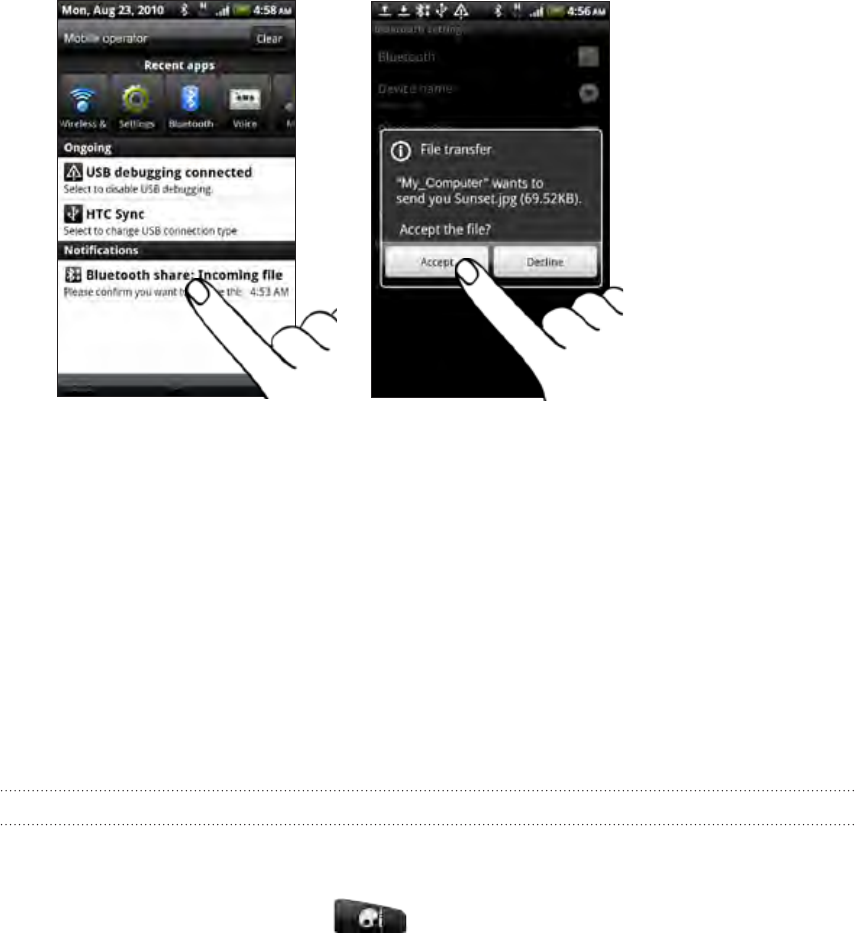
140 Bluetooth
5. If prompted, accept the pairing request on your phone and the receiving device.
Also enter the same passcode on both your phone and the other device, or
confirm the auto-generated passcode.
A Bluetooth authorization request is then displayed on your phone.
6. If you want to automatically receive files from the sending device in the future,
select the Always check box.
7. Tap Accept or OK.
8. When your phone receives a file transfer request notification, slide down the
Notifications panel, tap the incoming file notification, and then tap Accept.
9. When a file is transferred, a notification is displayed. To open the file immediately,
slide down the Notifications panel, and then tap the relevant notification.
When you open a received file, what happens next depends on the file type:
Media files and documents are usually opened directly in a compatible app.
For example, if you open a music track, it starts playing in the Music app.
For a vCalendar file, choose the calendar where you want to save the event,
and then tap Import. The vCalendar is added to your Calendar events. For
information on using Calendar, see the Calendar chapter.
For a vCard contact file, if there are multiple vCard files on your storage
card, you can choose to import one, several, or all of those contacts to your
contacts list.
Adding the Bluetooth received folder to the Home screen
You can add a folder to the Home screen that shows all files you have received with
Bluetooth.
From the Home screen, tap .
On the Personalize screen, tap Folder > Bluetooth received.
Press and hold the Bluetooth received folder icon, and drag it to the Home
screen position you want.
To view the folder contents, tap the folder icon. To open a file, tap the file name.
1.
2.
3.
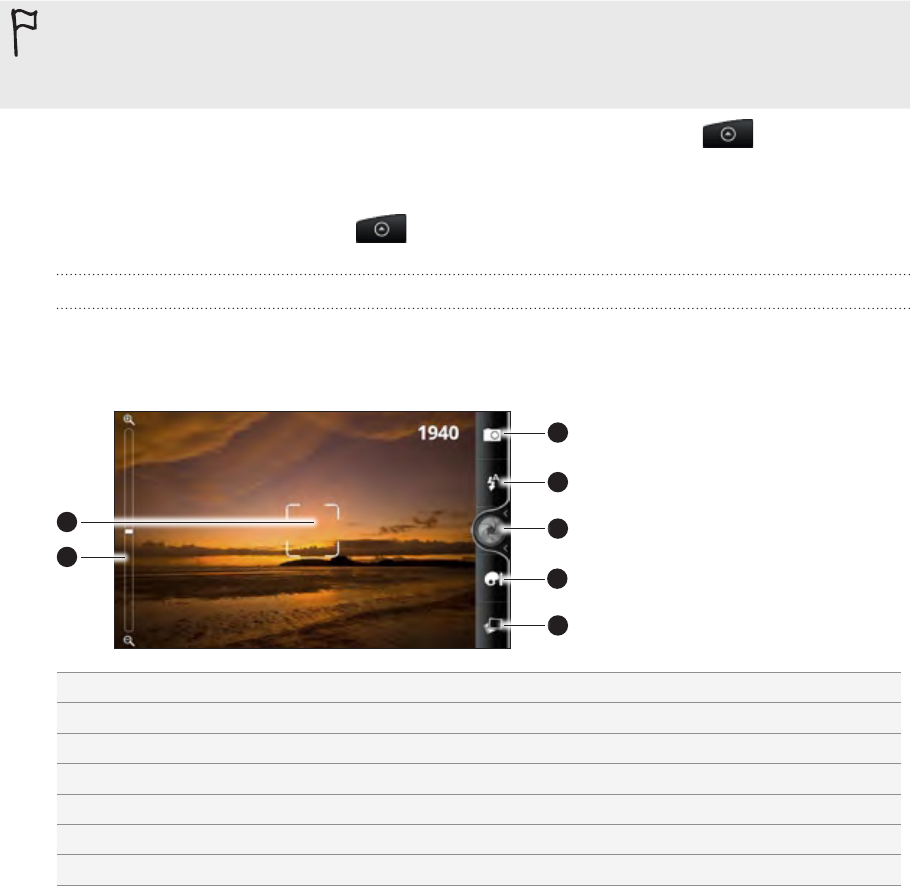
141 Camera
Camera
Camera basics
Whether traveling for business or fun, enjoy taking photos and videos of your trip and
encounters with your phone’s camera.
Be sure to plug in your microSD card before you use your phone’s camera. Photos and videosPhotos and videos
captured with the camera will be stored onto your microSD card.
If you have not yet inserted your microSD card to your phone, follow the steps in “Inserting the
storage card“ in the Basics chapter to insert it.
To open the camera in photo mode and take photos, tap from the Home
screen, and then tap Camera.
To open the camera directly in video mode so you can immediately start
capturing videos, tap from the Home screen, and then tap Camcorder.
Viewfinder screen
When you’re in photo mode and you turn your phone left or right, the camera
onscreen controls automatically rotate to how you hold the phone. You’ll find the
following onscreen controls on the Viewfinder screen:
3
5
2
6
7
1
4
1 Auto focus indicator See “Auto focusing.”
2 Zoom bar See “Zooming.”
3 Gallery button See the “Photos, videos, and music” chapter.
4 Effects See “Adding effects.”
5 Shutter release/Record button Tap to take a photo or start capturing video.
6 Flash button See “Taking a photo” and “Recording video.”
7 Mode button Tap to switch between photo and video modes.
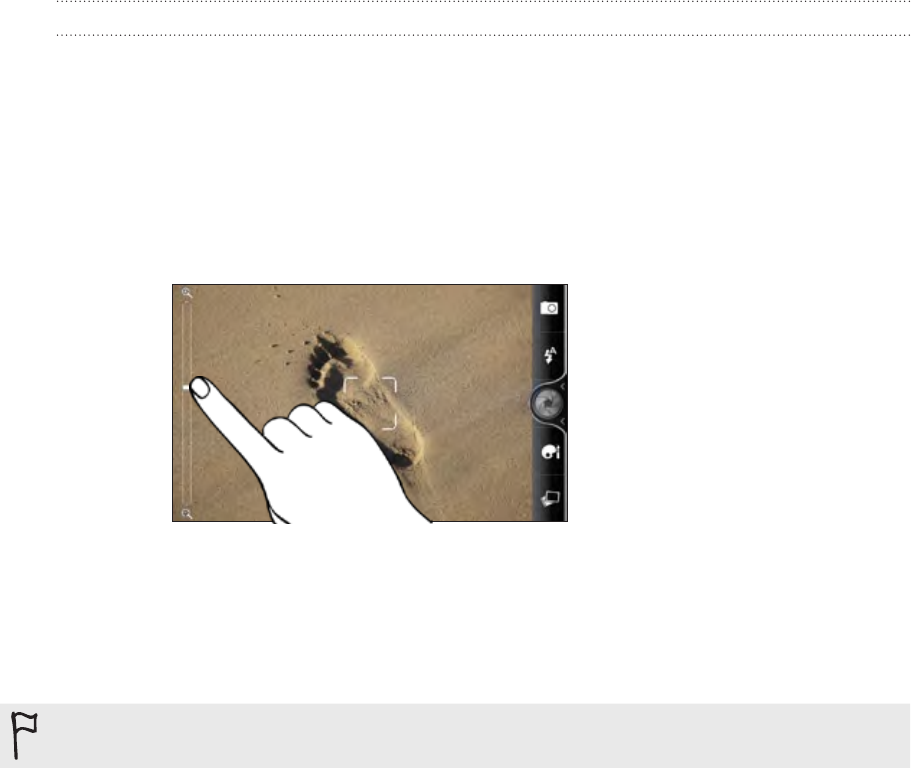
142 Camera
Zooming
Before taking a photo or video, you can first use the onscreen zoom bar to zoom in or
out of your subject.
When you’ve just opened the camera or switched between photo and video modes,
the zoom bar shows on screen for a few seconds. To display it again so you can zoom,
do the following:
Tap anywhere on the Viewfinder screen. Then slide your finger across the
zoom bar to zoom in or out.
In photo mode, tapping on the Viewfinder screen moves the focus to your
tapped area. To avoid moving the focus, press the VOLUME UP or VOLUME
DOWN button to zoom.
When you’re recording video, the zoom bar is always shown onscreen. You can freely
zoom in or out while recording.
If you choose 720p HD resolution for video recording, there’s no zooming available.
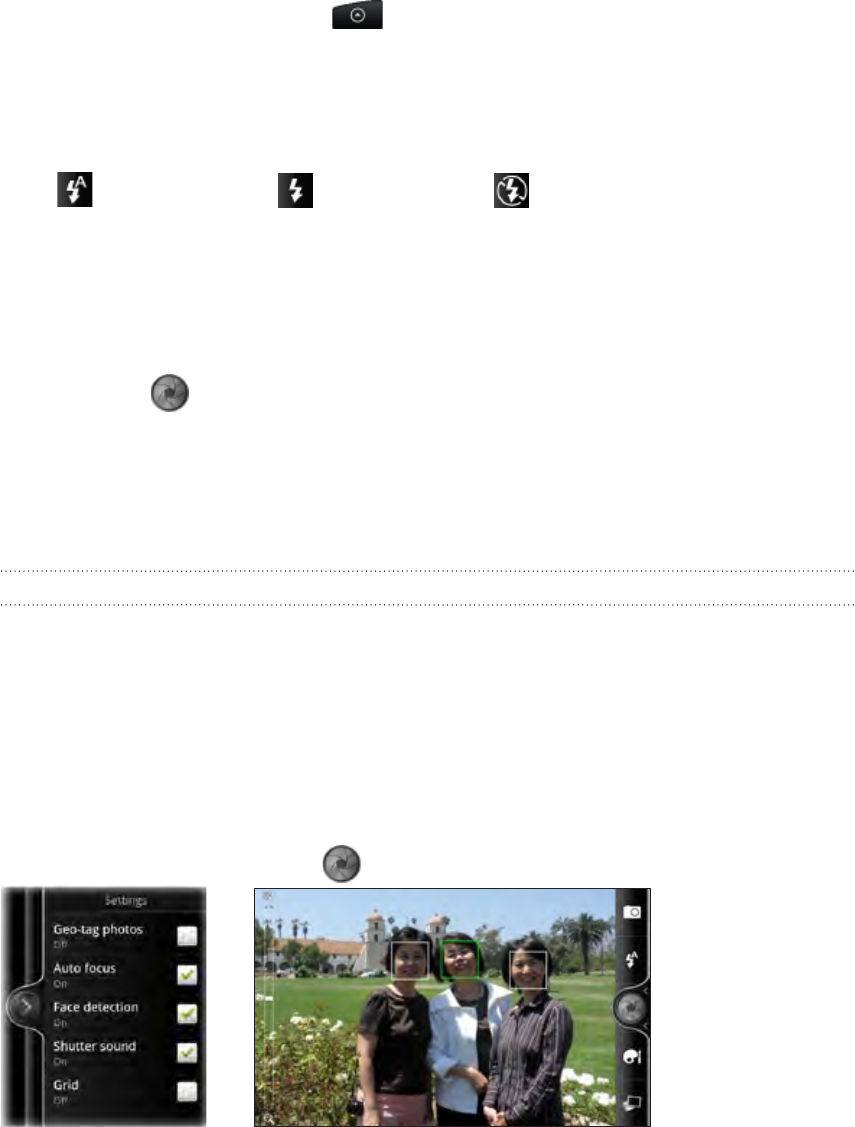
143 Camera
Taking a photo
1. From the Home screen, tap > Camera.
2. Before taking the photo, you can zoom in or out first on your subject. To find out
how, see “Zooming”.
3. Tap the Flash button repeatedly to choose a flash mode depending on your
lighting conditions.
Auto flash Flash on Flash off
4. Choose the resolution and other camera settings you want to use. See
“Changing camera settings” for details.
5. You can choose an effect to apply to your photo. See “Adding effects” for
details.
6. Point the camera and focus on your subject. See “Auto focusing” for details.
Then tap to take the photo.
You can also set the camera to automatically take a photo without the need for
you to tap the shutter release button. See “Auto capturing” for details.
7. Choose what you want to do with the photo you’ve just taken. See “After
capturing“ for details.
Auto focusing
Whenever you point the camera at a different subject or location, it shows the auto
focus indicator at the center of the Viewfinder screen.
Let the camera auto focus on the center of the screen. Or you can tap another area on
the screen that you want to focus on.
Face detection
If you turn Face detection on in the camera settings, the camera will automatically
recognize faces and adjust the focus when you’re taking photos of people. When you
see boxes on people’s faces, tap to take the photo.
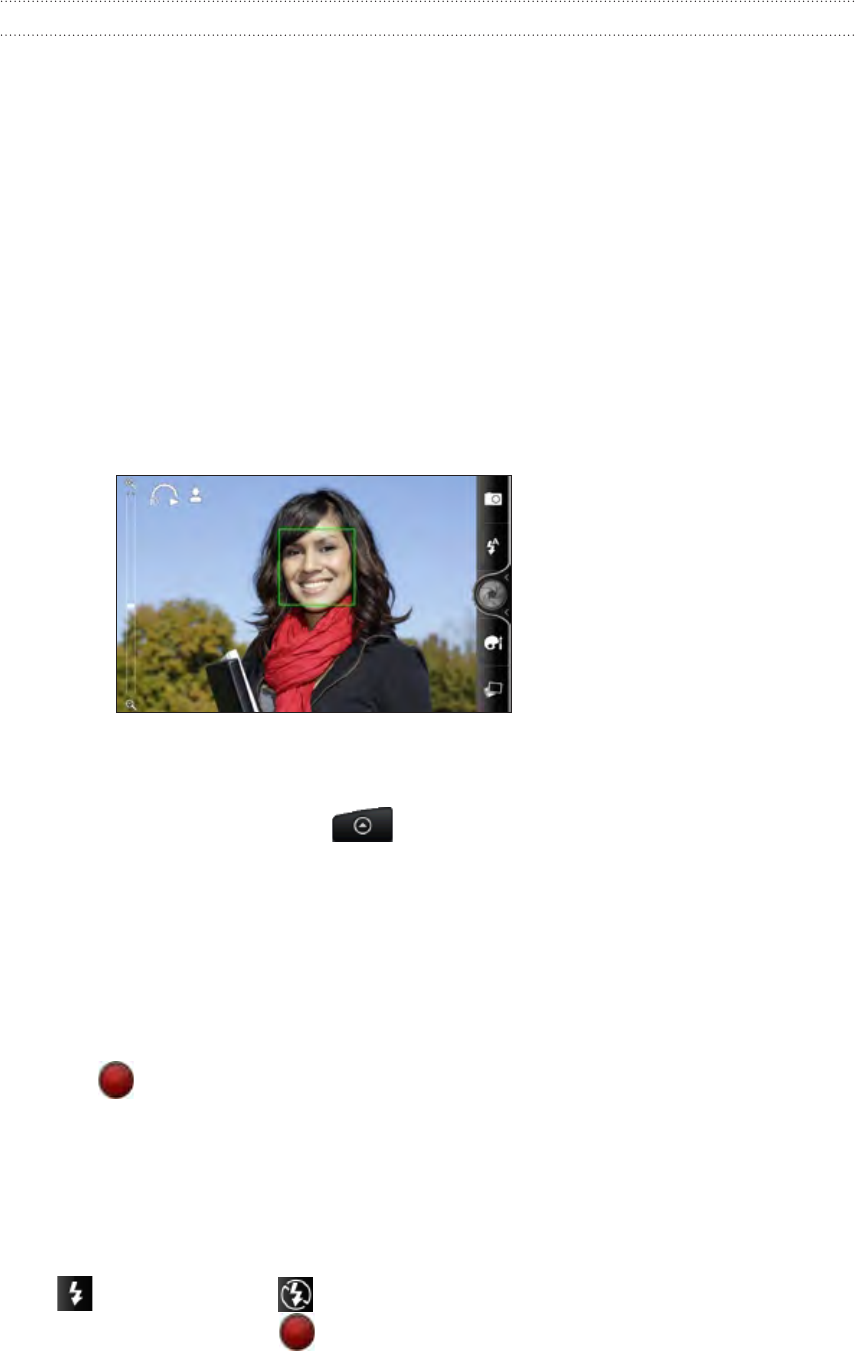
144 Camera
Auto capturing
If you set the camera to use face detection, self-timer, or both to automatically
capture, you won’t need to tap the shutter release button when taking photos.
1. Open the settings menu panel. To find out how, see “Changing camera settings.”
2. Tap Auto capture.
3. Choose whether you want the camera to identify 1 or 2 faces of people in the
shot.
4. To set a time delay before the camera takes the shot, set the timer to 2 or 10
seconds.
5. Press MENU to close the settings menu panel.
6. Point the camera at your subjects. Use the onscreen zoom bar if you need to
zoom in or out. See “Zooming” for details.
The camera focuses and automatically takes the photo.
Recording video
1. From the Home screen, tap > Camcorder.
2. Choose the video quality and other camera settings you want to use. See
“Changing camera settings” for details.
To record video in HD, set video quality to HD 720P. Or for sharing on the Web,
select Online (HD).
3. You can choose an effect to apply to your video. See “Adding effects” for details.
4. Frame your subject on the Viewfinder screen.
5. Tap to start recording.
6. You can freely zoom in or out while recording video. To find out how, see
“Zooming”.
7. You can change focus to a different subject or area by just tapping it on the
Viewfinder screen.
8. Tap the Flash button to switch the camera light on or off during recording.
Light on Light off
9. To stop recording, tap again.
10. Choose what you want to do with the video you’ve just recorded. See “After
capturing“ for details.

145 Camera
Camera flash doesn’t turn on?
The camera flash uses much battery power. To save battery power, the camera
disables it (even when it’s set on) when one of the following occurs:
You have an incoming call
The camera flash will be disabled temporarily when you have an incoming call.
After the call ends, you’ll be able to use it again.
If you have set the flash to Auto flash or Flash on in photo mode or Light on in
video mode, it turns back on after you answer and end the call.
Your phone’s battery level reaches 15% or lower
Recharge the battery so that the camera can have enough battery power to use
the flash.
Cold weather may lower battery performance which affects the flash
To make sure the camera has enough battery life to power up the flash, keep
your phone warm. When not in use, put the phone inside your jacket to keep
it warm, and try to avoid sudden temperature changes that may affect battery
performance.
Adding effects
Want to make your photos look more interesting? Easy. Use the available camera
effects to make your photos look like they’ve been taken through special lenses and
filters. You can also add certain effects to videos.
Choose an effect first before you start taking a photo or video. Just tap . Then
scroll through the available effects and tap one that you like.
When you choose certain photo effects such as depth of field, distortion, or vignette,
drag the bar that appears on the right side of the screen to adjust the intensity of the
effect.
After capturing
After capturing a photo or video, the Review screen will display the photo or the
starting image of the video that you have just captured. Tap the onscreen buttons to
choose what you want to do next.
Camera. Return to the Viewfinder screen.
Delete. Delete the photo or video.
Share. Send the photo or video to another phone or your computer using Bluetooth,
send it by email, or select a social network where you want to upload it to.
Set as. Set the photo as a contact picture or your wallpaper.
Play. Watch the video.

146 Camera
Changing camera settings
Open the menu panel to access and change camera settings. To open it, just press
MENU.
Scroll through the menu panel and choose the settings that you want.
Image adjustments Slide your finger across each of the slider bars to adjust the
exposure, contrast, saturation, and sharpness.
White balance White balance enables the camera to capture colors more
accurately by adjusting to your current lighting environment.
White balance settings include: Auto, Incandescent, Fluorescent,
Daylight, and Cloudy.
Auto capture
(photo mode only)
Set the camera to use face detection, self-timer, or both to
automatically take photos without the need for you to tap the
shutter release button.
Resolution/Video quality Choose a photo or video resolution to use.
ISO (photo mode only) You can choose an ISO level or set it back to Auto. Higher ISO
numbers are better for taking pictures in low light conditions.
Review duration Set the time for a captured photo or video to be displayed on the
Review screen before the camera changes back to the Viewfinder
screen.
Widescreen
(photo mode only)
When this check box is selected (default), photo resolutions
available for selection are in 5:3 ratio and you can use the entire
Viewfinder screen to frame your subject. When not selected,
photo resolutions available for selection are in standard 4:3 ratio.
Geo-tag photos
(photo mode only)
Select this check box when you want to store GPS location in
your captured photos.
Auto focus This option enables or disables centered auto focus. Auto focus is
enabled by default.
Face detection
(photo mode only)
This option allows the camera to automatically recognize
faces and adjust the focus when you take people photos. Face
detection will be turned off if you disable auto focus.
Shutter sound Select or clear this check box, depending on whether you want
the camera to play a sound when you press the shutter release or
record button.
Grid (photo mode only) Select this check box when you want to display a grid on the
Viewfinder screen so you can easily frame and center your
subject before taking the photo.
Record with audio
(video mode only)
Select or clear the check box, depending on whether you want to
record audio when capturing videos.
Reset to default Change the camera back to default settings.
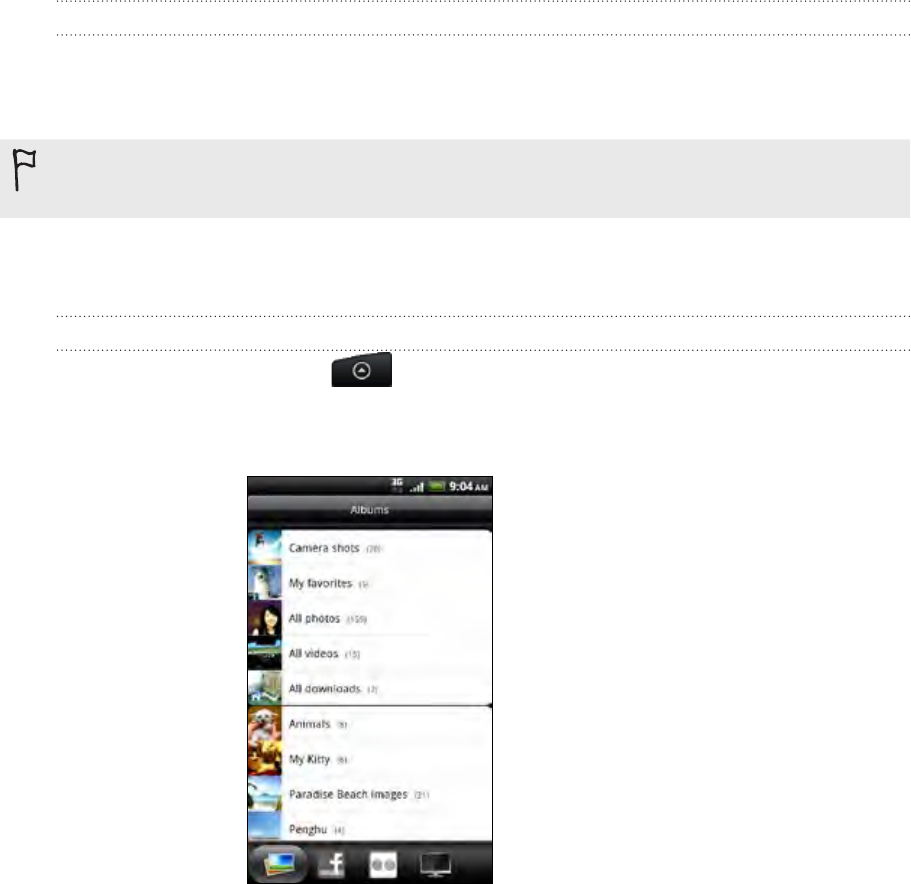
147 Photos, videos, and music
Photos, videos, and music
Browsing your Gallery
About the Gallery app
Relive the fun while viewing photos and videos of your latest travels or your pet’s
newest tricks. Get an audience by tagging your Facebook and Flickr friends. You can
even play your media on a TV screen.
To start using Gallery, check first if you have photos or videos copied on your storage card.
To find out how to copy files, see “Copying files to or from the storage card” in the Getting
started chapter.
What’s more, you can edit and add effects to your photos. You can also easily turn a
photo as your contact icon, location icon, or wallpaper.
Selecting an album
From the Home screen, tap , and then tap Gallery.
The Gallery app opens in the Albums screen where your photos and videos are
organized by albums for easy viewing.
The following are preset albums:
Camera shots lets you view photos and videos that are stored in the camera’s
folder.
Photos and videos that you set as your favorites will be grouped under My
favorites.
All photos lets you view all photos that are stored in all the folders on the
storage card.
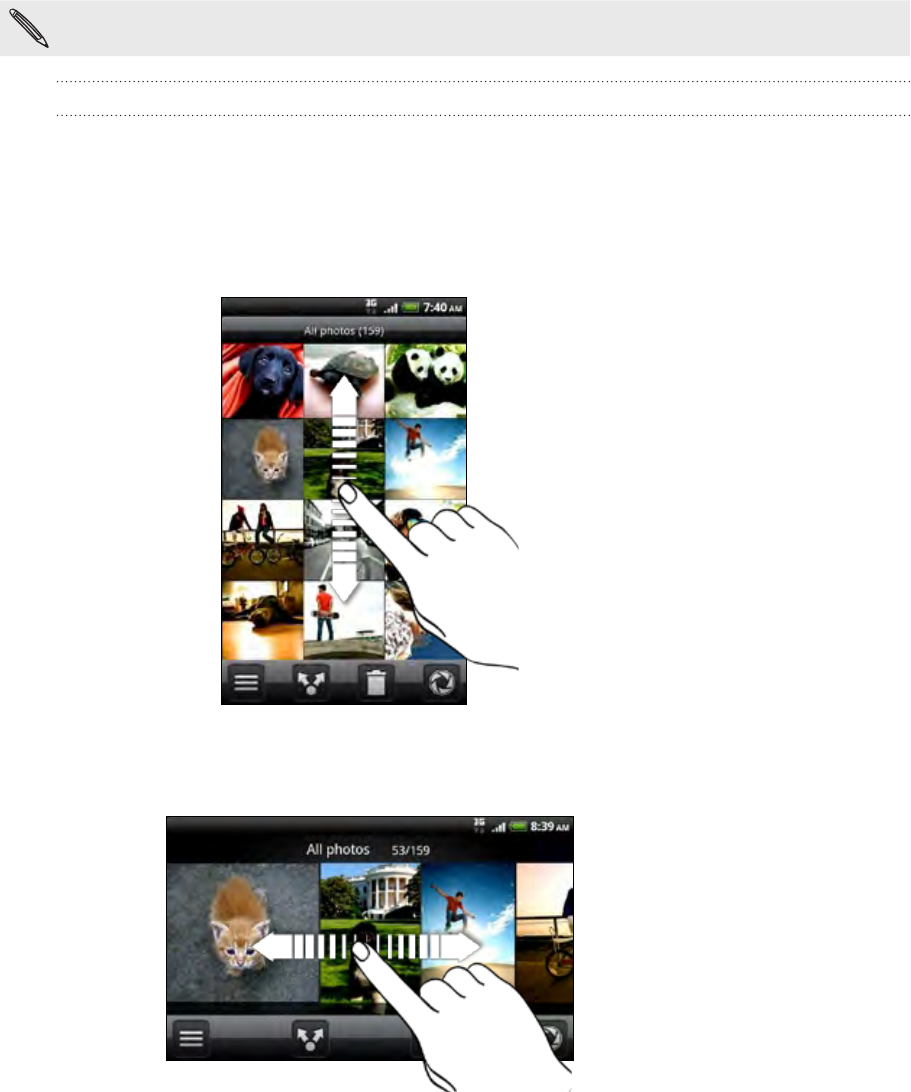
148 Photos, videos, and music
All videos lets you view all videos that are stored in all the folders on the
storage card.
All downloads lets you view photos and videos that you downloaded.
Folders in your storage card that contain photos and videos will also be treated as
albums and will be listed below the preset albums. The actual folder names will be
used as the album names.
Simply tap an album to view the photos and/or videos in that album.
If there are photos or videos under the root path of your storage card (that are not contained
in folders), they will be grouped under the Other album.
Viewing photos
After you’ve selected an album, you can browse through your photos and videos.
Depending on how you hold your phone, the screen automatically switches to either
grid view or filmstrip view:
While in grid view, slide your finger up or down to scroll through the
thumbnails. Tap a photo or video to view it in full screen.
While in filmstrip view (when you turn your phone sideways), slide your finger
left or right across the screen to go through your photos and videos. Tap a
photo or video to view it in full screen.
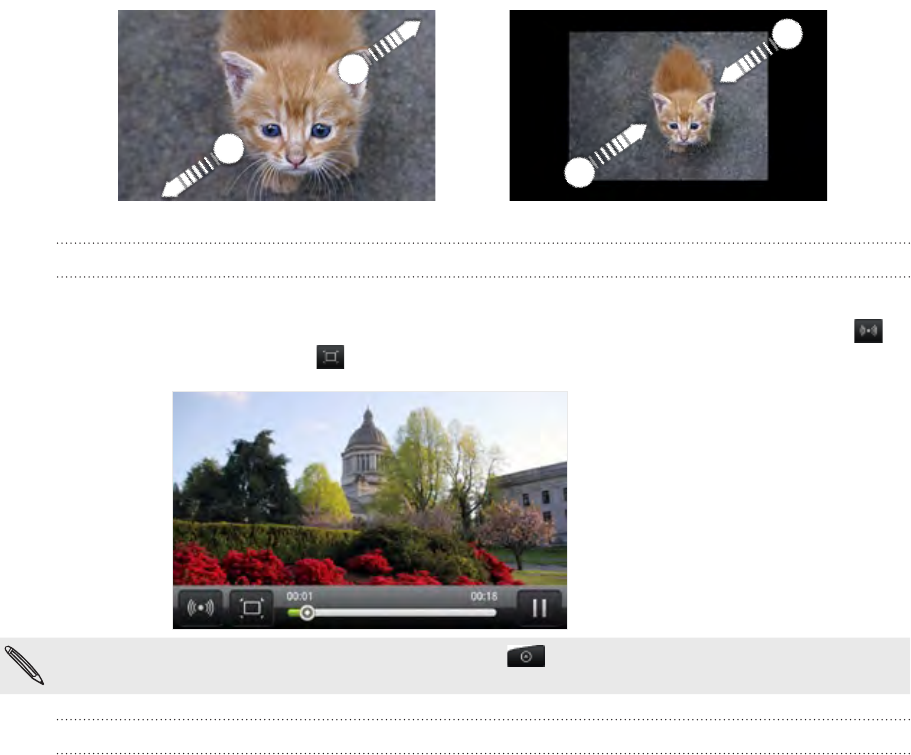
149 Photos, videos, and music
Zooming in or out on a photo
There are two ways you can zoom in or out of a photo:
Tap the screen twice quickly to zoom in, then tap the screen twice quickly
again to zoom out.
You can also use pinch zooming. Press your thumb and index finger on the
screen and then spread your fingers apart to zoom in. Pinch your fingers
together to zoom out.
Viewing videos
Video is always displayed in landscape mode when you play it. Use the onscreen
controls to play, pause, or stop the video. For an enhanced audio experience, tap to
turn on Dolby or SRS. Tap to toggle between full and best-fit screens.
Another way to easily get to your videos is to tap from the Homescreen, and then tap
Videos.
Editing your photos
Do basic editing tasks on your photos such as rotate and crop. You can also enhance
your photos by applying effects such as high contrast, vintage, and more.
Rotating a photo
On the Gallery app’s Albums screen, tap an album.
Press and hold on the photo that you want to rotate.
In the menu that opens, tap Edit, and then tap either Rotate left or Rotate right.
Cropping a photo
On the Gallery app’s Albums screen, tap an album.
Press and hold on the photo that you want to crop.
1.
2.
3.
1.
2.

150 Photos, videos, and music
In the menu that opens, tap Edit, and then tap Crop. You’ll see a crop box around
the photo.
4. To adjust the crop box size, press and hold the edge of the box. When directional
arrows appear, drag your finger inward to or outward to resize the crop box.
5. To move the crop box to the part of the photo that you want to crop, drag the
crop box to the desired position.
6. Tap Save to keep the changes.
The cropped photo is saved in the storage card as a copy. The original photo
remains unedited.
Adding effects
1. On the Gallery app’s Albums screen, tap an album.
2. Press and hold on the photo that you want to add effects to.
3. In the menu that opens, tap Edit, and then tap Effects. You’ll see options
available to you on the top panel.
4. Tap an effect to apply on the photo.
5. Tap Save to keep the changes.
The enhanced photo is saved in the storage card as a copy. The original photo
remains unedited.
Sending your photos and videos
Send photos and videos via email or MMS. You can also send them to another phone
or your computer using Bluetooth.
Sending photos or videos by email
You can send several photos, videos, or both in an email message. They are added as
file attachments in your email.
From the Home screen, tap , and then tap Gallery.
Tap the album where the photos or videos you want to share are in.
Tap , and then tap Gmail or Mail.
Select the photos or videos you want to share and then tap Next.
Compose your message and then tap Send.
If you selected Mail and you have multiple email accounts, the default email account will be
used.
3.
1.
2.
3.
4.
5.

151 Photos, videos, and music
Sending a photo or video by MMS
From the Home screen, tap , and then tap Gallery.
Tap the album where the photo or video you want to share is in.
Tap , and then tap Messages.
Tap the photo or video you want to send.
The photo or video is automatically added into the MMS message.
Compose your message and then tap .
Sending photos or videos using Bluetooth
You can select several photos, videos, or both and send them to someone’s phone or
your computer using Bluetooth.
From the Home screen, tap , and then tap Gallery.
Tap the album where the photos or videos you want to share are in.
Tap , and then tap Bluetooth.
Select the photos or videos you want to share and then tap Next.
In the next few steps, you’ll be asked to turn on Bluetooth on your phone and
connect to the receiving Bluetooth device so the files can be sent. Follow the
steps in “Sending information using Bluetooth” in the Bluetooth chapter
Sharing your photos and videos on the Web
Using the Gallery app, you can share photos and videos on your social networks, as
well as post videos on YouTube.
You can also use the Camera or Camcorder app to share a photo or video right after
you’ve captured it. See the Camera chapter.
Sharing photos or videos on Facebook
You need to be logged in to your Facebook account to be able to upload photos or
videos.
From the Home screen, tap , and then tap Gallery.
Tap the album where the photos or videos you want to share are in.
Tap , and then tap Facebook for HTC Sense.
Select the photos or videos you want to share and then tap Next.
Enter a different caption on each photo or video.
You can also tag friends on your photos. Tap Tag this photo, and then tap the
part where your friend is. From the list that shows, select who you want to tag.
1.
2.
3.
4.
5.
6.
1.
2.
3.
4.
5.
1.
2.
3.
4.
5.

152 Photos, videos, and music
6. Slide to the left to go to the next photo or video.
7. Tap Upload.
8. Select which album to upload to and set privacy settings for the uploaded
photos or videos.
9. Tap Done.
Sharing photos or videos on Flickr
You need to be logged in to your Flickr account to be able to upload photos or videos.
From the Home screen, tap , and then tap Gallery.
Tap the album where the photos or videos you want to share are in.
Tap , and then tap Flickr.
Select the photos or videos you want to share and then tap Next.
Enter a different title and description on each photo or video.
You can also tag friends on your photos. Tap Tag this photo, and then tap the
part where your friend is. From the list that shows, select who you want to tag.
6. Slide to the left to go to the next photo or video.
1.
2.
3.
4.
5.

153 Photos, videos, and music
7. Tap Upload.
8. Select which album to upload to and set privacy settings for the uploaded
photos or videos.
9. Tap Done.
Sharing photos on Picasa
You need to be signed in to a Google Account to be able to upload photos to the
Picasa™ photo organizing service.
From the Home screen, tap , and then tap Gallery.
Tap the album where the photos you want to share are in.
Tap , and then tap Picasa.
Select the photos you want to share and then tap Next.
Enter a caption for the photos you’re uploading.
Select the online album where you want to upload the photos, or tap to
create a new album.
Tap Upload.
You can view the photos online at http://picasaweb.google.com.
Sharing videos on YouTube
You can share your videos by uploading them to YouTube™. Please sign in to your
YouTube or Google Account, if you’re asked to do so.
From the Home screen, tap , and then tap Gallery.
Tap the album where the videos you want to share are in.
Tap , and then tap YouTube.
Select the videos you want to share and then tap Next.
Enter a title for the videos you’re uploading.
Tap More details and enter the prompted information, such as description and
tags, and select a privacy option.
Tap Upload.
1.
2.
3.
4.
5.
6.
7.
1.
2.
3.
4.
5.
6.
7.

154 Photos, videos, and music
Viewing photos in your social networks
Right on the Gallery app, check what you and your friends have uploaded to your
social networks (Facebook and Flickr only).
Viewing photos on Facebook
You need to be logged in to your Facebook account to view Facebook photos.
From the Home screen, tap , and then tap Gallery.
Tap the Facebook tab.
Tap your account name or your friend’s account on the list to view the photos in
the account.
You can view photos in your online albums the same way as how you view
photos in your storage card.
Viewing photos on Flickr
You need to be logged in to your Flickr account to view Flickr photos.
1. From the Home screen, tap , and then tap Gallery.
2. Tap the Flickr tab.
You may be asked to give authorization for the app to connect to the Flickr
website. If this happens, you need to give authorization to access your Flickr
account.
3. Tap your account name or your friend’s account on the list to view the photos in
the account.
You can view photos in your online albums the same way as how you view
photos in your storage card.
Commenting photos in your social networks
Add comments to your uploaded photos as well as your friends’.
1. Do one of the following:
While browsing online albums, press and hold a photo and then tap Add
comment.
While viewing a photo in full screen, tap anywhere on the screen, and then
tap .
2. Tap the box that says “Write a comment.”
3. Enter your text, and then tap Comment.
1.
2.
3.
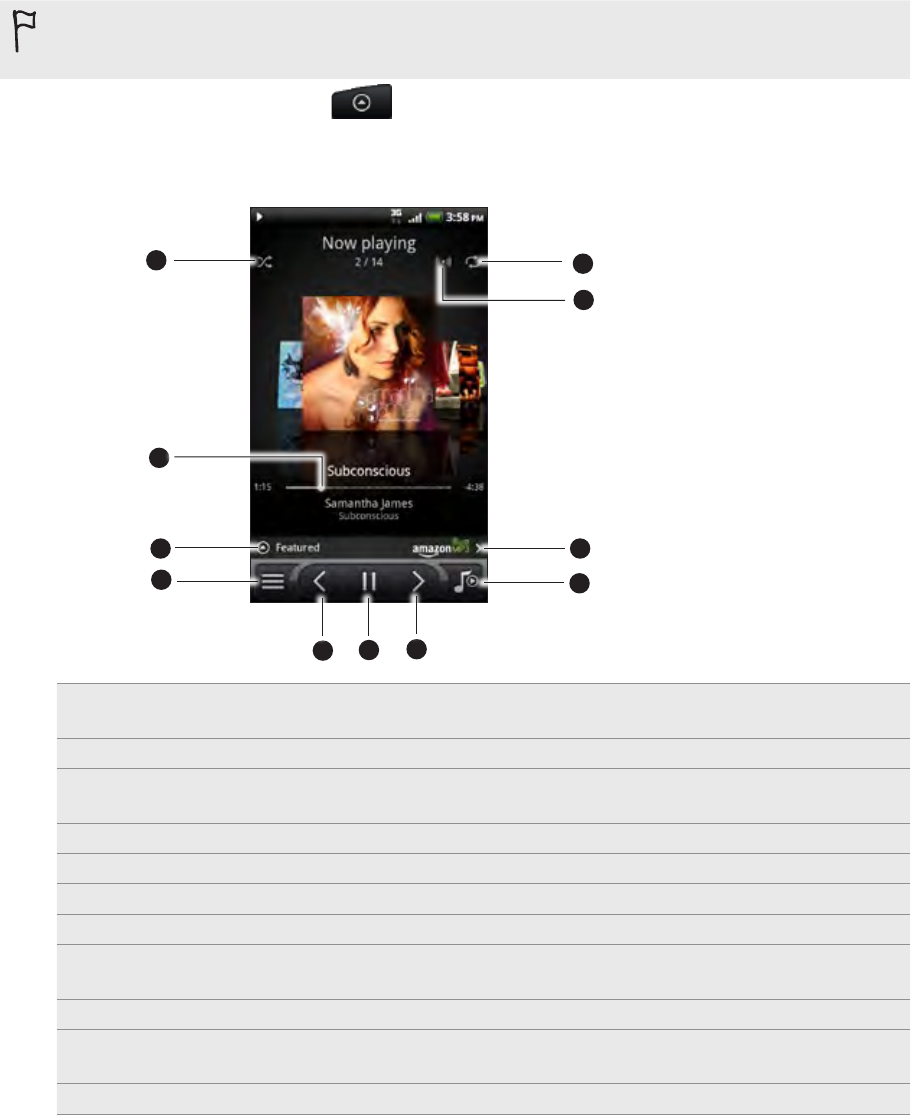
155 Photos, videos, and music
Listening to music
Enjoy listening to songs and music on your phone using the Music app.
You need to copy music files to your storage card first to use the Music app to play music.
To find out how to copy files, see “Copying files to or from the storage card” in the Getting
started chapter.
From the Home screen, tap , and then tap Music.
The Music app opens in the Playback screen. Tap the onscreen icons to control music
playback, select a song to play, repeat songs, and more.
2
56
1
7
8
4
11
3
10
9
1 Turn shuffle on or off.
(Shuffle is off when button is gray.)
2 Press and drag your finger across the progress bar to jump to any part of the song.
3 Tap to check out featured albums from HTCSense.com. (Availability depends on your
country.)
4 Go to the Library.
5 Go to the previous song in the Now playing list.
6 Play, pause, or resume playing the song.
7 Go to the next song in the Now playing list.
8 Switch between showing the Now playing list and Playback screen. You can rearrange
songs in the Now playing list.
9 Buy songs from the Amazon music store. (Availability depends on your country.)
10 Get that surround sound feeling. Choose between Dolby and SRS. Or, if you’re using a
headset, you can also choose from various preset equalizer settings.
11 Cycle through the repeat modes: Repeat all songs, Repeat current song, and Don’t repeat.

156 Photos, videos, and music
When you’re listening to music and the screen turns off, press POWER to turn the
screen back on and control the music playback directly on the Lock screen.
If you don’t see the playback controls on the Lock screen, tap anywhere on the screen
to display them.
You can also pause music playback right from the Notifications panel. To find out how
to open the Notifications panel, see the Getting started chapter.
Flipping through your albums
Swipe your finger left or right across the screen to go to the next or previous music
album.
When you turn your phone sideways to the left, you get a wider view of your screen
and can skim through your albums with more ease.
If you have lots of albums, flick left or right across the screen to quickly skim
through them.
To look at one album at a time, slide your finger left or right.
Tap to see the song list of the current album.
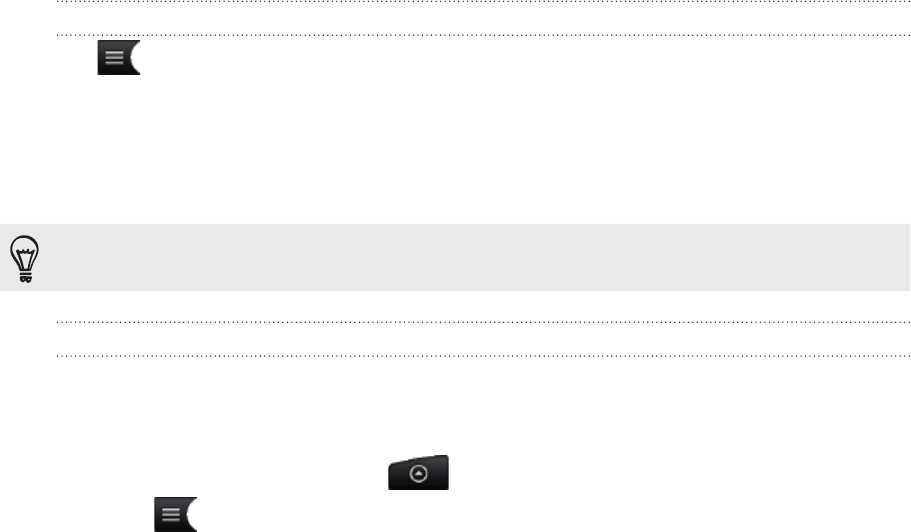
157 Photos, videos, and music
Browsing music in the Library
Tap on the Music app’s Playback screen or Now playing list to go to the Library.
In the Library, your music is organized by categories such as artists and albums.
Choose a category by tapping one of the tabs at the bottom of the screen.
When you tap a song in a category to play it, the Now playing list is updated with the
song list from your selected category.
You can add, remove, or rearrange the tabs in the Library. To find out how, see “Rearranging or
hiding application tabs” in the Personalizing chapter.
Creating a playlist
Personalize your music experience by creating music playlists. Make a playlist
containing just your favorite songs or create one to match your mood for the day. You
can make as many playlists as you like.
From the Home screen, tap , and then tap Music.
Tap to go to the Library.
In the Library, tap or slide your finger on the bottom row to go to the Playlists
category.
Tap Add playlist.
Enter a playlist name, and then tap Add songs to playlist.
Choose a category. If you go to the Songs category, you can see a complete list
of songs on your storage card.
Select the check boxes of songs you want to add to the playlist and then tap
Add.
Tap Save.
Playing the songs in a playlist
In the Library, tap or slide your finger on the bottom row to go to the Playlists
category.
Tap a playlist to open it.
Tap the first song or any song in the playlist.
When you tap a song in the list to play it, the Now playing list is updated with
the songs from your playlist.
Managing playlists
After creating a playlist, you can add more songs to it, rearrange their order, and more.
In the Library, tap or slide your finger on the bottom row to go to the Playlists
category.
Tap a playlist to open it.
1.
2.
3.
4.
5.
6.
7.
8.
1.
2.
3.
1.
2.

158 Photos, videos, and music
Press MENU, and then choose what you want to do:
Add more songs to a
playlist
Tap Add songs.
Go to the Songs category or any other category.
Select the songs you want to add to the playlist and then
tap Add.
1.
2.
3.
Rearrange songs Tap Change order.
Press and hold at the end of the song title you want
to move. When the row is highlighted, drag it to its new
position, then release.
Tap Done.
1.
2.
3.
Delete songs from a
playlist
Tap Remove songs.
Select the songs you want to delete and then tap
Remove.
1.
2.
Change playlist name Tap Rename playlist.
Deleting playlists
In the Library, tap or slide your finger on the bottom row to go to the Playlists
category.
Press MENU and then tap Delete playlists.
Select the playlists to delete and then tap Delete.
Setting a song as ringtone
You can choose a song from the Music app’s Library and set it as your phone’s
ringtone or a ringtone for a certain contact.
From the Home screen, tap , and then tap Music.
Tap to go to the Library.
In the Library, choose the song that you want to use as ringtone and then play it
back.
On the Playback screen, press MENU and then tap More > Set as ringtone.
If you chose an MP3 song, you can trim it first and set the part that you trimmed
as the ringtone. See “Trimming an MP3 ringtone.”
In the Set as ringtone options menu, tap Phone ringtone or Contact ringtone.
If you select Contact ringtone, you need to choose the contacts you want to
associate the song with in the next screen.
3.
1.
2.
3.
1.
2.
3.
4.
5.
6.
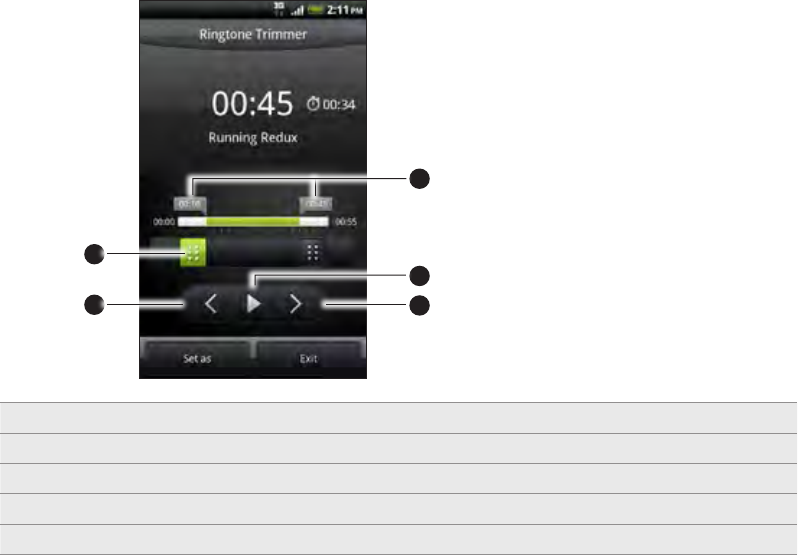
159 Photos, videos, and music
Trimming an MP3 ringtone
The Music app has a built-in ringtone trimmer. You can trim an MP3 song and set a
part of it as your ringtone.
1. On the Playback screen, press MENU, and then tap More > Set as ringtone >
Trim the ringtone.
2. Use the onscreen controls to trim your ringtone.
23
4
5
1
1 Trim sliders
2 Left button
3 Right button
4 Play/Pause button
5 Markers. (These show where the ringtone starts and ends.)
To trim, you can:
First drag the two trim sliders approximately to the part where you want the
ringtone to begin and end.
Then tap the right and left arrow buttons to more precisely set the start and
end points of the ringtone.
3. After you’ve finished trimming, tap Set as. Then choose whether to set the
trimmed song as your Phone ringtone or Contact ringtone.
Checking if the song was added as a ringtone
From the Home screen, press MENU and then tap Settings.
On the Settings screen, tap Sound > Phone ringtone. The song should be in the
ringtone list and selected.
1.
2.

160 Photos, videos, and music
Sharing music using Bluetooth
You can choose a song from the Music app’s Library and send it to someone’s phone
or your computer using Bluetooth.
From the Home screen, tap , and then tap Music.
Tap to go to the Library.
In the Library, tap the song that you want to share.
On the Playback screen, press MENU and then tap Share > Bluetooth.
In the next few steps, you’ll be asked to turn on Bluetooth on your phone and
connect to the receiving Bluetooth device so the music can be sent. Follow the
steps in “Sending information using Bluetooth” in the Bluetooth chapter.
Finding music videos in YouTube
You can find music videos of the song you’re listening to in YouTube.
It’s simple. On the Playback screen, just press MENU and then tap Find videos.
About the Music widget
You can use the Music widget to play music right from your Home screen. To find out
how you can add this widget to your Home screen, see “Personalizing your Home
screen with widgets” in the Personalizing chapter.
1.
2.
3.
4.
5.
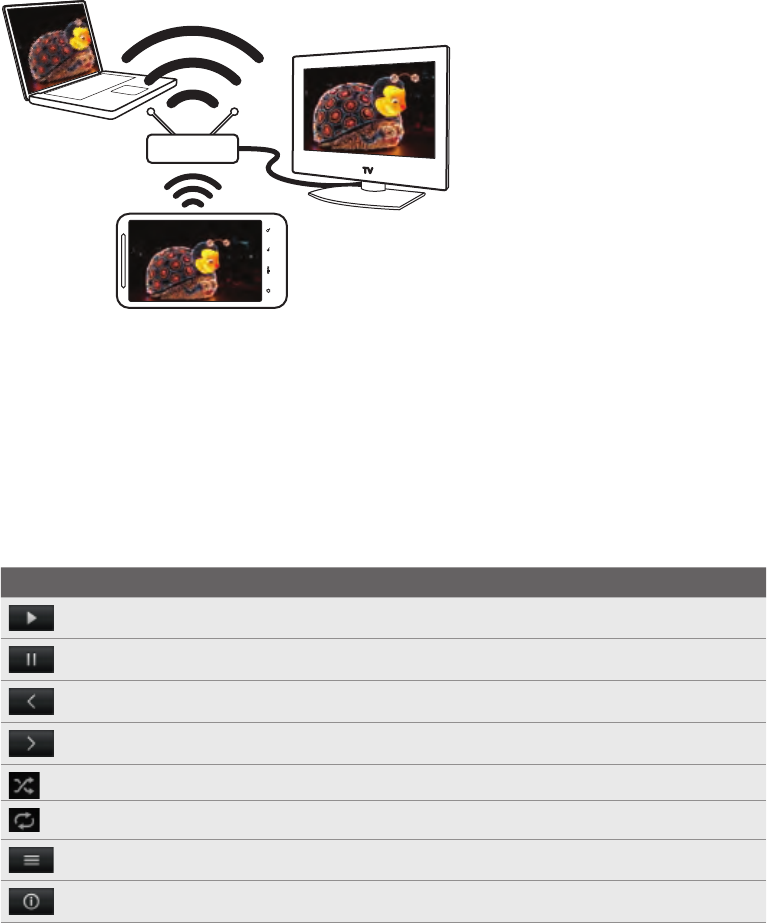
161 Photos, videos, and music
Sharing media on your home network
Sharing photos, videos, and music with a bigger circle of friends is easy on your home
network. Simply connect your phone to the network and instantly show your captured
photos and videos on a big TV, or start streaming your favorite music tracks on hi-fi
speakers — all via DLNA™. For more information about DLNA, visit www.dlna.org.
Before you share media through the network:
Connect your phone to the network via Wi-Fi. To find out how to connect to a
Wi-Fi network, see the Internet chapter.
Connect the TV or speakers to the network. Check the documentation that
came with your TV or speakers to know how.
1. Open the Gallery or Music app.
2. Locate the media that you want to share, and then tap it.
3. While viewing the photo or playing the video or music, press MENU, and then
tap Select player.
4. Choose the device on your network where you want to play the media.
5. Once connected to the other device, your phone opens up the Controller screen
where you can tap:
Controls To
Play the media on the other device.
Pause the music or video playback.
Play the previous photo or music track.
Play the next photo or music track.
Shuffle your music playlist.
Select a repeat mode for photos or music tracks.
Show available media that you can share.
View the media information such as the file name, title, and duration.
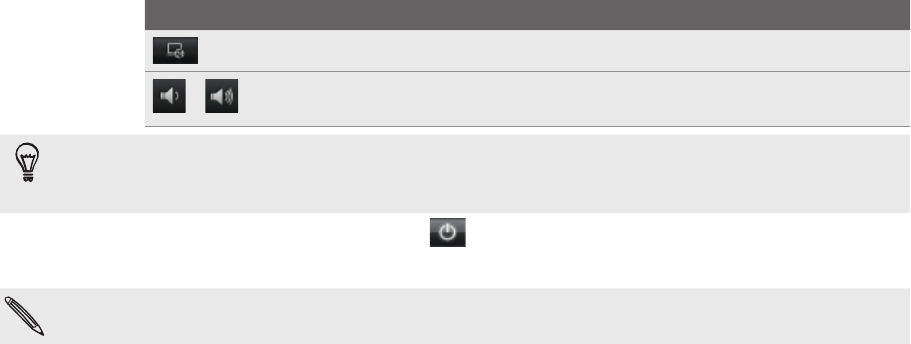
162 Photos, videos, and music
Controls To
Connect to another device on the network.`
/ Adjust the volume of the video or music you’re playing on the other
device. You can also drag the volume slider to adjust the volume.
While playing a media on another device, you can press BACK and do other things on your
phone. To return to the Controller screen, slide open the Notifications panel, and then tap the
device you’re connected to.
6. To stop sharing your media, tap to disconnect your phone from the other
device.
Until you disconnect the phone from the other device, other media that you open from the
Gallery or Music app are shared on the other device.
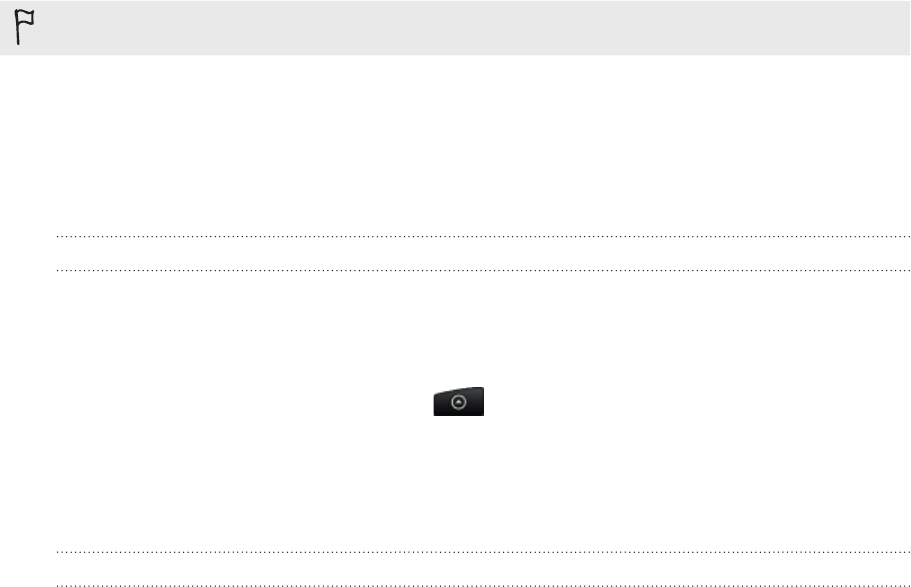
163 HTCSense.com
HTCSense.com
About HTCSense.com
The HTC Sense experience has now extended from the phone to the Web. Without
physically connecting the phone to the computer, you can communicate with your
phone through the computer’s web browser. Go to HTCSense.com to personalize your
phone, manage contacts, read, send, and search text and MMS messages, create and
share Footprints, and safeguard your phone — all from the computer’s web browser.
Your phone must be turned on and have an active mobile data connection for HTCSense.com
to communicate with your phone.
Signing up for your HTCSense.com account
You can sign up for your HTCSense.com account through your phone or your
computer’s web browser.
Signing up from your phone
If you skipped signing up to your HTCSense.com account when you first turned on and
set up your phone, you can still sign up by:
Do one of the following:
From the Home screen, tap > HTC Hub.
From the Home screen, press MENU, and then tap Settings > Accounts &
sync > Add account > HTC Sense.
2. Follow the onscreen instructions to sign up for your HTCSense.com account.
Signing up from your computer
Make sure you have your phone close by, you’ll need your phone to complete the sign-
up process.
On your computer, open your web browser.
Go to www.htcsense.com.
Follow the onscreen instructions to sign up for your HTCSense.com account.
After signing up to HTCSense.com on the Web, you have to sign in using the same
account credentials on your phone. Follow the steps in “Signing up from your phone”
to sign in on your phone.
1.
1.
2.
3.

164 HTCSense.com
Updating your HTCSense.com account details
1. On your computer, open your web browser and sign in to your HTCSense.com
account.
2. On the upper-right corner, click Account.
3. Update your account details, and then click Save Changes.
Using HTCSense.com
Click one of the available services to get you started with HTCSense.com.
Dashboard Take action if you lose or forget your phone. See “Dashboard” in this
chapter for details.
Footprints Find destinations on your PC … grab and go on your phone.
See “Footprints” in this chapter for details.
People Manage your phone contacts. See “People” in this chapter for details.
Messages Read, create, send, and search text and MMS messages. See “Messages” in
this chapter for details.
HTC Hub Load up your phone with content from us. See “HTC Hub” in this chapter for
details.
Dashboard
Forgot your phone at home or you can’t find it? Or worse, it slipped out of your
pocket while riding the train. Use Dashboard to communicate with your phone so you
can forward calls and messages to a different number, make your phone ring, lock
your phone, and even erase the contents of your phone.
Turning on Phone finder
Most features of Dashboard require that the Phone finder option on your phone is
selected.
On your phone, from the Home screen, press MENU, and then tap Settings.
Tap Location.
Select the Phone finder check box.
Forwarding calls and messages
You can forward calls and messages to another phone if you don’t have your phone
with you.
1. On your computer, open your web browser and sign in to your HTCSense.com
account.
2. Click Dashboard.
3. Click the Forward calls and/or Forward messages On/Off switch.
1.
2.
3.

165 HTCSense.com
4. Enter the phone number where you want your calls and/or messages to be
forwarded to.
You can also forward messages to an email account.
Making your phone ring
You know your phone is somewhere in your home but you just can’t find it. Make your
phone ring, even if it’s on mute, so you can find it. Hopefully, it’s just buried under
some clothes in the hamper.
1. On your computer, open your web browser and sign in to your HTCSense.com
account.
2. Click Dashboard.
3. Click Ring.
Locating your phone
Left your phone somewhere while doing your errands? You can use the Dashboard to
find the approximate location of your phone.
You must have the Phone finder option selected on your phone for this feature to work. Refer
to “Turning on Phone finder” earlier in this chapter to find out how to turn on Phone finder.
1. On your computer, open your web browser and sign in to your HTCSense.com
account.
2. Click Dashboard.
3. Check the map to see where your phone is. Click Refresh location above the
map to refresh the map.
Locking your phone
Lost your phone? Lock your phone and show a message onscreen so if somebody
finds it, they can contact you.
1. On your computer, open your web browser and sign in to your HTCSense.com
account.
2. Click Dashboard.
3. Click Lock Phone.
4. Enter a PIN, an alternate phone number to call if somebody finds your phone,
and a short message to show onscreen.
The alternate number is shown on your phone’s screen. If somebody happens to find your
phone, that person can simply tap it to call that number using your phone.
5. Click Save.

166 HTCSense.com
Erasing your phone contents
If there’s no chance of getting your phone back, you can erase the contents of the
phone and the installed storage card so no one sees sensitive information on your
phone.
There’s no way to recover your phone and storage card data after you erase the contents so
be absolutely sure before you proceed.
1. On your computer, open your web browser and sign in to your HTCSense.com
account.
2. Click Dashboard.
3. Click Erase Phone.
4. When asked to confirm, click Erase Phone.
Footprints
Creating a footprint
When you create a footprint in HTCSense.com, that footprint is also automatically
added as a footprint in your phone as well. Cool. See what you can do with footprints
on your phone by referring to “Locations” in the Maps and location chapter.
Creating a footprint by doing a search
1. On your computer, open your web browser and sign in to your HTCSense.com
account.
2. Click Footprints.
3. Near the upper-right corner, click the search box.
4. Enter the place you’re looking for, and then click to select the search scope.
You can choose to search existing footprints only, points of interest from Google
only, or both.
5. On the map, click the location markers to check if that’s the location you’re
looking for. When you see the location you want to create a footprint for, click
Add footprint on the location’s balloon.
6. Enter the details for the footprint, and then click Save.
Set the category for the footprint so you can use the categories on the left panel to search
your footprints.
Select the Private check box if you don’t want the footprint to show on your HTCSense.com
friends’ maps. Check “HTCSense.com Community” in this chapter for more information.
Creating a footprint from scratch
1. On your computer, open your web browser and sign in to your HTCSense.com
account.
2. Click Footprints.
3. On the left panel, click Add footprint.
4. Enter the details for the footprint, and then click Save.

167 HTCSense.com
Editing a footprint
1. On your computer, open your web browser and sign in to your HTCSense.com
account.
2. Click Footprints.
3. In the left panel, select the category where the footprint you want to edit is in.
4. In the thumbnail strip above the map, click the footprint that you want to edit.
5. On the map, click Edit on the footprint’s information window.
6. Update the information, and then click Save.
Sharing a footprint
Share your footprint with a friend by sending it through MMS.
1. On your computer, open your web browser and sign in to your HTCSense.com
account.
2. Click Footprints.
3. In the left panel, select the category where the footprint you want to share is in.
4. In the thumbnail strip above the map, click the footprint that you want to send
to a friend.
5. On the map, click Share on the footprint’s information window.
6. Enter the recipient’s phone number, enter your message, and then click Send.
Deleting a footprint
1. On your computer, open your web browser and sign in to your HTCSense.com
account.
2. Click Footprints > List view.
3. In the left panel, select the category where the footprint you want to delete is in.
4. Mouseover the footprint that you want to delete, and then click options on the
upper-right corner of the footprint box.
5. Click Delete.
6. When asked to confirm, click Delete.
Getting directions to or from a footprint
1. On your computer, open your web browser and sign in to your HTCSense.com
account.
2. Click Footprints > List view.
3. In the left panel, select the category where the footprint you want to get
directions to is in.
4. Mouseover the footprint that you want to get directions to, and then click
options on the upper-right corner of the footprint box.

168 HTCSense.com
5. Click Directions.
6. Select if you want to get directions from or to the footprint, and then click
Google Maps.
People
Manage your contacts. Chances are that most of your friends or family photos are
on your computer. While creating or editing a contact in People, use photos on your
computer for your contacts’ picture.
If you synchronized your phone with your Google Account and Exchange ActiveSync account,
you’ll also see the contacts and groups in those accounts as well.
Creating a new contact
1. On your computer, open your web browser and sign in to your HTCSense.com
account.
2. Click People.
3. On the left panel, click Add contact.
4. Enter the contact details, and then click Save.
Creating a new group
1. On your computer, open your web browser and sign in to your HTCSense.com
account.
2. Click People.
3. On the left panel, click Add group.
4. Enter the group name, and then click Create Group.
Editing a contact
1. On your computer, open your web browser and sign in to your HTCSense.com
account.
2. Click People.
3. Mouseover the contact that you want to edit, and then click options on the
upper-right corner of the contact box.
4. Click Edit.
5. Update the contact information, and then click Save.
Deleting a contact
1. On your computer, open your web browser and sign in to your HTCSense.com
account.
2. Click People.

169 HTCSense.com
3. Mouseover the contact that you want to delete, and then click options on the
upper-right corner of the contact box.
4. Click Delete.
5. When you’re asked to confirm, click Delete.
Adding a contact to a group
1. On your computer, open your web browser and sign in to your HTCSense.com
account.
2. Click People.
3. Mouseover the contact that you want to add to a group, and then click and hold
the on the lower-left corner of the contact box.
4. Drag the contact to the group you want to add it to on the left panel.
HTCSense.com Community
You’ll notice there’s a group named Community at the bottom of the left panel
of People. You can check this to see who among your contacts are already your
HTCSense.com friends, contacts that also have registered for an HTCSense.com
account, and contacts that have requested you to become an HTCSense.com friend.
Sharing becomes so much faster and easier when you and your contact are
HTCSense.com friends. HTCSense.com friends can see each others footprints (if they
are not marked as Private) and quickly add them to their own footprints and also
share their recommended apps much faster.
You can see your HTCSense.com friends in the People application on the phone.
To see your HTCSense.com friends on your phone, open the People application, go to
the Online directories tab, and then tap HTC Sense.
Messages
See your conversations online as you see them on your phone. Read, create and send
text and MMS messages using your computer. Messages also acts as a mirror for your
messages on the phone, so if you’re looking for that message that had the name and
contact info of that awesome restaurant from like months ago, you can easily search
for it here.
Searching for messages
1. On your computer, open your web browser and sign in to your HTCSense.com
account.
2. Click Messages.
3. On the upper-right corner, enter what you want to search for in the search box,
and then press ENTER on the keyboard.

170 HTCSense.com
Creating a new message
Type even faster by using your computer’s keyboard to compose your messages.
Unfortunately, you’ll still be charged by your mobile operator when you send messages from
your computer.
1. On your computer, open your web browser and sign in to your HTCSense.com
account.
2. Click Messages.
3. On the upper-left corner of the screen, tap New Message.
4. Compose your message, and then click Send.
Adding a subject line or adding an attachment converts the message into an MMS message.
Replying to messages
1. On your computer, open your web browser and sign in to your HTCSense.com
account.
2. Click Messages.
3. Mouseover the message you want to reply to, and then click view thread on the
upper-right corner of the message box.
4. Enter your reply in the Compose message box, and then click Send.
Deleting an entire message thread
1. On your computer, open your web browser and sign in to your HTCSense.com
account.
2. Click Messages.
3. Mouseover the message thread you want to delete, and then click view thread
on the upper-right corner of the message box.
4. Click Delete message thread.
Deleting a message in a message thread
1. On your computer, open your web browser and sign in to your HTCSense.com
account.
2. Click Messages.
3. Mouseover the message thread where the message you want to delete is in, and
then click view thread on the upper-right corner of the message box.
4. In the message thread, mouseover the message you want to delete, and then
click Delete Message on the upper-right corner of the message box.
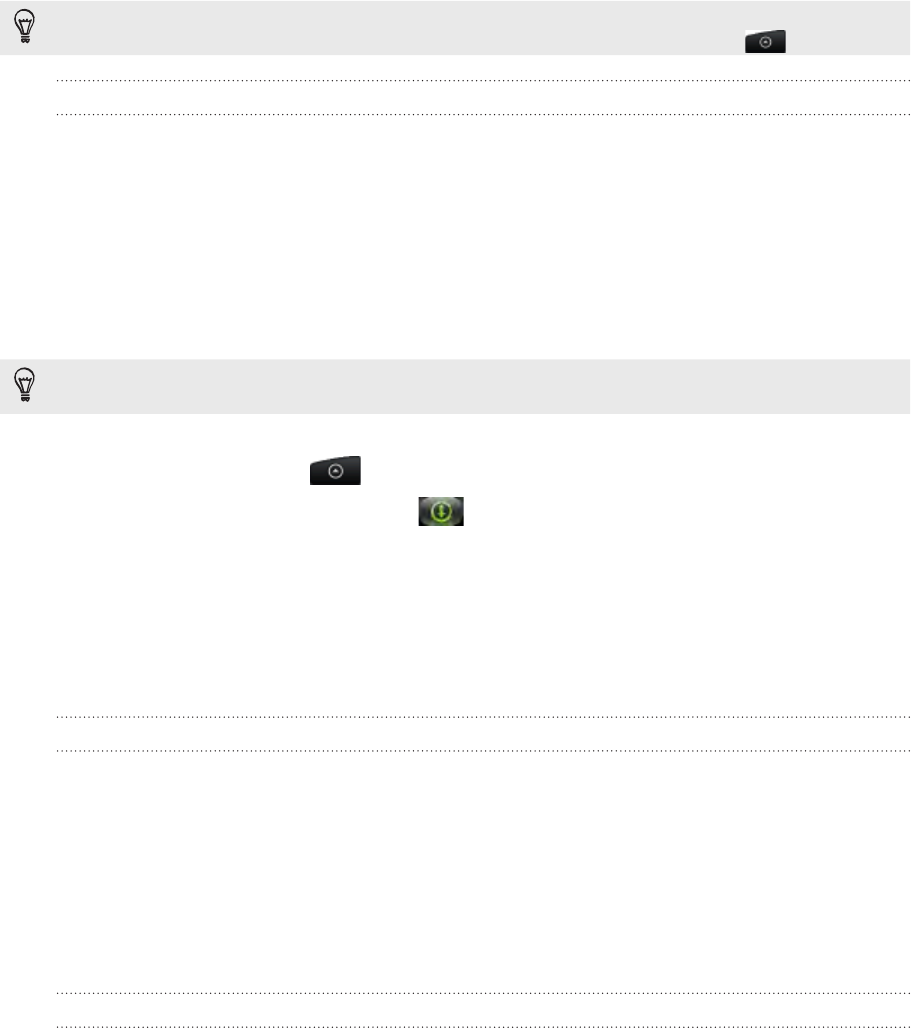
171 HTCSense.com
HTC Hub
Use the HTC Hub service to add more content for your phone. Browse apps, music,
ringtones, wallpapers, and a whole lot of other cool stuff and send them to your
phone.
You know, you can also browse and download content right from your phone using HTC Hub
on your phone. To open HTC Hub on your phone, from the Home screen, tap > HTC Hub.
Adding content to your phone
Make sure you have your phone close by, you’ll need your phone to complete the
download process.
1. On your computer, open your web browser and sign in to your HTCSense.com
account.
2. Click HTC Hub.
3. Browse through the HTC recommended items and check if you see something
you like or click More to see more items for that category.
You can also click the drop-down menu near the upper-left corner to select a category from
where to choose items to add to your phone.
4. Select the item you want, and then click Send to phone.
5. On your phone, tap on the Home screen, and then tap HTC Hub.
6. Slide to the My downloads tab , and then tap the item that you’ve just sent
from your computer.
Signing out from or deleting your
HTCSense.com account
Signing out of your HTCSense.com account
If you want to stop syncing your phone with your HTCSense.com account, sign out of
HTCSense.com from the phone.
From the Home screen, press MENU, and then tap Settings.
Tap Accounts & sync > HTC Sense > Remove account.
Rest assured that your contacts, footprints, and messages on the phone won’t be
deleted when you sign out from your HTCSense.com account.
Deleting your HTCSense.com account
1. On your computer, open your web browser and sign in to your HTCSense.com
account.
2. On the upper-right corner, click Account.
3. Click Click here to delete your HTCSense account.
Deleting your HTCSense.com account will also delete your data on HTCSense.com
servers.
1.
2.
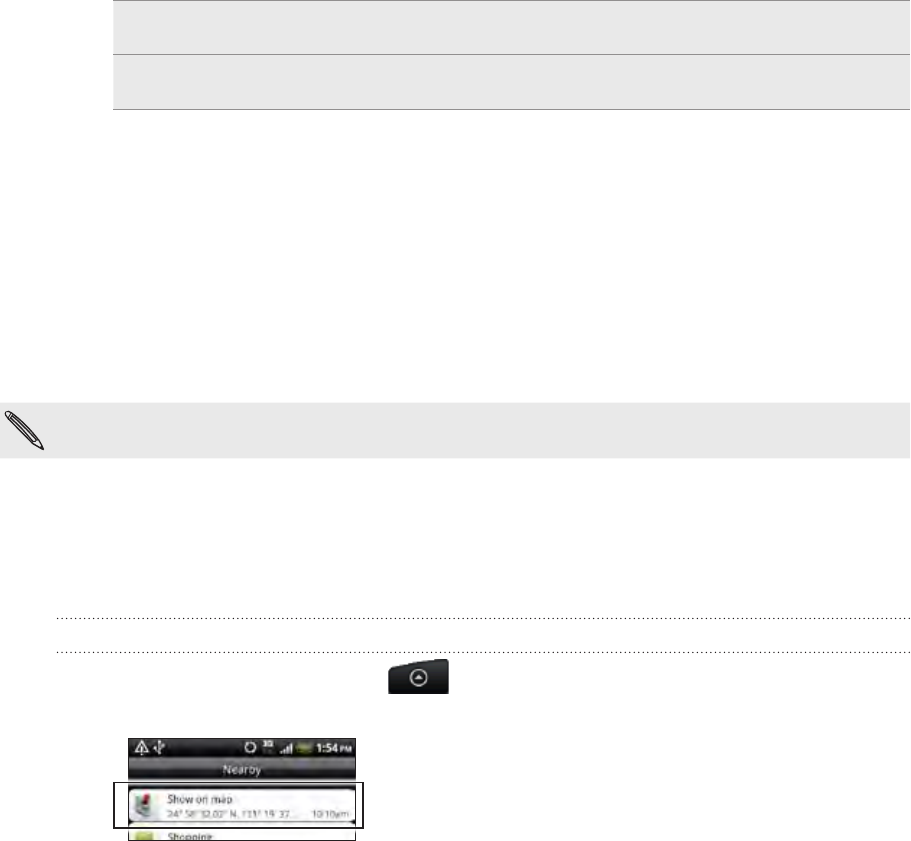
172 Maps and location
Maps and location
Turning on location services
In order to find your location on your phone, you need to enable location sources.
From the Home screen, press MENU, and then tap Settings > Location.
Select one or both of the following:
Use wireless networks Uses Wi-Fi or your mobile data connection to find your
approximate location.
Use GPS satellites Finds your exact GPS location. This requires a clear view
of the sky and more battery power.
Locations
Search for places of interest, get directions to places you want to go to, and drive
using turn-by-turn GPS navigation with Locations. Locations is also your perfect
travel companion, whether you’re at home or when you’re in a different country. With
Locations, you can download maps to your phone beforehand so you don’t have to
worry about having an Internet connection while on the road or costly data roaming
charges when abroad. Have your map ready before you start your journey.
If you are in an area where there are a lot of surrounding buildings, Locations may have a hard
time pinpointing your location.
Your phone comes with a map installed. The map on your phone will depend on the
country where you bought your phone. Don’t worry, you can download other maps
when you need them. Refer to “Downloading maps or purchasing services” in this
chapter to find out how.
Finding your location and what’s around you
From the Home screen, tap > Locations.
You can see your current location right below the tab name.
Press MENU, and then tap My location to update your current location or tap
Map to show your current location on the map.
3. Select a category that you’re interested in to see the places that are close by.
The places are listed according to the distance from your current location.
1.
2.
1.
2.
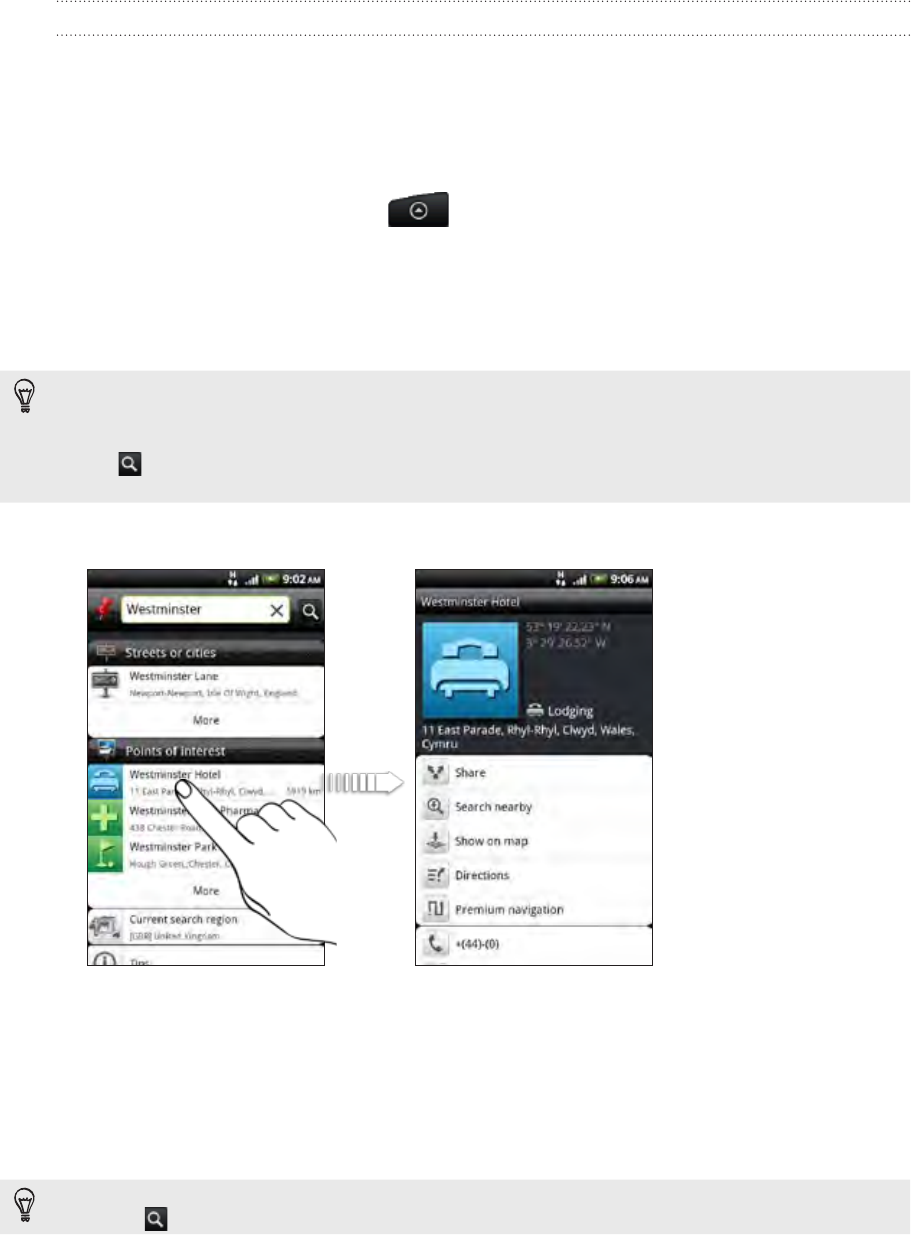
173 Maps and location
Searching for a place of interest or an address
Searching for a place of interest
You can search using a name of an establishment, street, or city.
As you enter the place to look for, suggested matches from the database, footprints,
and previously searched items are displayed.
From the Home screen, tap > Locations.
Press the SEARCH button.
Enter the place you want to search in the search box. Matching establishments
are shown sorted by the distance from your current location. If you don’t see
what you are looking for, keep entering characters to narrow down the search.
Search is done in your current country. If you want to do a search on a different country
on your phone, tap Current search region. To find out how to download other maps, see
“Downloading maps or purchasing services” in this chapter.
Tap if you don’t see any suggestions or if you don’t see the place you are looking for in
the list.
4. Tap an establishment to get directions, call them, add it as a footprint, and more.
Searching for an address
To find an address, you don’t need to enter the complete address. You can just enter
the street or city name and we’ll show you a list of suggestions that will guide you to
what you are looking for.
For example, to find “321, Church Street, London, UK”, just enter “Church” or “London”
to start your search.
You can also search by entering a zip code. To search using a zip code, enter the zip code, and
then tap .
1.
2.
3.
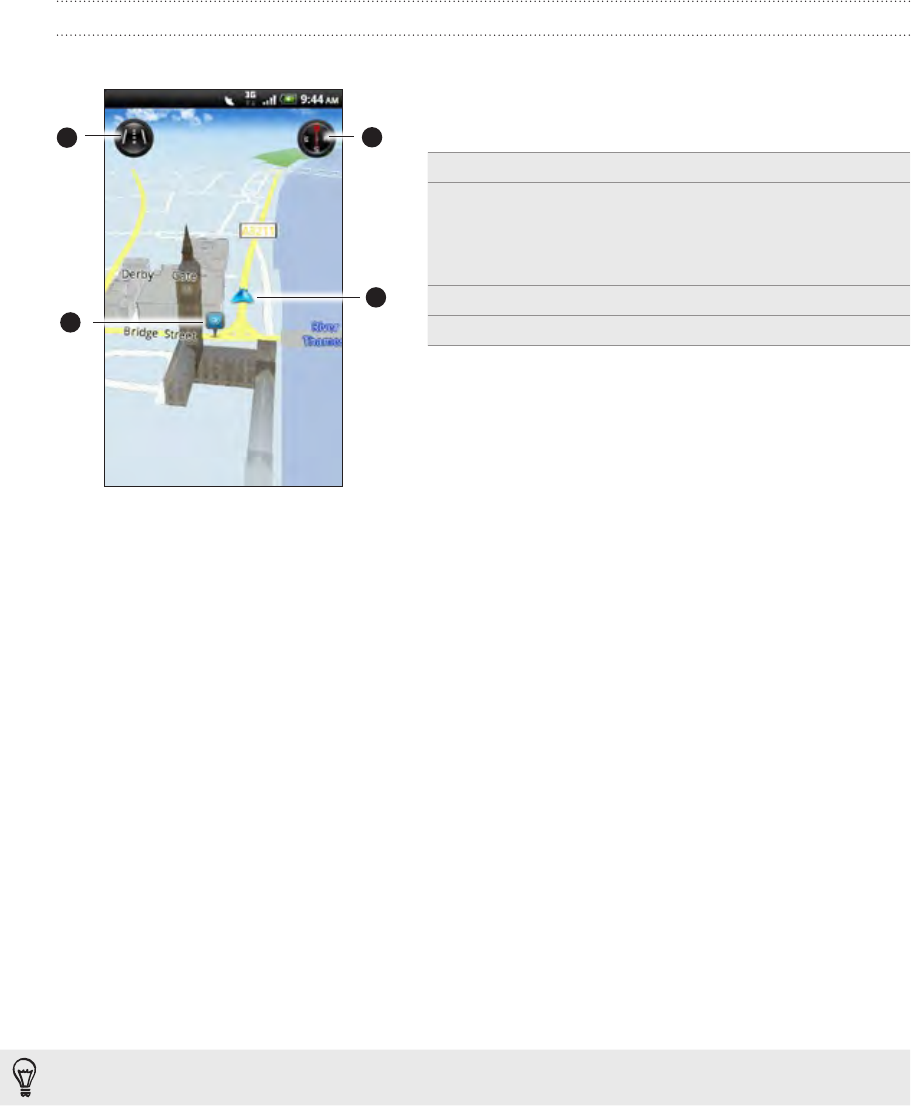
174 Maps and location
Viewing maps
In Locations, press MENU, and then tap Map.
1
3
4
2
1 Tap to switch between 2D and 3D views.
2 Point of interest. Tap to see details, call, get
directions, or share. See “Choosing which places
of interest to show on the map” to find out how
to show or hide places of interests.
3 Your current location.
4 Tap to use or not use the compass.
Using the compass
Should I turn left or right? By using the compass, the map adjusts depending on where
you’re facing so you know where to go.
Moving around the map
Swipe your finger on the screen to view other areas of the map.
Zooming in or out of a map
Do one of the following:
Spread your thumb and index finger across the map to zoom in.
Pinch your thumb and index finger on the map to zoom out.
Double-tap a location on the map to zoom in to that location.
Choosing which places of interest to show on the map
While viewing a map, press MENU, and then tap View.
Choose the points of interest you want or don’t want to see when you’re viewing
a map.
You can also choose to show or not show footprints and 3D buildings on the map.
3. Tap Done.
1.
2.
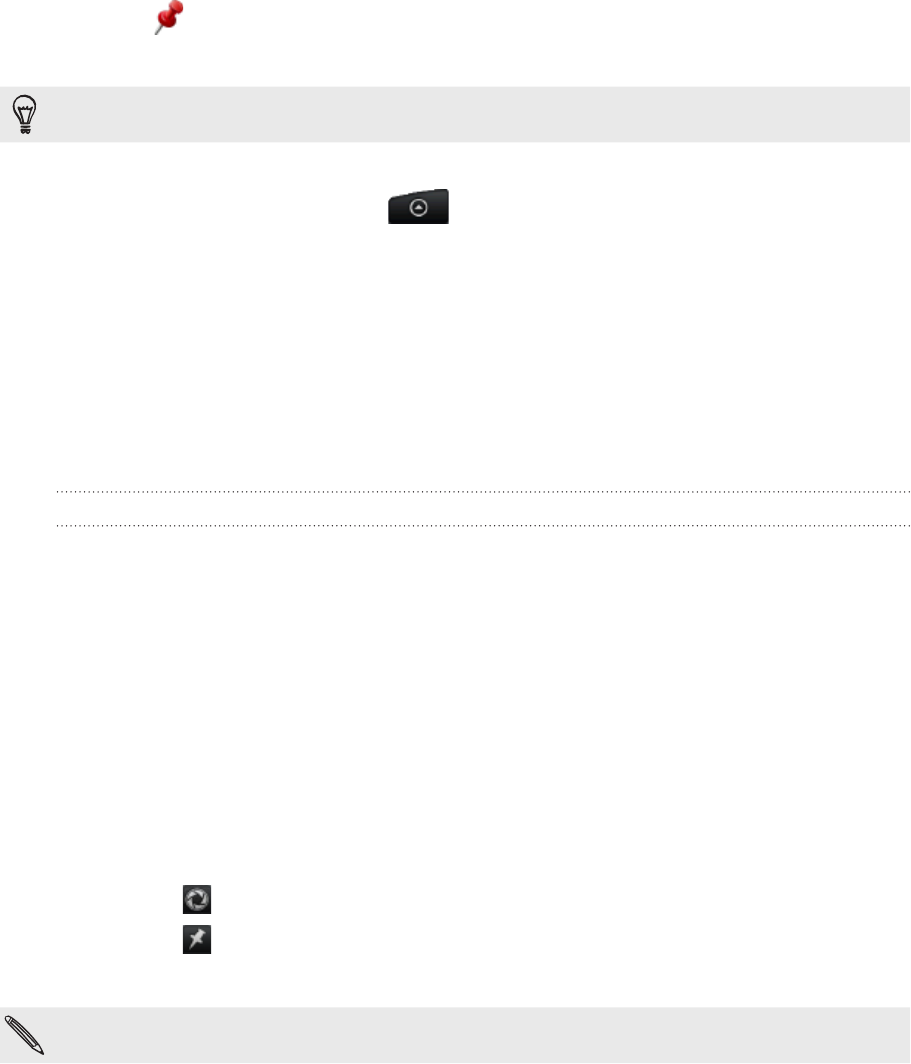
175 Maps and location
Pinning a location on the map
Pin a favorite location on the map and add it as a footprint, get directions to it, or
share it with friends. Sharing is a great way to let your friends know about that little
place you found that has the best sandwiches in town.
While viewing a map, press and hold an area on the map that you want to pin.
Tap and then choose if you want to add the location as a footprint, get
directions to it, or share it.
To remove all the pins on the map, while viewing a map, press MENU, and then tap More >
Clear pin.
Changing the language of street names and places of interest
From the Home screen, tap > Locations.
On the Nearby tab, press MENU, and then tap Settings > Map language.
Choose one of the following.
Use native map language if you want to use the local language of the map.
For example, if you are looking at a map of Japan, it will use Japanese
characters.
Use language that fits best if you want to use the language of your phone.
This may not be available for all maps.
Footprints
A footprint consists of a photo of a location such as a restaurant, a sightseeing
destination, etc., stored together with a precise GPS position and other information
about that location such as the street address and phone number.
The next time you want to visit the same place, simply access the footprint. You can
then dial the phone number or view the location in the map.
Adding a location as a footprint
In Locations, search for the destination you want to go to. See “Searching for a
place of interest” earlier in this chapter to find out how.
Tap Save to Footprints.
3. You can:
Tap to take a picture and add it as a photo for the footprint.
Tap to fine tune the position of the footprint on the map.
4. Tap Done.
Before pressing Done, tap the photo to change the name, category, or address of the
footprint, enter the phone and website, and add a voice memo to the footprint.
1.
2.
1.
2.
3.
1.
2.

176 Maps and location
Setting a footprint as your home location
Save your home address as a footprint to make it easier to set it as your destination.
1. While at your home location, open Locations, and then go to the Footprints tab.
2. Tap Save to Footprints.
The address shown should be your current location. If it doesn’t show your home address,
press MENU, and then tap My location.
3. Tap Done.
4. Tap My home, select your home address from the list, and then tap Done.
Tap to change your home address.
Revisiting a footprint
1. On the Footprints tab, tap a category.
2. Tap the footprint you want to revisit.
3. Tap the information fields to get directions, share the footprint, call a stored
phone number, and more.
Editing or deleting a footprint
1. On the Footprints tab, tap a category.
2. Press and hold the footprint you want to edit or delete.
3. Tap Edit or Delete on the options menu.
Sharing your footprints
1. Create a footprint. See “Adding a location as a footprint” earlier in this chapter to
find out how.
2. On the Footprints tab, tap the footprint that you have just created.
3. Tap Share, and then choose how you want to share the footprint.
Deleting multiple footprints
1. On the Footprints tab, tap a category.
2. Press MENU, and then tap Delete.
3. Select the footprints you want to delete, and then tap Delete.
Exporting your footprints
Back up footprints by exporting them to the storage card. You can also open exported
footprints files in other applications such as Google Earth on your PC. To transfer files
from your storage card to your computer, see “Copying files to or from the storage
card” in the Getting started chapter.
1. On the Footprints tab, tap a category.
2. Press MENU, and then tap Export.
3. Select the footprints you want to export, and then tap Export.

177 Maps and location
Press MENU and then tap Unmark all to deselect all the footprints.
Exported footprints are saved as .kmz files in the Footprints folder on your storage
card. If you exported multiple footprints at one time, they are saved together in one
.kmz file.
Importing footprints
Bring back footprints you previously backed up to the storage card to your phone.
You can also import .kmz files that you saved in other applications, or use a photo as a
footprint.
1. On the Footprints tab, press MENU, and then tap Import.
2. Do one of the following:
To import a saved footprint or another .kmz file from the storage card, tap
Footprints data, and then tap the file you want to import. If a footprint
on your phone is the same as the one you want to import, you’re asked
whether you want to overwrite it.
To import a photo, tap Photos, navigate to the photo you want to import,
and then tap the photo. You can then add Footprints information such as
location and category.
Getting directions
Get detailed driving or walking text instructions on how to get to your destination.
Getting directions from your current location
In Locations, search for the destination you want to go to. See “Searching for a
place of interest” earlier in this chapter to find out how.
You have footprints saved? You can also set a footprint as your destination. Just go to the
Footprints tab, and then choose a footprint.
2. Tap Directions.
3. Choose how you want to get to your destination. The map opens showing the
route to your destination.
4. Do one of the following:
At the bottom of the screen, tap or to follow the route to your
destination.
Slide up the directions bar, and then tap the instructions to follow the route
to your destination.
1.
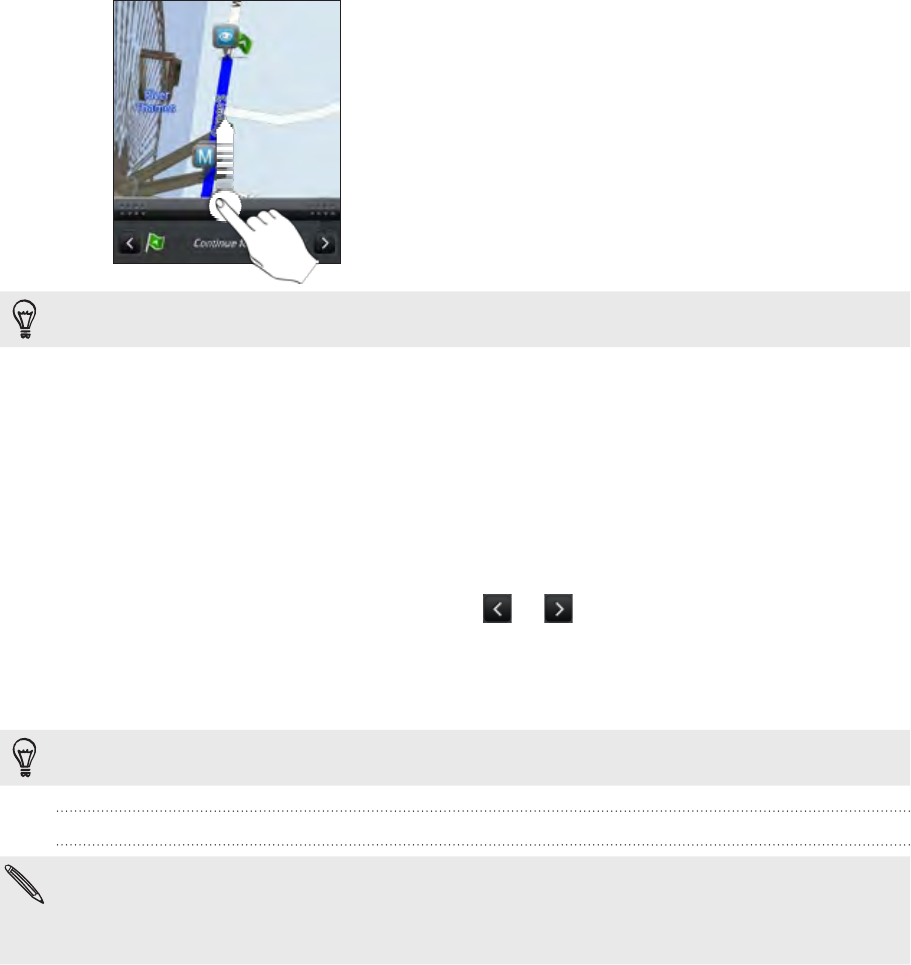
178 Maps and location
If you have turn-by-turn navigation for that country, press MENU, and then tap Navigate to
start turn-by-turn navigation.
Getting directions by setting a start and end location
While viewing the map, press MENU, and then tap Direction.
Tap the My Location text box, and then search for the starting location you want.
Tap the End point text box, and then search for the destination you want.
Tap Driving or Walking depending on how you want to get to your destination.
Do one of the following:
At the bottom of the screen, tap or to follow the route to your
destination.
Slide up the directions bar, and then tap the instructions to follow the route
to your destination.
If you have turn-by-turn navigation for that country, press MENU, and then tap Navigate to
start turn-by-turn navigation.
Using turn-by-turn navigation
To use turn-by-turn navigation, the Use GPS satellites option in Location sources needs to
be selected. To find out how to turn it on, see “Turning on location services” in this chapter.
Check if you have the turn-by-turn navigation for the map you’re using. To find out if the
phone has turn-by-turn navigation for the map, see “Managing Locations services.”
Using your phone with the car kit
If you purchased the dedicated car kit for your phone, you can use the included in-
car holder to mount your phone securely inside your car and use your phone on the
road. Refer to the car kit guide for instructions on how to install the in-car holder and
properly mount your phone to the holder.
When you mount your phone on the car kit, the Car Panel automatically opens. To find
out more about the Car Panel, refer to “Using Car Panel” earlier in this chapter.
1.
2.
3.
4.
5.
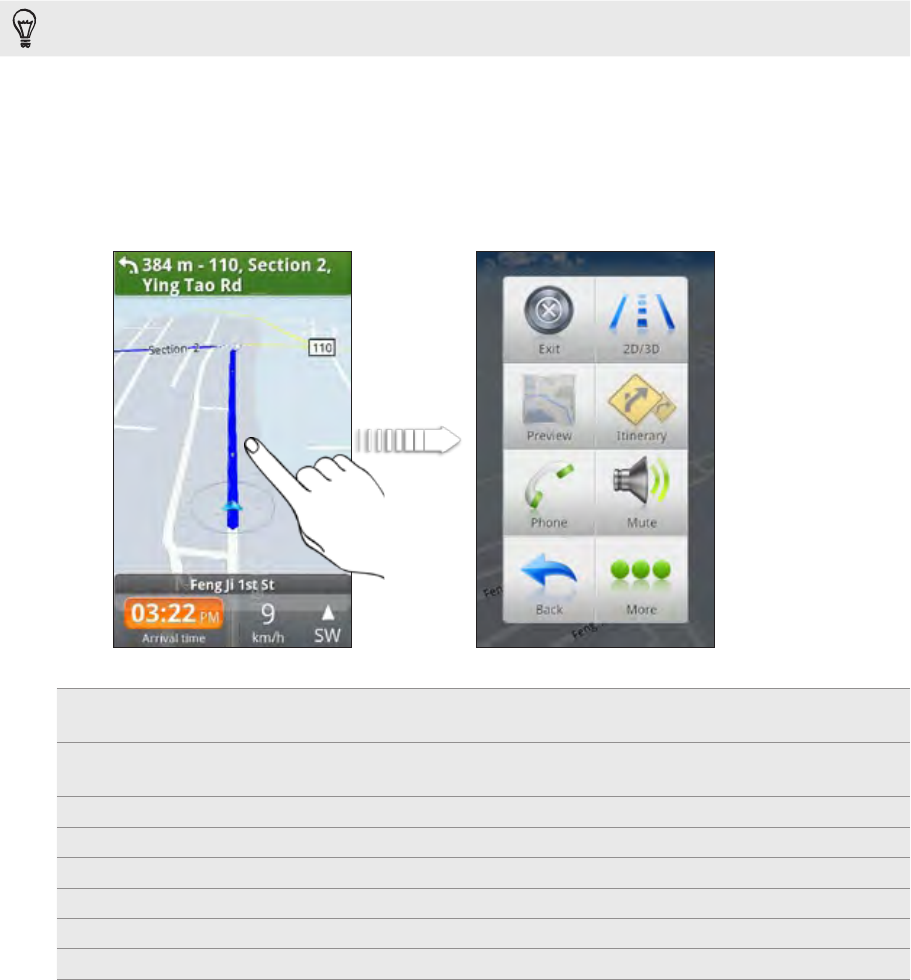
179 Maps and location
Setting a destination
In Locations, search for the destination you want to go to. See “Searching for a
place of interest” earlier in this chapter to find out how.
You have footprints stored? You can also set a footprint as your destination. Just go to the
Footprints tab, and then choose a footprint.
2. Tap Premium navigation.
You might need to wait a few seconds for the GPS satellites to find your current
location. Once your location is found, you can start driving to your destination by
following the turn-by-turn instructions. If you prefer a different voice to guide you,
you can download a different voice. To find out how to download new voices, see
“Downloading maps or purchasing services” in this chapter.
While driving, you can tap the screen to see what other options are available.
Exit/Stop When not en route to a destination, tap to exit turn-by-turn navigation.
When en route to a destination, tap to stop turn-by-turn navigation.
Preview Check the route you’ll be taking by going on a “virtual helicopter ride” from
your current position to your destination.
Phone Make a call.
Back Close the panel.
2D/3D Switch to 2D or 3D view of the map.
Itinerary View the route turn list.
Mute Turn on or off the voice instructions for turn-by-turn navigation.
More Open the Car Panel. See “Using Car Panel” in this chapter for details.
1.
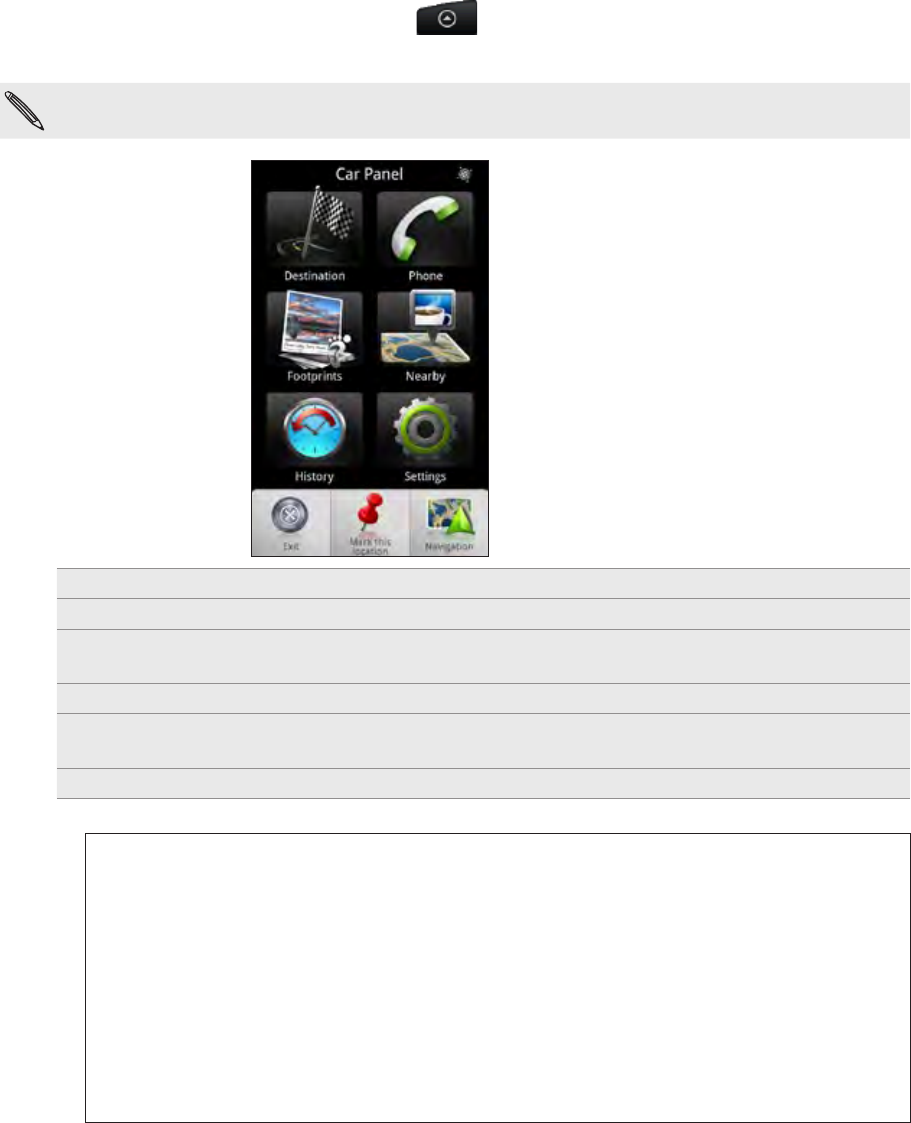
180 Maps and location
Using Car Panel
Easily access footprints, points of interest, and places nearby with Car Panel, and then
start navigation to show you how to get there.
Open the Car Panel by doing one of the following:
Mount your phone on the in-car holder. See “Using your phone with the car
kit” in this chapter for details.
From the Home screen, tap > Car Panel.
While in turn-by-turn navigation, tap the screen, and then tap More.
When your phone is in the holder and is not connected to a Bluetooth car kit or headset, the
phone’s speakerphone is automatically turned on when you make or answer a phone call.
Destination Search for a destination to go to.
Footprints Select a footprint to set as a destination.
History Check the places you’ve search before, and then choose one to set as your
destination.
Phone Make a phone call.
Nearby Check places of interest that are close to your current location, and then
choose one to set as your destination.
Settings Set Car Panel options.
Car Panel keeps opening by itself when you’re using a mini-to-
micro USB converter?
If you connect a mini-USB power adapter or car charger to your phone through
a mini-to-micro USB converter, your phone may misinterpret this to be a car kit
connection (due to the dierent connector PIN assignment on the mini-USB
power adapter or car charger) and automatically display the Car Panel.
You can prevent Car Panel from automatically opening by:
1. In Car Panel, tap Settings > Car kit.
2. Clear the Automatically launch check box.

181 Maps and location
Setting navigation preferences
Choose how you want Locations to map your route. You can tell Locations to avoid
highways or toll roads, show lane information, choose your route preference, and more.
While using turn-by-turn navigation, tap the screen.
Tap More > Settings > Navigator.
Set your preferences by selecting or tapping an item.
Turning off speed and safety camera alerts
If you have the safety camera service, you can choose to turn this service off
temporarily.
While using turn-by-turn navigation, tap the screen.
Tap More > Settings > Warnings.
Clear the Speed warning and Safety camera warning check boxes.
Automatically connecting to a Bluetooth car kit or headset
You can set your phone to connect to your Bluetooth car kit or Bluetooth headset
automatically, if one is paired with your phone, whenever you mount the phone on the
in-car holder.
If you don’t have a Bluetooth car kit or headset paired with your phone, refer to the Bluetooth
chapter to find out how to pair a Bluetooth device with your phone.
In Car Panel, tap Settings > Car kit.
Select the Auto-connect check box.
If you have more than one Bluetooth car kit or headset paired with your phone,
tap Default device to choose the Bluetooth car kit or headset to use.
Before mounting your phone on the in-car holder, make sure that Bluetooth on your
phone and the paired Bluetooth car kit or headset is turned on.
Answering a call while using navigation
When a call comes in, the whole map nudges up a bit so you can see the incoming call
and answer it. Don’t worry, you’ll still be able to use navigation as we made sure that
the call screen just occupies as little space as possible at the bottom of the screen.
Managing Locations services
Check the maps, navigation, safety camera information, and voices for turn-by-turn
voice instructions that are already on your phone.
From the Home screen, tap > Locations.
Press MENU, and then tap Upgrade.
In the Manage licenses & content tab, you’ll see a list of services that are already
on your phone.
1.
2.
3.
1.
2.
3.
1.
2.
3.
1.
2.
3.

182 Maps and location
Downloading maps or purchasing services
Going to a different country for vacation? You can download the map of the country
you’re going to for free. You can also download or purchase additional services such
as navigation, safety camera, and turn-by-turn voice instructions.
You need a data or Wi-Fi connection to download or purchase maps and services.
From the Home screen, tap > Locations.
Press MENU, and then tap Upgrade.
Slide to the tab of the item or service that you want to download.
Tap what you want to download.
Depending on what you selected, tap Download or Purchase.
Depending on the country where you bought your phone, you may only need to enter
a voucher code to activate turn-by-turn navigation. If you have a voucher code, enter
it by tapping Voucher code at the top of the Purchase navigation tab.
Adding Locations widgets
Add a favorite destination and places of interest that are nearby as widgets on your
Home screen. Add the Navigate widget to start turn-by-turn navigation to your
favorite destination. Add the Nearby widget to let you browse places of interest right
on the Home screen.
To find out how to add widgets, refer to “Adding a widget” in the Personalizing
chapter.
1.
2.
3.
4.
5.
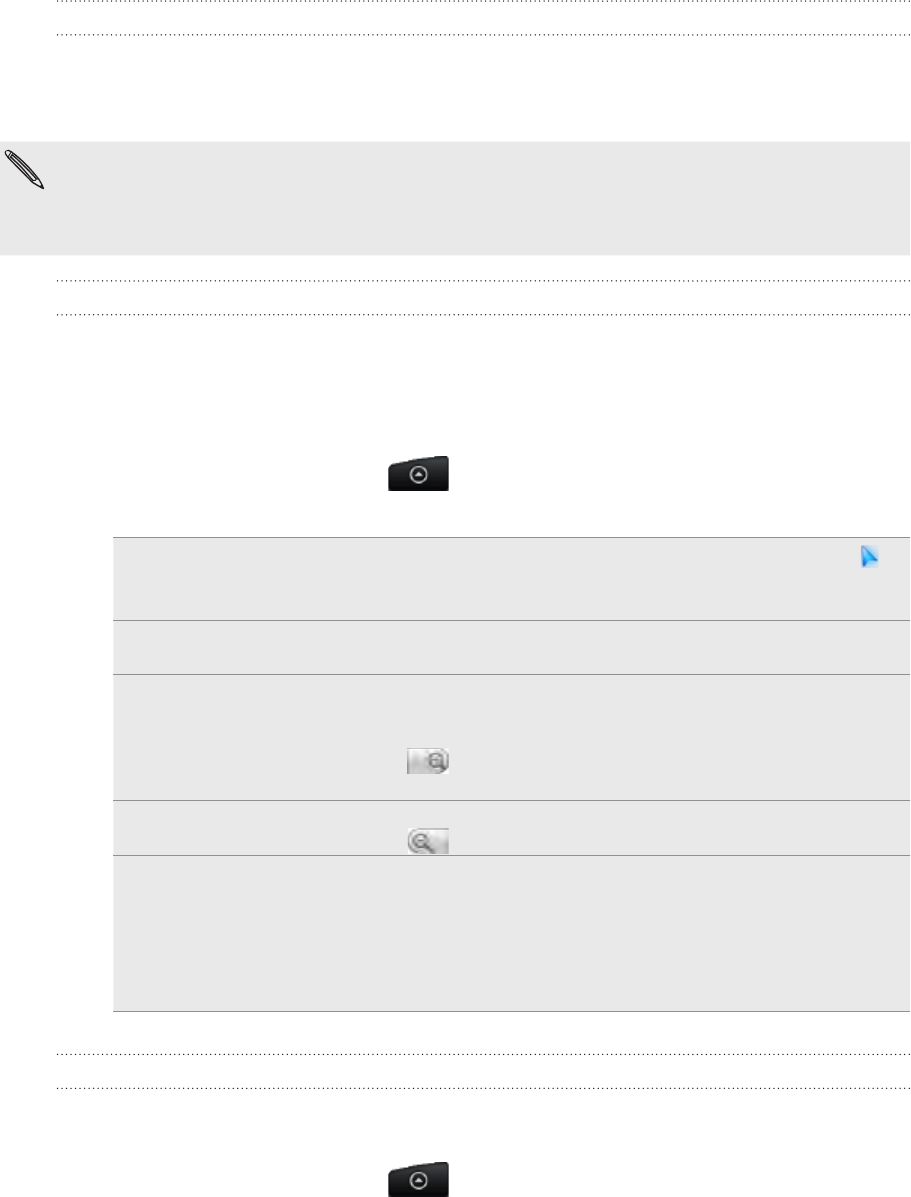
183 Maps and location
Google Maps
About Google Maps
Google Maps lets you track your current location, view real-time traffic situations, and
receive detailed directions to your destination. It also provides a search tool where you
can locate places of interest or an address on a map, or view locations at street level.
You need an active mobile data or Wi-Fi connection to use Google Maps.
To find your location with Google Maps, you need to enable location sources. To learn how,
see “Turning on location services” in this chapter.
The Google Maps application does not cover every country or city.
Getting around maps
When you open Google Maps, you can easily find your location on the map or check
out nearby places by panning and zooming in and out on the map.
To find your location with Google Maps, you need to enable location sources. See
“Turning on location services” in this chapter to learn how.
From the Home screen, tap > Maps.
Do any of the following on the map:
Show your location Press MENU and then tap My Location. The blue marker ( )
shows your location on the map and points north for your
reference.
Move around Swipe your finger to any direction on the screen to view
nearby places on the map.
Zoom in Place your thumb and index fingers on top of the area that
you want to zoom in, and then spread your fingers across
the map.
Tap
Double-tap the area on the map that you want to zoom in.
Zoom out Pinch your thumb and index finger on the map to zoom out.
Tap
View information for a
random location
1. Press and hold a location on the map. A balloon opens over
the location, with the address and a thumbnail from street
view (if available).
2. Tap the balloon to see more information.
You can get directions to the location, check for nearby
places of interest, and more.
Looking at a location in Street View
Street View mode (available only in selected areas) provides a street-level view of the
location.
1. From the Home screen, tap > Maps.
2. Do one of the following:
Press and hold a location on the map, and then tap the balloon that appears.
1.
2.
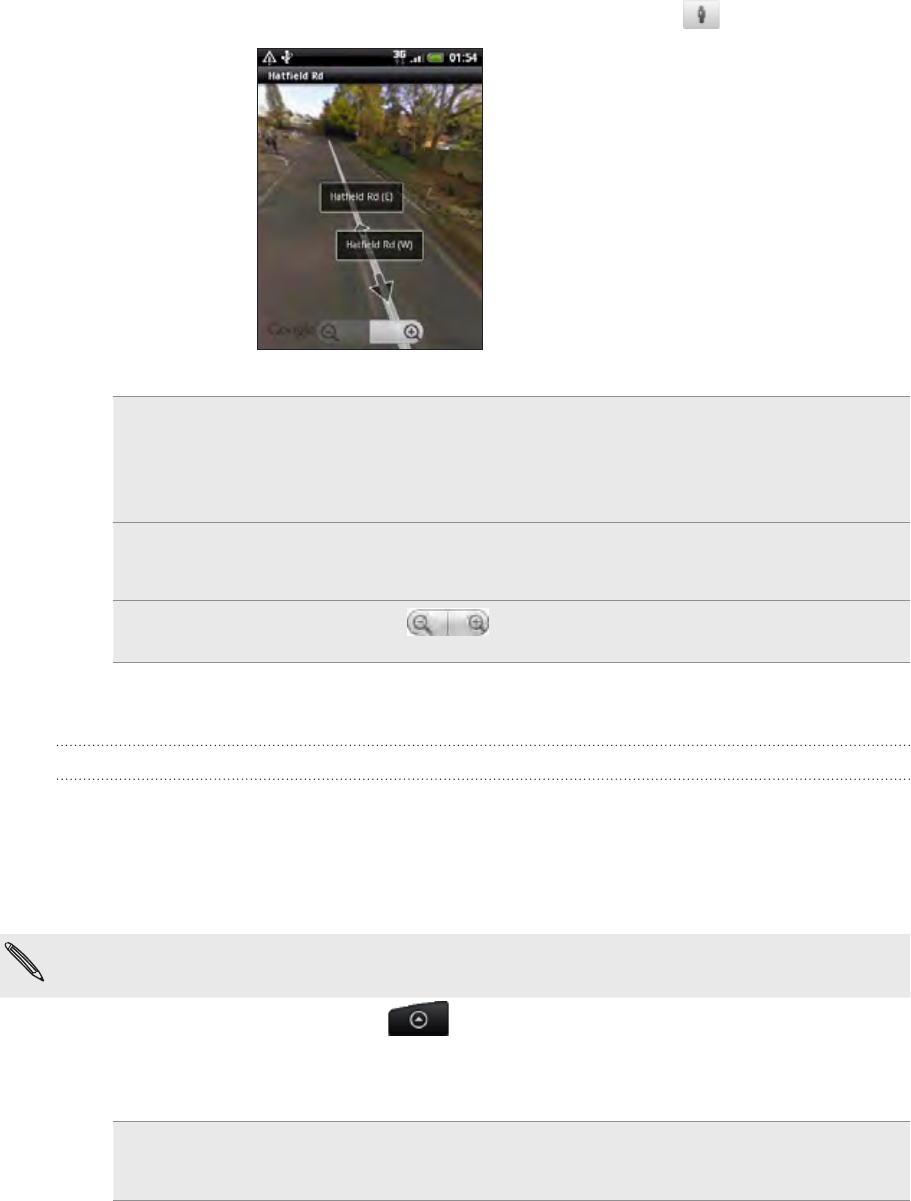
184 Maps and location
Search for the place you want to view in Street View. See “Searching for a
location” and “Searching for a place of interest near you” in this chapter for
details. When you find the place, tap its balloon.
3. On the location details screen, tap the Street view button .
4. To navigate in Street View, do any of the following:
View surrounding areas Swipe your finger on the screen to pan up or down or to
look in other directions.
Press MENU and then tap Compass mode to turn Compass
mode on. Tilt, pan, or turn your phone to view the area
around the location.
Step forward or
backward
Tap the onscreen arrow to move towards the direction it is
pointing.
Press MENU and then tap Step forward or Step backward.
Zoom in or out Tap
Press MENU, and then tap Zoom.
4. To return to the street map, press MENU and then tap Go to map.
Viewing map layers
Initially, Google Maps opens with a street map. You can view additional map layers,
such as satellite images, traffic information, your Google Latitude friends’ locations,
and Wikipedia information on locations. You can also view maps that you and other
people have created in Google Maps on the web. You can view multiple layers at the
same time.
Not all locations have information to support all Map layers or all zoom levels. To learn more
about layers, visit Google Maps on the web: http://maps.google.com/
From the Home screen, tap > Maps.
Press MENU, and then tap Layers.
Select any of the following:
Traffic (Available only in selected areas.) Real-time traffic conditions are
displayed over roads as color-coded lines. Each color represents how fast
the traffic is moving.
1.
2.
3.

185 Maps and location
Satellite Google Maps uses the same satellite data as Google Earth™. Satellite
images are not real-time. Google Earth acquires the best imagery
available, most of which is approximately one to three years old.
Terrain Shows the elevation of the map you’re viewing. Elevation is limited to
natural geographic features, like mountains and canyons, and does not
apply to buildings.
Buzz See photos and information about places shared by other people, or post
your own.
Latitude When you have joined Latitude, you can view your friends’ locations as a
layer on the map. For information, see “Finding your friends with Google
Latitude (available by country)” in this chapter.
Clear Map Clear layers and view only the street map.
More Layers Select more layers such as transit lines or maps that you have created in
Google Maps on the web.
Searching for a location
In Google Maps, you can search for a location, such as an address or a type of
business or establishment (for example, museums).
From the Home screen, tap > Maps.
While viewing a map, press SEARCH.
Enter the place you want to search in the search box.
As you enter the location to look for, suggested matches from your contacts, the
web, and previously searched items are displayed.
Tap to search for the location you entered or tap a suggested search item.
The search results are displayed as markers on the map.
5. Do any of the following:
If the first search result ( ) is what you’re looking for, tap the balloon.
Otherwise, tap to go to the next search result until you find the location
you’re searching for, and then tap its balloon.
Tap to show the search results as a list, and then tap the location.
Details about the selected location displays on the screen.
1.
2.
3.
4.
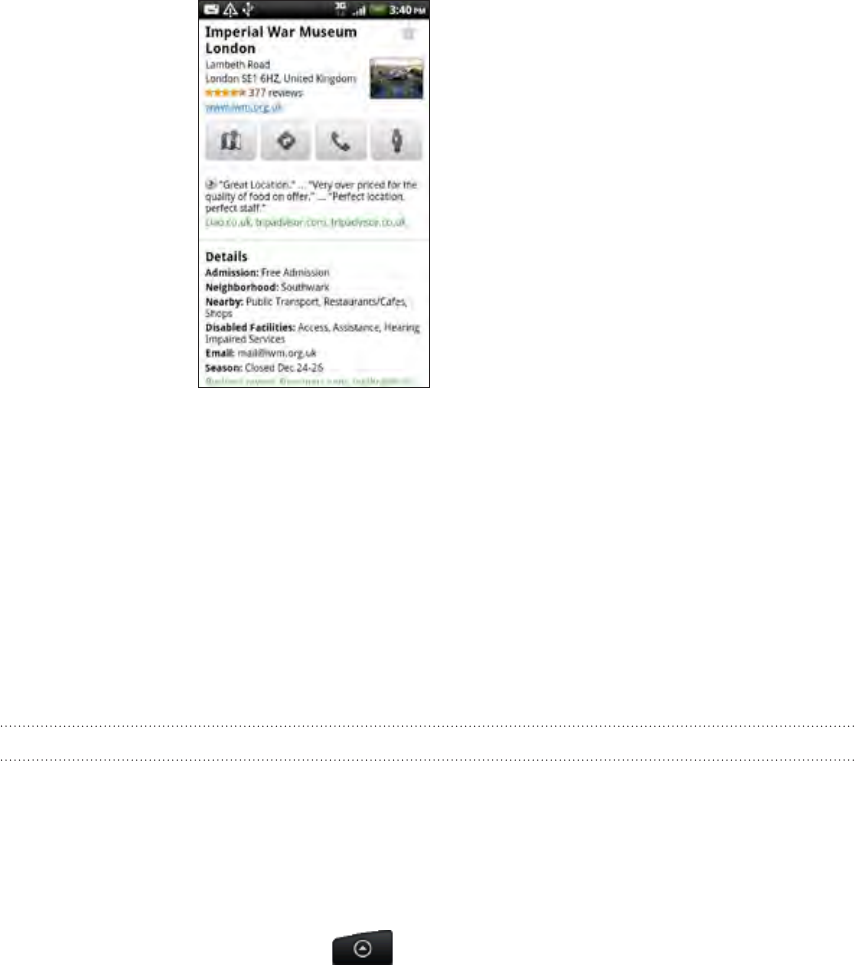
186 Maps and location
5. Do any of the following:
Tap the onscreen buttons to view the location on a map, get directions, view
the location in Street View, if available, and more. Scroll down the screen to
view more options.
Swipe left or right across the screen to view the information for the next or
previous search result.
Clearing the map
After you’ve search on a map, you can clear away the various markers drawn on it by
pressing MENU, and then tapping More > Clear Map.
Searching for a place of interest near you
Use Places to find places of interest near your current location. Places uses Google
Maps to search common places that you would want to find, such as the nearest gas
station or ATM kiosk.
Before you use Places, you need to enable location sources. See “Turning on location
services” in this chapter to learn how.
From the Home screen, tap > Places.
Tap the place you want to search.
1.
2.
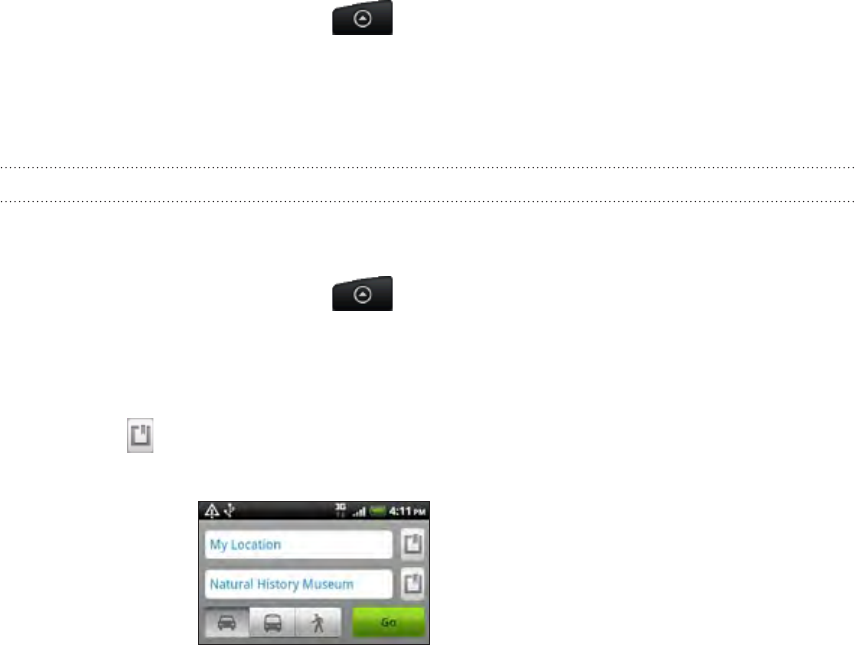
187 Maps and location
Do any of the following:
When one or two places of interest are found, the search results are displayed
as markers on the map. You can tap the marker, and then tap the balloon to
view more information about the place.
When several places are found, the search results display in a list. Tap a
place to show its location on a map, and then tap its balloon to view more
information about the place.
See “Searching for a location” in this chapter to learn what you can do on the
location information screen.
Adding a place to search
In Places, you can add other places of interest that you frequently search for, such as a
church or a pizza restaurant.
From the Home screen, tap > Places.
Tap Add.
Enter the place you want to add to Places’ search items, and then tap Add.
The place is added as a button on the Places’ screen.
Getting directions
Get detailed directions to your destination. Google Maps can provide directions for
travel by foot, public transportation, or car.
From the Home screen, tap > Maps.
While viewing a map, press MENU, and then tap Directions.
Use your current location as the starting point, or enter a location from where to
start in the first text box. Then enter your destination in the second text box.
Or tap to select an address from your contacts or a point that you tap on a
map.
3. Choose how you want to get to your destination by tapping the car, public
transit, or walk button.
4. Tap Go.
5. If the place you’ve set as your destination has several locations available, choose
which one to go to.
The next screen displays the directions to your destination in a list.
3.
1.
2.
3.
1.
2.
3.
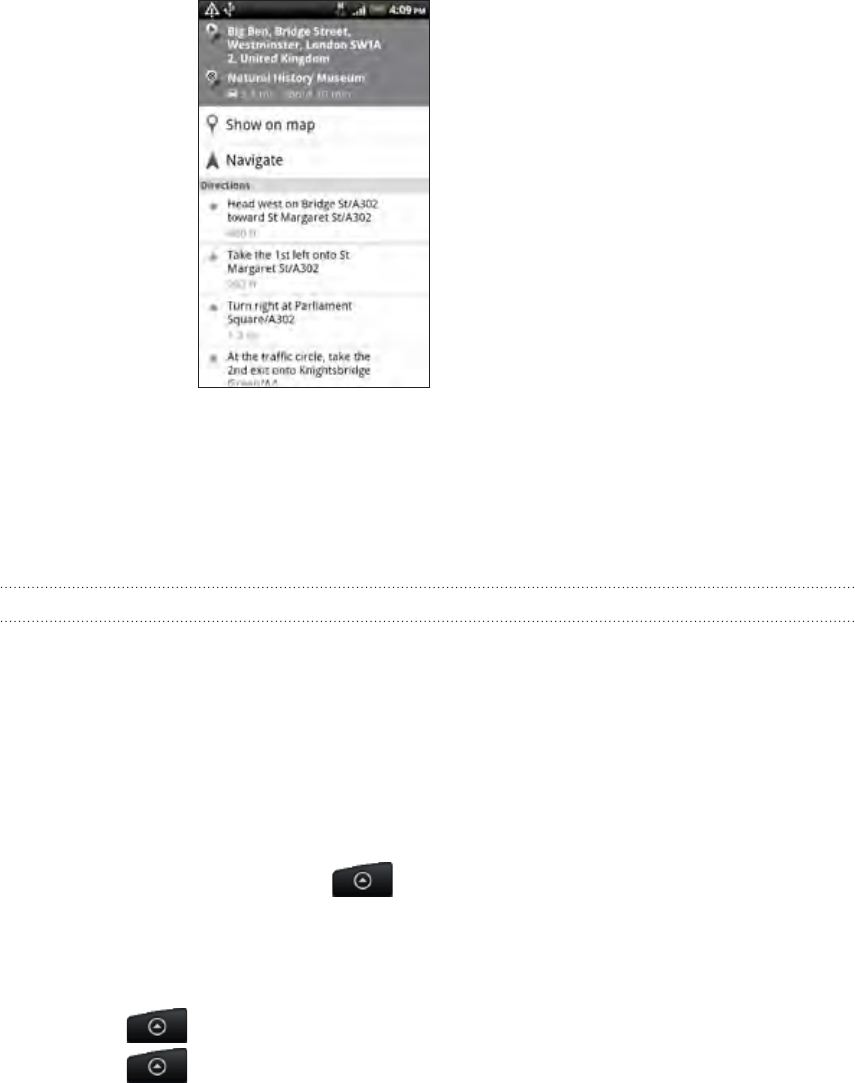
188 Maps and location
6. Tap Show on map to view the directions on the map.
7. Tap the arrow buttons on the map to follow the directions.
When you’re finished viewing or following the directions, press MENU and then tap
More > Clear Map to reset the map. Your destination is automatically saved in the
Google Maps history.
Finding your friends with Google Latitude (available by country)
Google Latitude™ user location service lets you and your friends share locations and
status messages with each other. It also lets you send text and email messages, make
phone calls, and get directions to your friends’ locations.
Your location is not shared automatically. You must join Latitude, and then invite your
friends to view your location or accept their invitations. Only friends that you have
explicitly invited or accepted can see your location.
Opening and joining Latitude
From the Home screen, tap > Maps.
While viewing a map, press MENU and then tap Join Latitude.
After you’ve joined Latitude and closed the application, you can do any of the
following to open it from the Home screen:
Tap > Latitude.
Tap > Maps, press MENU, and then tap Latitude.
1.
2.
3.

189 Maps and location
Inviting friends to share their locations
1. From the Home screen, tap > Latitude.
2. Press MENU, and then tap Add friends.
3. Choose how to add friends:
Select from Contacts Select any number of friends from your Contacts.
Add via email address Enter one or more email addresses.
4. Tap Add friends.
5. When asked to confirm, tap Yes.
If your friends already use Latitude, they receive an email request and a
notification on Latitude. If they have not yet joined Latitude, they receive an
email request that tells them to sign in to Latitude with their Google Account.
Responding to an invitation
When you get a sharing request from a friend, you can:
Accept and share back You and your friend can see each other’s locations.
Accept, but hide my location You can see your friend’s location, but they can’t see
yours.
Don’t accept No location information is shared between you and your
friend.
Viewing your friends’ locations
You can view your friends’ locations on a map or in a list.
When you open Maps, your friends’ locations are shown. Each friend is represented by
their picture (from Contacts) with an arrow pointing to their approximate location. If
a friend has chosen to share city-level locations, their picture does not have an arrow
and appears in the middle of the city.
To see a friend’s profile and connect, tap the photo. Your friend’s name appears in a
balloon. Tap the balloon to open a screen with details about your friend and many
connection options.
When you open Latitude you see a list of your Latitude friends, with a summary of
their last known locations, status, and so on. Tap a friend in the list to open a screen
with details about the friend and many connection options.
Connecting with and managing friends
Tap a friend’s contact details balloon in map view or tap a friend in list view to open
your friend’s profile. Tap any of the following buttons or options on the profile screen:
Shows your friend’s location on the map.
Gets directions to your friend’s location.
View your friend’s location in Street View.
Your friend’s photo Opens Quick contact and lets you view your friend’s contact details,
send your friend an email, and more.

190 Maps and location
Sharing options Select from the following:
Best available location. Share your precise location information.
Share only city level location. Share only the city you’re in, not the
street-level location. Your friend can see your photo icon in the
middle of the city you’re in. To share more precise location again, tap
Best available location.
Hide from this friend. Stop sharing your location with this friend, in a
list or on a map.
Remove this friend Remove the friend from your list and stop sharing locations with him or
her altogether.
Changing privacy settings
You have control over how and when you can be found by your friends. Only the last
location sent to Latitude is stored with your Google Account. If you turn off Latitude
or are hiding, no location is stored.
From the Home screen, tap > Latitude.
Tap your own name, and then tap Edit privacy settings.
Set the following options to your preferences:
Turn off Latitude Disable Latitude and stop sharing your location or status.
You can always join Latitude again.
Detect your location Let Latitude detect and update your location as you move.
The update frequency is determined by several factors, such
as how recently your location has changed.
Set your location Choose from several options to manually select your
location.
Hide your location Hide your location from all your friends.
1.
2.
3.

191 More apps
More apps
Watching videos on YouTube
Use the YouTube app to check out what’s popular on the online video-sharing website.
Videos are conveniently categorized into Most viewed, Most discussed, and Top rated.
You need an active Wi-Fi or data connection to access YouTube.
The first time you use certain YouTube functions such as video sharing, sign in using your
YouTube or Google Account, if you’re asked to do so.
From the Home screen, tap > YouTube.
Scroll through the list of videos, and then tap a video to watch it. The screen
automatically switches to landscape view when you play a video.
While watching a video, you can:
Tap the screen to display the playback controls. When the playback controls
are displayed, you can pause, skip forward or backward, or drag the slider to
the point in the video you want to watch.
Press MENU to rank, comment on, share, flag as inappropriate, and interact
with the video in other ways.
4. Press BACK to stop playback, and return to the video list.
Searching for videos
On the YouTube main screen, press SEARCH.
Enter a search keyword, and then tap .
The number of search results appears below the status bar. Scroll through the
results and tap a video to watch it.
Clearing the search history
On the YouTube main screen, press MENU, and then tap Settings.
Tap Clear search history, and then tap OK when prompted.
Sharing a video link
Share a video by sending its link to your contacts.
While watching a video, press MENU, and then tap Share.
Choose how you want to share the video link from the available options.
1.
2.
3.
1.
2.
3.
1.
2.
1.
2.
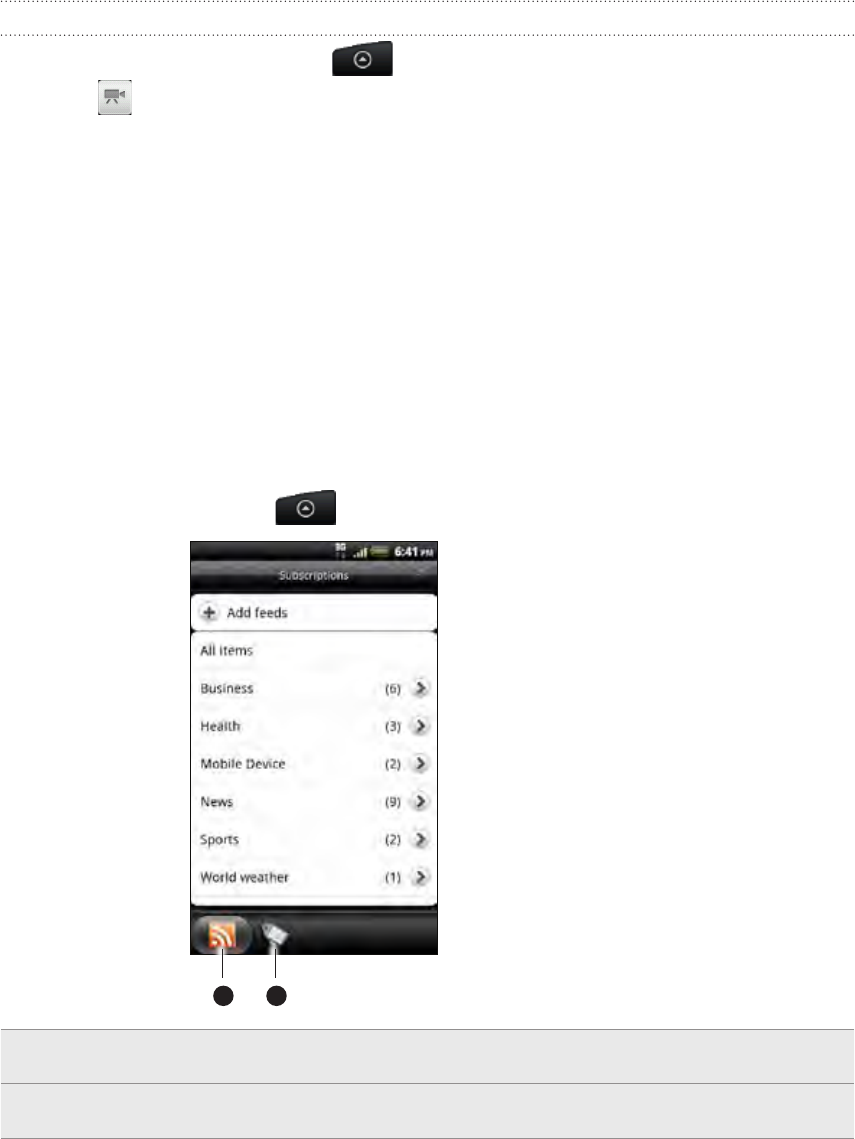
192 More apps
Capturing a video and sharing it on YouTube
From the Home screen, tap > YouTube.
Tap .
Press the optical trackball to start capturing video. When you are done
capturing, press the optical trackball again. Tap Done.
Enter a title, description, and tags for your video.
Set the privacy level.
Tap Upload.
Reading news feeds
Don’t get left behind with yesterday’s stories. Use the News app to subscribe to news
feeds that cover breaking news, sports, top blogs, and more. You can also get updates
based on specific keywords you want.
From the Home screen, tap > News.
21
1 Subscriptions tab. Tap to list the channels you’ve subscribed to. To find out how to
subscribe, see “Subscribing to news channels.”
2 My Items tab. Tap to show links to your starred items and added keywords. See “Starring a
story” and “Adding a keyword”.
1.
2.
3.
4.
5.
6.
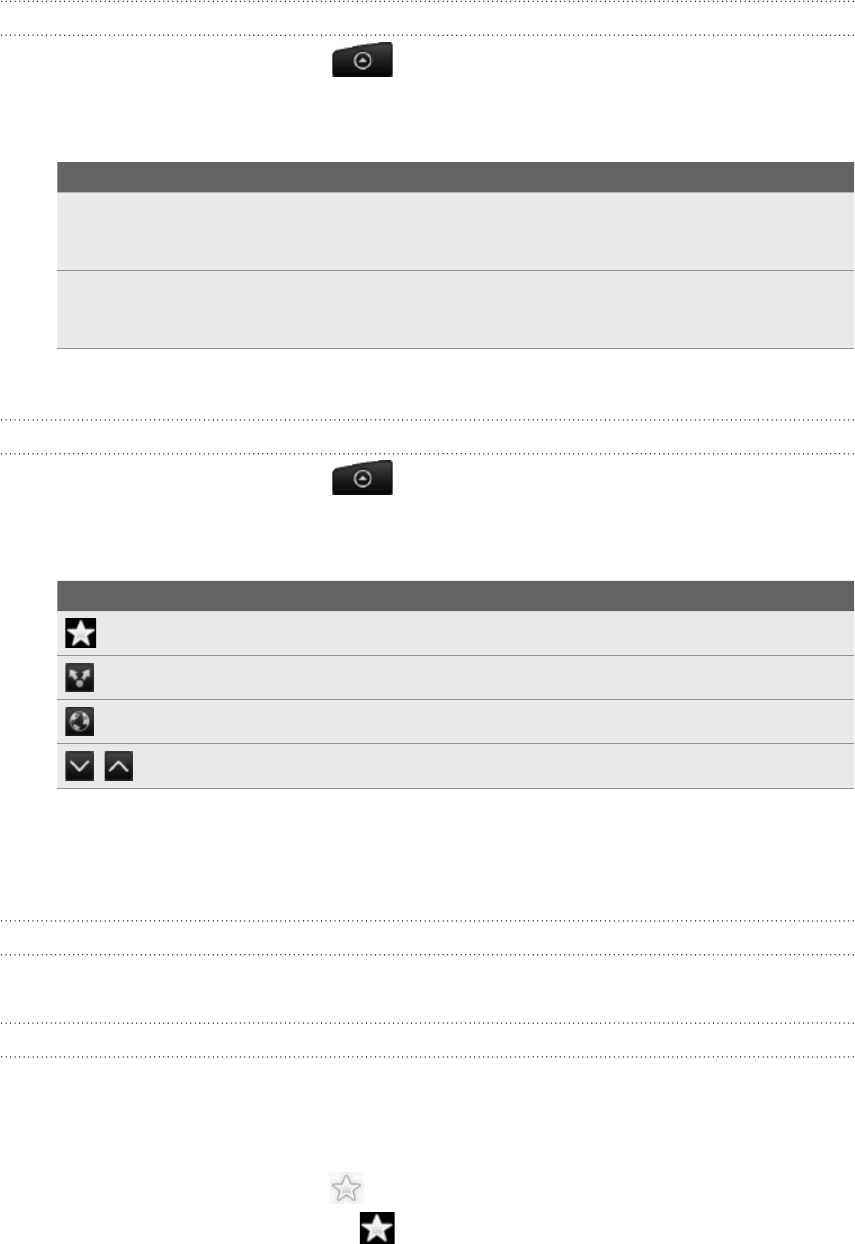
193 More apps
Subscribing to news channels
From the Home screen, tap > News.
On the Subscriptions tab, tap Add feeds.
Do one of the following:
Tap To
Any category
(such as Blogs, Entertainment,
Sports, and more)
Choose from popular news feeds.
Search more Enter a keyword to search the Web for related news
feeds or enter the complete URL of a news feed to
subscribe to.
4. After selecting the channel or channels to subscribe to, tap Add.
Reading a story
From the Home screen, tap > News.
On the Subscriptions tab, tap a channel.
Tap a story to read it. While reading the story, you can:
Tap To
Star the story as a favorite.
Share a link to the story from the available options.
Go to the web page where the story is published.
Go to the next or previous story in the channel.
4. If you want to read the whole story, tap Read full article. This opens the story
in the web browser. See “Using your phone’s web browser” in the Web browser
chapter to learn how to navigate the web page.
Manually checking for new stories
On the Subscriptions tab, press MENU, and then tap Refresh.
Starring a story
Star your favorite stories to read them again later. Starred stories are displayed on the
Starred tab.
Do one of the following:
On a list of stories, tap next to a story.
While reading a story, tap near the top-right corner of the screen.
You can remove the star from a story by tapping the star icon again.
1.
2.
3.
1.
2.
3.

194 More apps
Adding a keyword
Easily find stories that interest you by entering a search keyword. Stories that contain
the keyword are grouped together on the Keywords tab.
From the Home screen, tap > News.
On the My items tab, tap Keywords > Add keywords.
Enter the keyword, and then tap Add.
Your new keyword is displayed on the Keywords tab. Tap the keyword to show
the stories that contain that keyword.
Changing update schedule and font settings
In the News app, press MENU, tap Settings, and then do the following:
Tap To
Accounts & sync Manage sync options and general News settings.
Update when
opened
Update the content of the channels you’ve subscribed to every time
you open the News app.
Update schedule Choose a time interval when the channels you’ve subscribed to are
updated. Select Manual to refresh the content only when you like.
News content Choose how to read news stories by default: whether as a summary or
as a full web page article.
Adding the News widget
Read snippets of stories that you have subscribed to right on the Home screen. To find
out how to add this widget to your Home screen, see “Personalizing your Home screen
with widgets” in the Personalizing chapter.
1.
2.
3.
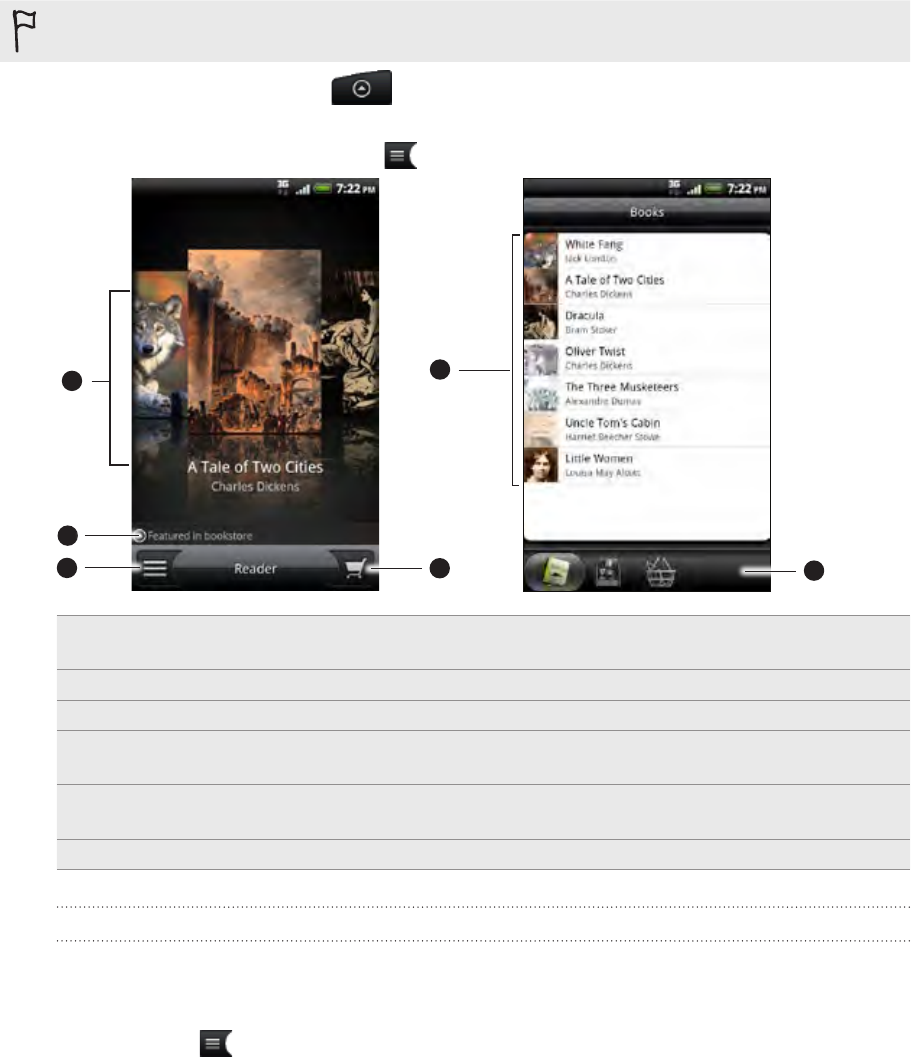
195 More apps
Reading eBooks
Start your own library of bestsellers and literary classics right on your phone.
Use the Reader app to read and download eBooks from Kobo, an online bookstore.
We’ve included some eBooks for you to try. But to browse for more titles from Kobo, you need
to be connected to the Internet.
From the Home screen, tap > Reader.
You’ll find thumbnails of your twenty recently read and downloaded eBooks. To view
your complete library, simply tap .
2
34
5
1
6
1 Slide your fingers left or right across the screen, and then tap a book thumbnail to open an
eBook. See “Flipping through an eBook.”
2 Tap to show suggestions of top-rated and best-selling eBooks from Kobo.
3 Tap to go to the library.
4 Tap to go to the bookstore where you can browse eBook categories, including free
downloads, and buy from Kobo. See “Downloading an eBook.”
5 Find and select an eBook to read from your library. Press MENU to show options for sorting
(by Most Recent, Title, or Author) and deleting eBooks.
6 Slide to other tabs for options on downloading eBooks. See “Downloading an eBook.”
Flipping through an eBook
1. On the Reader main screen, do one of the following to open an eBook:
Tap a book thumbnail
Tap , and then tap a title from the library
2. Slide your finger left or right of the screen to flip through previous or next pages.
3 While reading, you can:
Add a bookmark. Press MENU, and then tap Bookmarks. Easily return to the
page later when you view the Annotations tab.
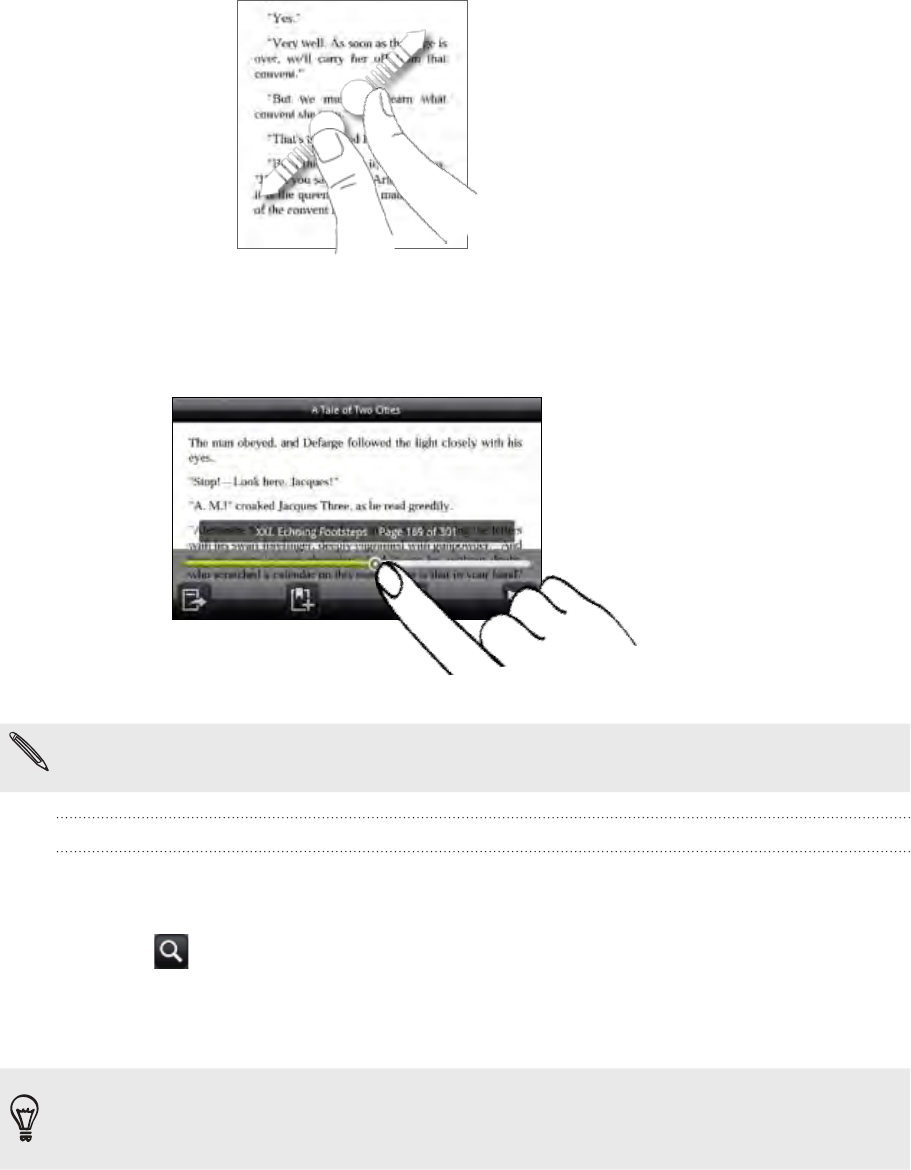
196 More apps
Change the font size. Press MENU, and then tap Font size. A simpler way is
to pinch or spread your thumb and index fingers across the page.
Turn your phone left sideways to view the eBook in landscape mode.
Jump between chapters. Tap anywhere on the screen, and then drag the
slider.
4. Press BACK to close the eBook.
When you reopen an eBook, it will take you to the page that you last viewed.
Searching inside an eBook
1. While reading an eBook, press SEARCH.
2. Type the word or words you want to search for.
3. Tap to view the matches. You’ll see a list of chapters that contain the
matches.
4. Tap a chapter to preview where the matches appear, and then tap a match to go
to the specific page where it’s highlighted.
Want to take your search further to the web? Simply select the text and then tap Quick
Lookup. To learn more, see “Selecting text” in the Keyboard chapter and “Quickly looking up
information on the Web” in the Getting started chapter.
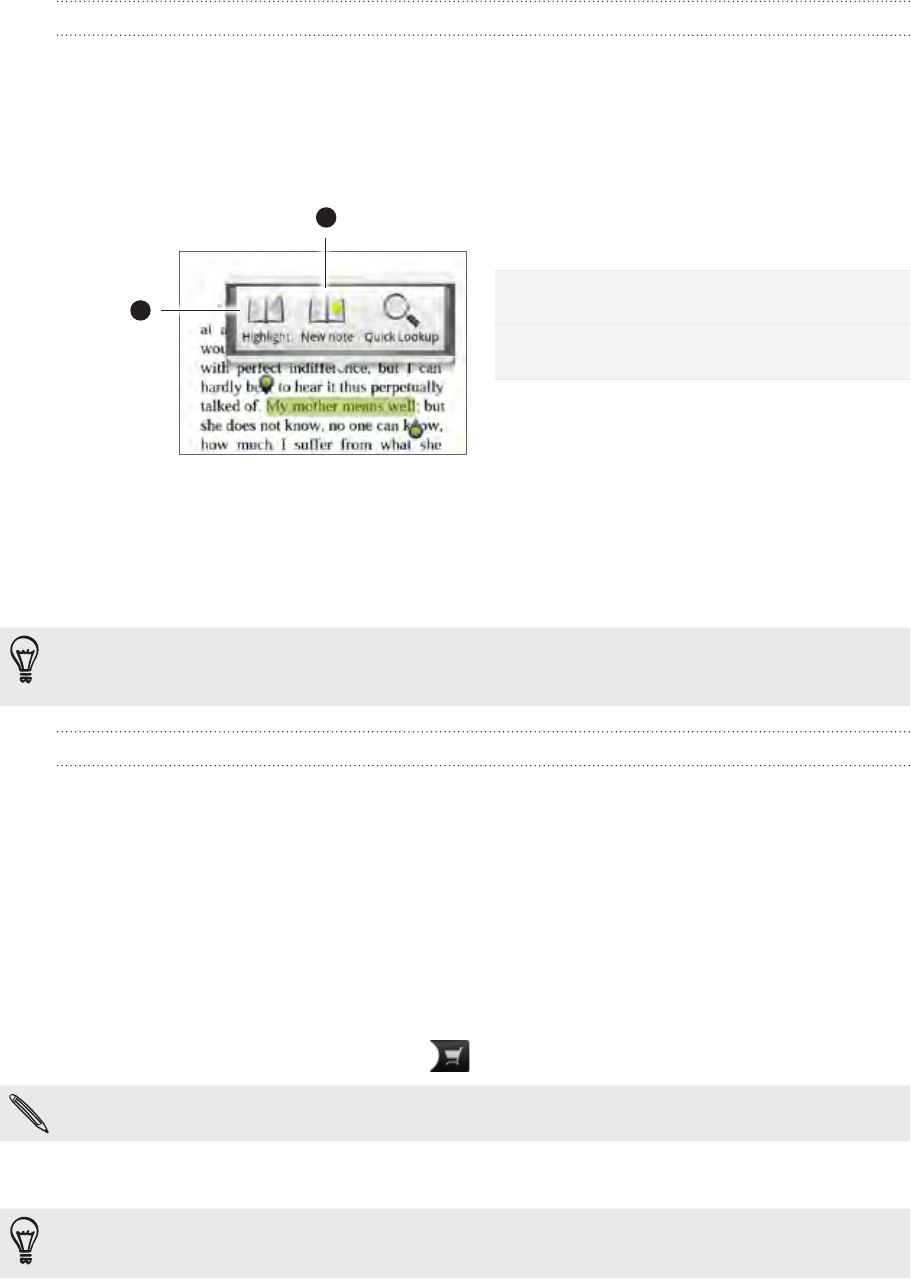
197 More apps
Adding a note or highlighting selected text
Spotted an interesting quote or a less-known fact? Take note or highlight it.
1. While reading an eBook, press and hold on a word.
Drag the start and end markers to select the surrounding text.
2. Do one of the following:
1
2
1 Tap to add a note. Type a short comment
or remark, and then tap Done.
2 Tap to highlight the selected text using
your choice of color.
3. To view any note or highlight you’ve created, do either of the following:
Press MENU > Annotations, and then slide to the Notes or Highlights tabs.
Tap anywhere on the screen, and then tap Annotations > Notes or
Highlights.
You can also view your bookmarks and as well as the eBook’s table of contents from the
Annotations tab.
Downloading an eBook
Browse the bookstore and choose from hundreds of available titles to download.
But first, you need to have:
a microSD card on your phone
an active Wi-Fi or data connection
a Kobo account and an Adobe ID account. If you don’t have these accounts
yet, either sign up from your phone or from your computer’s web browser
(https://www.kobobooks.com/signup.html and
https://www.adobe.com/cfusion/membership/index.cfm).
1. On the Reader main screen, tap to go to the bookstore.to go to the bookstore.
If you have previously bought eBooks from Kobo using another computer, you can download
it to your phone from the Reader screen’s Available for download tab.
2. Tap a category to see available eBook titles. To switch views for more categories,
press MENU, and then tap either Browse or Discover.
To find a specific eBook title or author in the bookstore, press SEARCH.
3. Tap the eBook you want to download.
You’ll then see information such as the eBook’s price, as well as its summary and
customer ratings.

198 More apps
4. Tap to place your order.
5. When prompted, sign in with your Kobo and Adobe ID accounts.
6. Provide your purchase details, and then tap Buy.
When you’ve used Kobo once to purchase an eBook, the phone remembers your billing details
so you don’t need to enter it the next time. If you want to clear it, you need to do it from the
Kobo website. For information on protecting your phone, see the Security chapter.
7. Tap to download the eBook. When downloading is complete, you can find
the eBook in your library.
Recommending an eBook
Let your friends know what you’re reading, and suggest titles that you’ve enjoyed.
1. While reading an eBook, press MENU, and then tap Share.
2. Choose how you want to share the eBook title from the available options.
Deleting an eBook
On the Reader main screen, tap .
On the Books tab, press MENU, and then tap Delete.
Select the items you want to delete.
Tap Delete, and then tap OK to confirm.
About the My Shelf widget
Use the My Shelf widget to easily open your eBooks for reading right from your Home
screen. To find out how to add this widget to your Home screen, see “Personalizing
your Home screen with widgets” in the Personalizing chapter.
1.
2.
3.
4.

199 More apps
Working on documents, spreadsheets, and
presentations
Need to tweak a report while you’re on the go? Use Quickoffice to easily view, edit, or
even create Microsoft Office Word (.doc) and Microsoft Office Excel (.xls) files. You can
also use it to view Microsoft PowerPoint (.ppt) presentations and text (.txt) files on
your phone.
From the Home screen, tap > Quickoffice.
If you have a long file list, press MENU and then tap Sort to arrange your files by name
or date. Press SEARCH to look for specific filenames.
Viewing a document, spreadsheet, or presentation
1. On the Quickoffice main screen, tap the file you want to open.
2. While viewing a file, you can:
Slide your finger on the screen to pan or go through the pages of the file.
Turn your phone left sideways to view the file in landscape mode.
To zoom in, spread your thumb and index finger across the screen. To zoom
out, pinch your thumb and index finger on the screen.
After you zoomed in on a PowerPoint slide, double-tap the slide to make it fit with the screen’s
width.
Press MENU and then tap Worksheet to view other worksheets in an Excel
file.
Tap a URL link in a Word or PowerPoint file to open the web page in the
web browser.
When you open Word documents, Quickoffice reformats the text to make
it fit the screen’s width. Press MENU, and then tap View to switch between
normal and reformatted modes.
Quickoffice does not reflow text in tables.
Editing a document or worksheet
1. While viewing a document or worksheet, press MENU, and then tap Edit.
2. Use the onscreen keyboard to make your changes on the file. For information
about the onscreen keyboard, see the Keyboard chapter.
3. When done, press MENU > More, and then tap Save or Save as to keep your
changes.
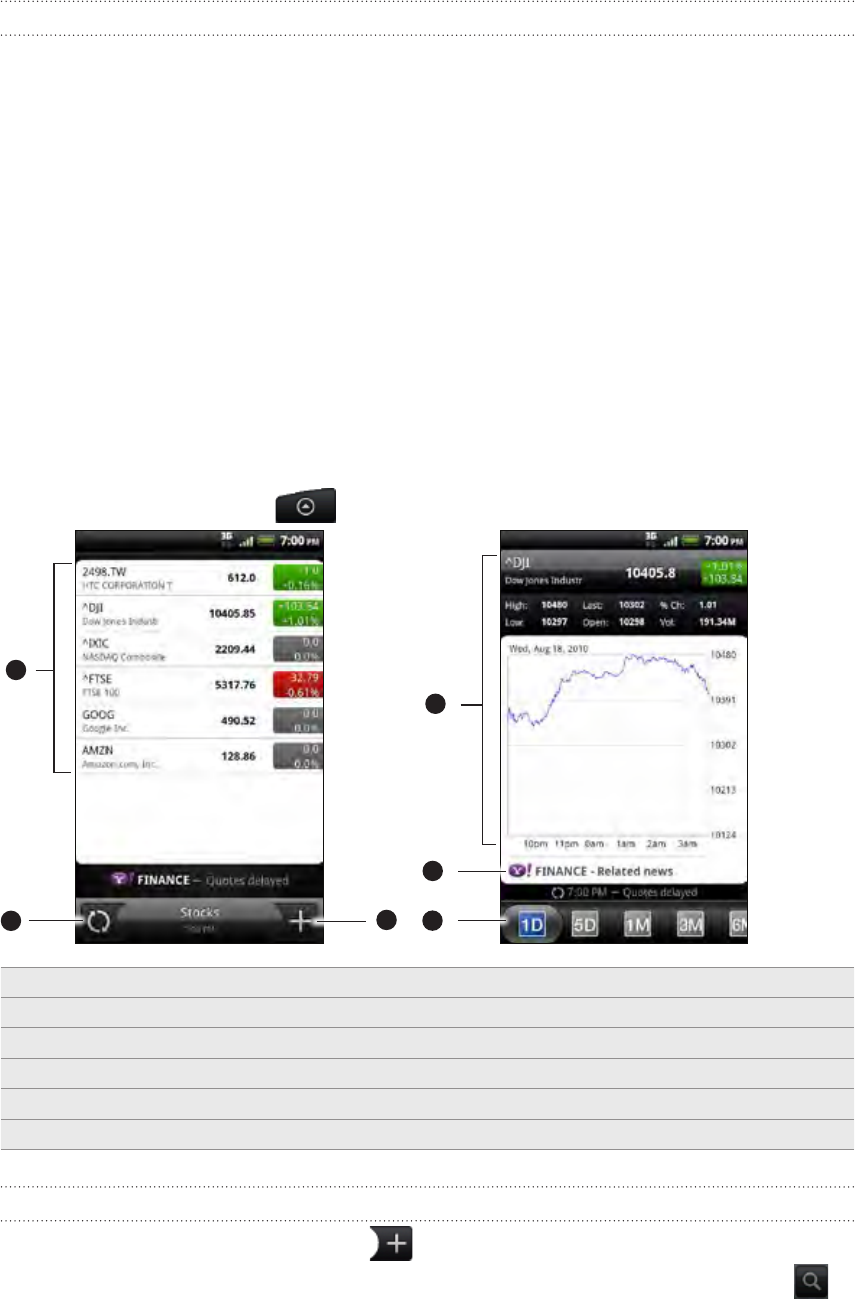
200 More apps
Creating a new document or worksheet
1. On the Quickoffice main screen, press MENU, and then tap New.
2. Choose a file type to create:
Word 97- 2003 document
Excel 97 - 2003 workbook
3. Press MENU, and then tap Edit to use the onscreen keyboard. For information
about the onscreen keyboard, see the Keyboard chapter.
4. When done, press MENU > More, and then tap Save or Save as to keep your
changes.
Keeping track of your stocks
Use the Stocks app to get the latest stock updates for stock quotes and market
indices you follow.
From the Home screen, tap > Stocks.
23
1
4
5
6
1 Tap an item to view from the list of stock quotes and market indices.
2 Tap to update the stock information.
3 Tap to add a stock quote or stock market index.
4 Slide to other tabs to view up to two years of an item’s past trade information.
5 Tap to view related news for a selected item.
6 View an item’s trade information, and as well as its price chart for a specific period.
Adding a stock quote or stock market index
On the Stocks main screen, tap .
2. Enter the stock quote or stock market index on the text field, and then tap .
3. On the results list, tap the stock quote or stock market index you want to add.
1.

201 More apps
Changing the stock list order
On the Stocks main screen, press MENU, and then tap Rearrange.
Press and hold at the end of the item you want to move. When the row is
highlighted in green, drag it to its new position, and then release.
Tap Done.
Deleting stock quotes and indices
On the Stocks main screen, press MENU, and then tap Delete.
Select the items you want to delete, and then tap Delete.
Manually updating stock information
On the Stocks main screen, press MENU, and then tap Update.
Changing update schedule and color settings
Downloading stock information automatically may incur additional fees from your mobile
operator.
In the Stocks app, press MENU, tap Settings, and then do the following:
Tap To
Update when
opened
Update the stock information every time you open the Stocks app.
Scheduled sync Set automatic downloads of stock information.
Update schedule Choose a time interval for checking updates.
Set color for price
raise
Change the color for displaying stock price increases to either red or
green, depending on what’s being used in your country.
About the Stocks widget
Use the Stocks widget to instantly check stock updates right on your Home screen.
It comes in different looks and styles. To find out how to add this widget to your
Home screen, see “Personalizing your Home screen with widgets” in the Personalizing
chapter.
1.
2.
3.
1.
2.
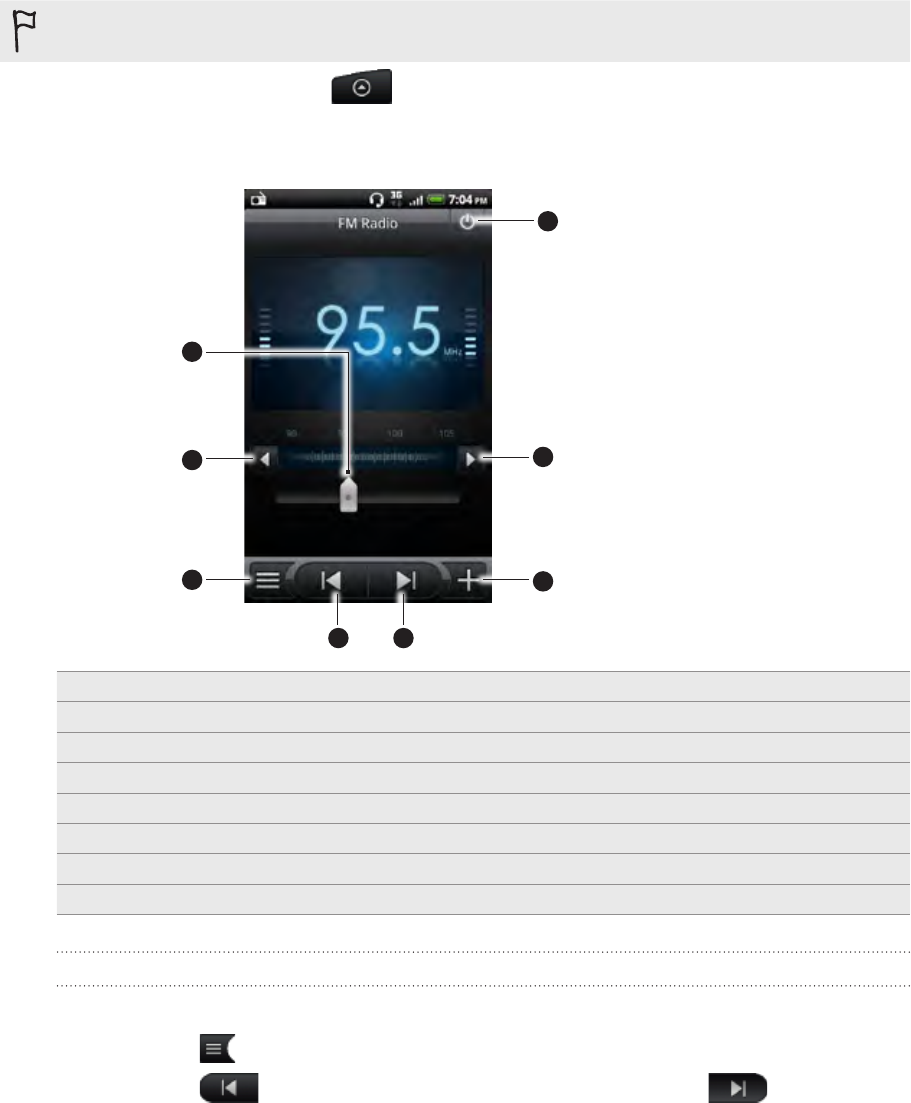
202 More apps
Listening to FM Radio
Tune in and listen to chart-topping pop songs using your phone’s FM Radio app.
You need to connect a headset first to the audio jack of your phone to use FM Radio. FM
Radio uses the stereo headset as the FM radio antenna.
From the Home screen, tap > FM Radio.
The first time you open FM Radio, it automatically scans for available FM stations,
saves them as presets, and plays the first FM station found.
8
2
3
45
6
7
1
1 Drag to tune in to a frequency on the FM band.
2 Tap to fine tune the radio frequency by -0.1 MHz.
3 View the All presets list.
4 Tap to search the FM band for the previous FM station.”
5 Tap to search the FM band for the next FM station.
6 Tap to change the name of the current station you are tuned into.
7 Tap to fine tune the radio frequency by +0.1 MHz.
8 Switch off and close FM Radio.
Tuning in to an FM station
There are several things you can do while you’re on the FM Radio screen:
Tap and then select a station you want to listen to.
Tap to go to the previous available FM station, or to go to the
next available FM station.
Press the VOLUME UP and VOLUME DOWN buttons on the side of the
phone to adjust the volume.
To repeat scanning and saving of FM stations, press MENU, and then tap
Scan & Save. Press BACK to stop the auto-scan.
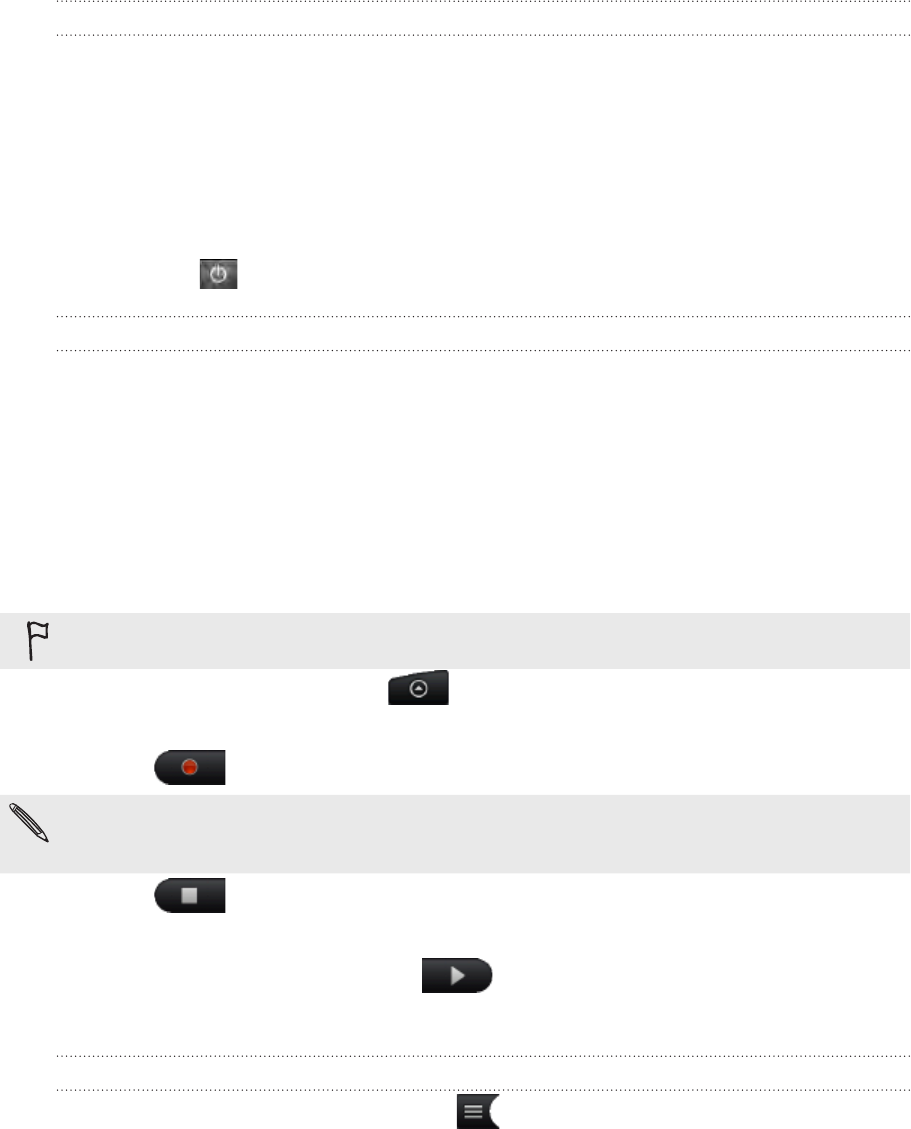
203 More apps
Press MENU to mute the sound or to change the sound output to Mono or
Stereo.
You can also switch the sound output between the Speaker and Headset.
Closing or turning off FM Radio
To close the FM Radio screen:
Press BACK. FM Radio continues to run in the background, and you can still
listen to the radio while using other apps on your phone.
To go back to the FM Radio screen, slide open the Notifications panel, and
then tap FM Radio.
To turn off completely and close FM Radio:
Tap on the upper-right corner of the FM Radio screen.
Adding the FM Radio widget
Use the FM Radio widget to listen to your favorite FM stations right on your Home
screen. To find out how to add this widget to your Home screen, see “Personalizing
your Home screen with widgets” in the Personalizing chapter.
Recording your voice
Don’t just think out loud. Use Voice Recorder to quickly capture your thoughts. You
can also record your voice and set it as a ringtone.
You need to have a microSD card on your phone to use Voice Recorder.
From the Home screen, tap > Voice Recorder.
Hold the phone’s microphone near your mouth.
Tap to start recording a voice clip.
Voice Recorder can run on the background while you do other things on your phone, except
when you open other apps that also use audio functions. To go back to the Voice Recorder
screen, slide open the Notifications panel, and then tap Voice Recorder.
4. Tap to stop recording.
5. Type a name for the voice clip and tap Save.
6. To play back the voice clip, tap .
7. To show options for sharing, deleting, or renaming the voice clip, press MENU.
Sharing a voice clip
On the Voice Recorder screen, tap .
Press and hold the voice clip you want to share, and then tap Share.
From the available options, choose how you want to share the voice clip.
1.
2.
3.
1.
2.
3.
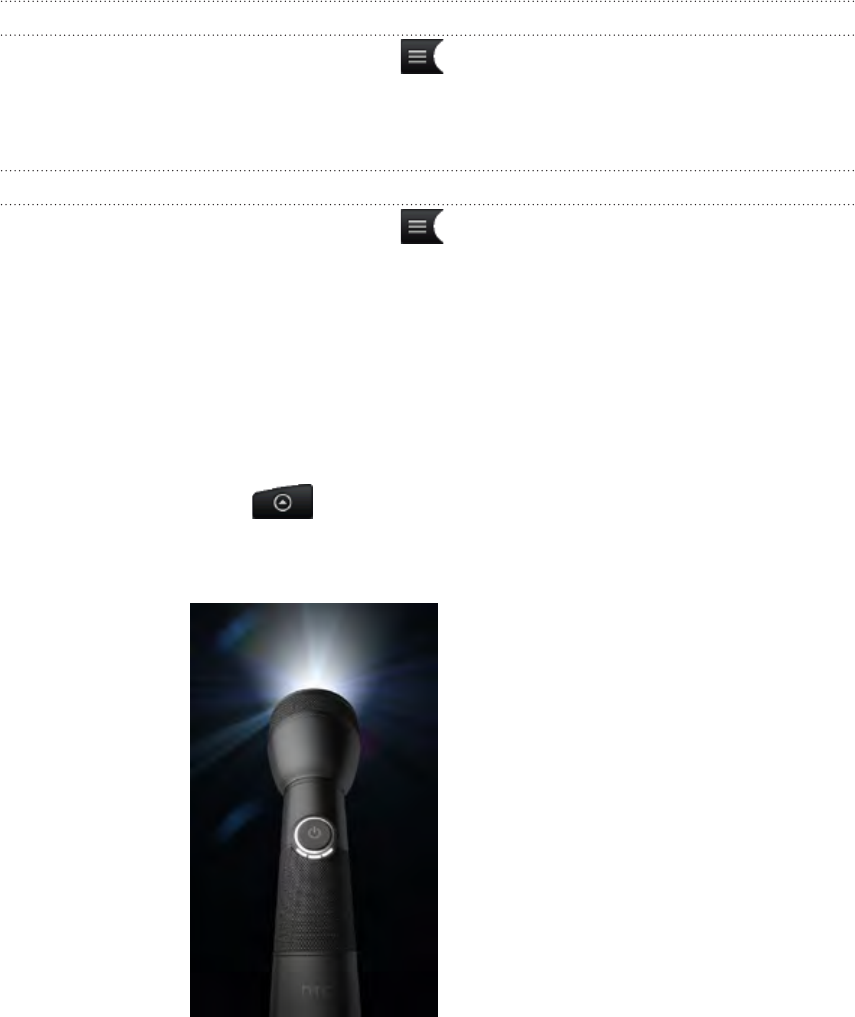
204 More apps
Setting a voice clip as a ringtone
On the Voice Recorder screen, tap .
Press and hold the voice clip you want to set as a ringtone, and then tap Set as
ringtone.
Renaming a voice clip
On the Voice Recorder screen, tap .
Press and hold the voice clip you want to rename, and then tap Rename.
Enter the name, and then tap Save.
Using Flashlight
Never get caught in the dark again. Use the Flashlight app to turn on your phone’s
LED flashlight to shine a light wherever you need it.
On the Home screen, tap > Flashlight.
The app then plays a short animation to show you how to adjust brightness and turn
the light on or off.
To adjust the brightness of the light, simply tap the onscreen power button on
the flashlight handle.
To close the flashlight, press BACK.
1.
2.
1.
2.
3.
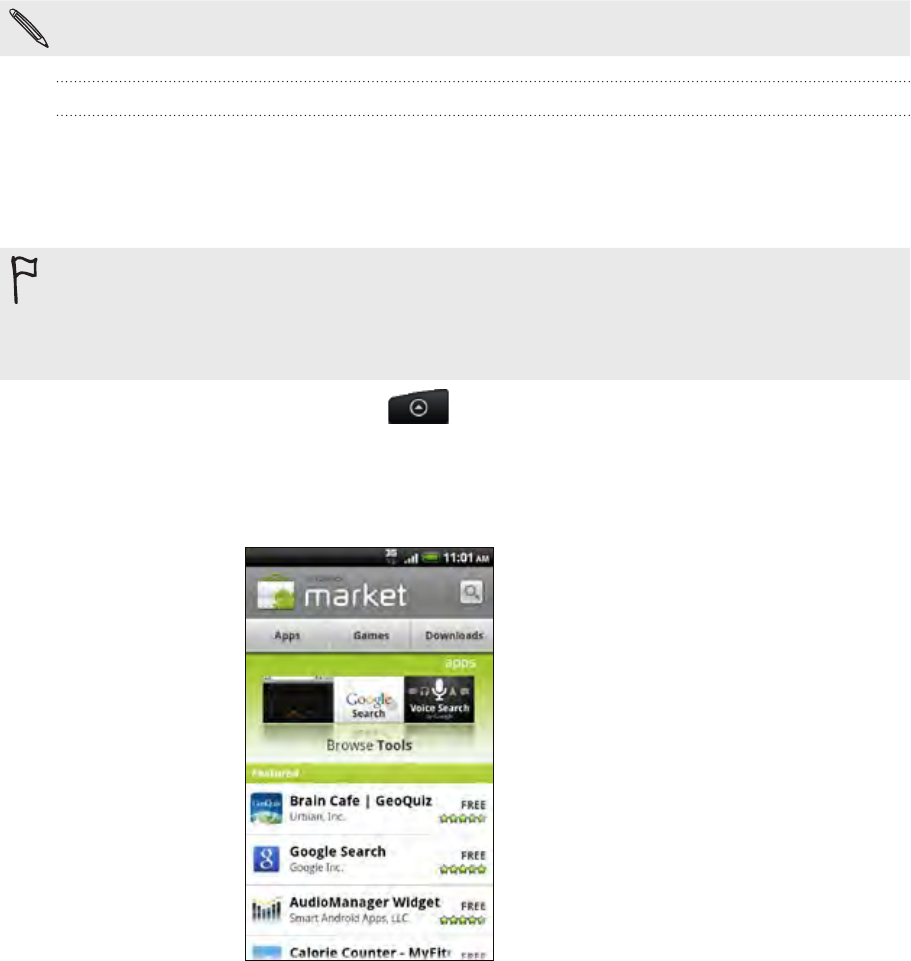
205 More apps
Finding and installing apps from Android
Market
Android Market™ is the place to go to find new apps for your phone. Choose from a
wide variety of free and paid apps ranging from productivity apps, entertainment, to
games. When you find an app you want, you can easily download and install it on your
phone with just a few taps of your finger.
To access Android Market, you must first connect to the Internet using your phone’s
Wi-Fi or data connection and sign in to your Google Account.
Paid apps are currently only available in certain countries.
Finding and installing an app
When you install apps from Android Market and use them on your phone, they may
require access to your personal information (such as your location, contact data, and
more) or access to certain functions or settings of your phone. Download and install
only apps that you trust.
You need a Google Checkout account to purchase items on Android Market. See “Creating a
Google Checkout account” to set up a Google Checkout account if you do not have one.
Be cautious when downloading apps that have access to your phone’s functions or a
significant amount of your data. You’re responsible for the results of using downloaded apps
on your phone.
1. From the Home screen, tap > Market.
When you open Android Market for the first time, the Terms of Service window
will appear. Tap Accept to continue.
2. Do any of the following to find an app:

206 More apps
To Do this
Browse featured apps Scroll through the list of featured apps.
Browse apps by
categories
Tap Apps or Games, and then tap a category. Under a category,
you can filter the apps by Top paid, Top free or Just in.
Search for an app Tap on the Android Market home screen, enter the name or
type of app you’re looking for, and then tap to the right of
the search box.
3. When you find the app that you like, tap it and read its description and user
comments.
4. Tap Install (for free apps) or Buy (for paid apps).
The subsequent screen notifies you whether the app will require access to your
personal information or access to certain functions or settings of your phone.
5. If you agree to the conditions, tap OK to begin downloading and installing the
app.
If you selected a paid app, after tapping OK, you will be redirected to the Google
Checkout screen to pay for the app before it’s downloaded to your phone.
Creating a Google Checkout account
You must have a Google Checkout account associated with your Google Account to
purchase items from Android Market.
To create a Google Checkout account, do one of the following:
On your computer, go to http://checkout.google.com.
The first time you use your phone to buy an app from Android Market, follow
the prompts onscreen to enter your billing information.
When you’ve used Google Checkout once to purchase an app from Android Market, the phone
remembers your password, so you don’t need to enter it the next time. For this reason, you
should secure your phone to prevent others from using it without your permission. See the
Security chapter to learn how to secure your phone.
Requesting a refund for a paid app
If you are not satisfied with an app, you can ask for a refund within 24 hours of the
purchase. Your credit card will not be charged and the app will be removed from your
phone.
If you change your mind, you can install the app again, but you can’t request a refund
a second time.
From the Home screen, tap > Market > Downloads.
Tap the app you want to uninstall for a refund. The details screen for the app
opens.
Tap Uninstall & refund. Your app is uninstalled and the charge is cancelled.
Choose the reason for removing the app, and then tap OK.
1.
2.
3.
4.

207 More apps
Opening an installed app
Do one of the following:
If you see this icon ( ) on the status bar, open the Notifications panel, and
then tap the app. See “Opening the Notifications panel” in the Getting started
chapter.
From the Home screen, tap > Market > Downloads. On the Downloads
screen, tap the app and then tap Open.
From the Home screen, tap . On the All apps screen, locate the app,
and then tap it.
Uninstalling an app
You can uninstall any app that you have downloaded and installed from Android
Market.
From the Home screen, tap > Market > Downloads.
Tap the app you want to uninstall, and then tap Uninstall.
When asked, tap OK.
Choose the reason for removing the app, and then tap OK.
Getting help
If you need help or have questions about Android Market, press MENU, and then tap
Help. The web browser will take you to the Android Market Help web page
1.
2.
3.
4.
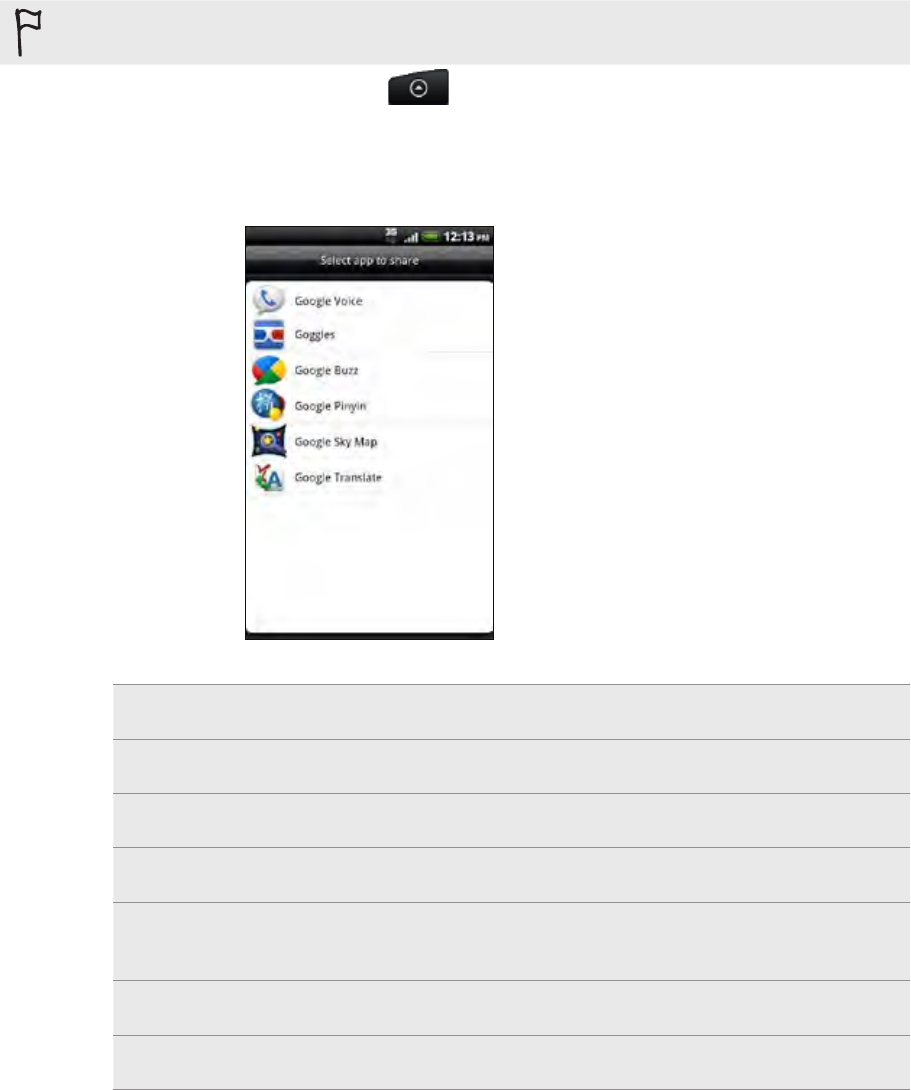
208 More apps
Sharing games and apps
Having fun with a game or app that you’ve downloaded from Android Market? Share it
instantly with your circle of friends.
For your friends to link to the app and download it from Android Market, they must be using
an Android phone.
1. From the Home screen, tap .
2. Press MENU, and then tap Share.
You’ll then see the list of games and apps that you downloaded and installed
from Android Market.
3. Tap an app, and then choose how to share it:
Bluetooth Send the link using Bluetooth.
See the Bluetooth chapter.
Facebook Post the link to Facebook.
See the Social chapter.
Friend Stream Post the link to Facebook and Twitter.
See the Social chapter.
Gmail Send the link using your Gmail account.
See the Email chapter.
Mail Send the link using your POP3/IMAP or Exchange ActiveSync
email account.
See the Email chapter.
Message Send the link in a text message.
See the Messages chapter.
Peep Share the link in Twitter.
See the Social chapter.
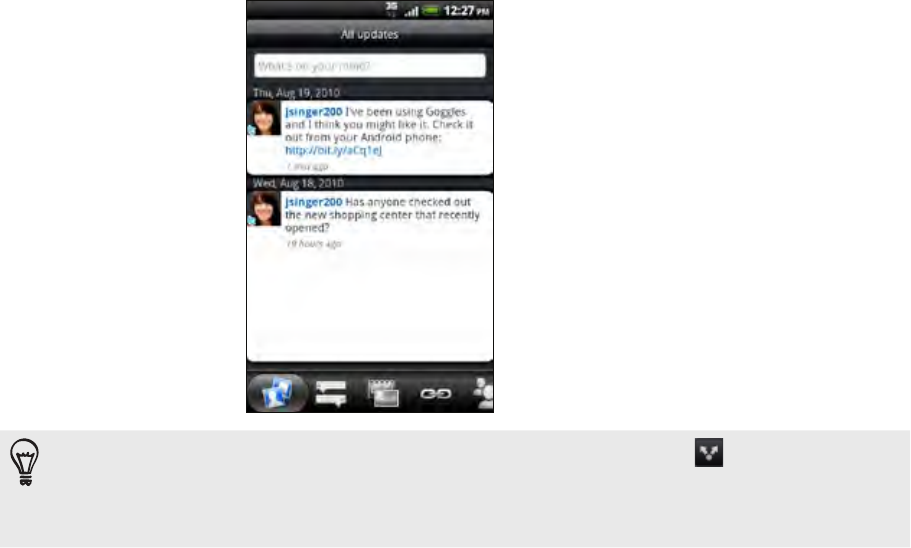
209 More apps
When your friends see the link in your sent message, email, or status update, they can
simply tap the link to go directly to the game or app in Android Market to download it.
While entering your status update in Friend Stream, you can also tap to choose from
games or apps that you want to share in your social networks.
If you’ve already created a new text or email message, press MENU and then tap Attach >
App recommendation to choose from your list of installed games and apps.

210 Security
Security
Protecting your SIM card with a PIN
Add another layer of security for your phone by assigning a PIN (personal
identification number).
Make sure you have the default SIM PIN provided by your mobile operator before
continuing.
From the Home screen, press MENU, and then tap Settings > Security.
Tap Set up SIM card lock, then select Lock SIM card.
Enter the default SIM card PIN, and then tap OK.
To change the SIM card PIN, tap Change SIM PIN.
Emergency calls can be placed at any time without requiring a PIN. See “Making an
emergency call” in the Phone calls chapter for more details.
Restoring a SIM card that has been locked out
If you enter the wrong PIN more times than the maximum number of attempts
allowed, your SIM card will become “PUK-locked.” You need a PUK code to restore
access to the phone. This code may have been provided by your mobile operator
when you received your SIM card.
On the Phone dialer screen, enter the PUK code, and then tap Next.
Enter the new PIN you want to use, and then tap Next.
Enter the new PIN again, and then tap Next.
1.
2.
3.
4.
1.
2.
3.

211 Security
Protecting your phone with a screen lock
Protect your personal information and prevent others from using your phone without
your permission by setting a screen lock password, a PIN, or a lock pattern.
Your screen lock will be asked every time your phone is turned on or when it’s idle for
a certain period of time.
From the Home screen, press MENU, and then tap Settings > Security.
Tap Set up screen lock.
Tap one of the following:
None Disable the screen lock you’ve previously created.
Pattern Set a screen lock pattern by following the onscreen instructions.
PIN Set a numeric password of at least four digits.
Password Set an alpha-numeric password. Tap the text field to show the onscreen
keyboard, then enter your password.
4. On the Security screen, tap Lock phone after, then specify the idle time you can
allow before the screen is locked.
You can also clear the Use visible pattern on the Security screen if you don’t want your screen
lock pattern to display as you draw it onscreen.
Changing your screen lock
From the Home screen, press MENU, and then tap Settings > Security.
Tap Change screen lock.
Enter your current screen lock to confirm that you want to change it.
Choose a different screen lock type, then enter your new pattern, PIN, or
password.
Or tap None if you don’t want to use a screen lock.
Forgot your screen lock pattern?
If you’ve forgotten your screen lock pattern, you have up to five attempts to try and
unlock your phone. If this fails, you can unlock your phone by entering your Google
Account user name and password.
On the unlock screen, enter your lock pattern.
After the fifth attempt and you’re asked to wait for 30 seconds, tap OK.
If the display goes off, press the POWER button to turn the display back on, and
then press the bar on the lock screen and slide your finger down to unlock the
screen.
Tap the Forgot pattern button in the lower right corner when it appears.
Enter your Google Account name and password, and then tap Sign in.
You’ll then be asked to create a new screen lock pattern. If you no longer want to do
so, tap Cancel.
1.
2.
3.
1.
2.
3.
4.
1.
2.
3.
4.
5.

212 Settings
Settings
Settings on your phone
Control and customize phone settings on the Settings screen.
From the Home screen, press MENU, and then tap Settings.
Personalize Choose a scene, set the Home screen or Lockscreen wallpaper
to use, apply a skin, and set sound options. You can also
rename or delete a custom scene by pressing and holding a
scene in Scenes.
Wireless & networks Set up your phone’s wireless connections, such as Wi-Fi and
Bluetooth, enable the Airplane mode, or set the options for
mobile networks, roaming, Wi-Fi hotspot, Virtual Private
Networks, and more.
Call Set up call services such as voicemail, call forwarding, call
waiting, and caller ID.
Sound Choose sounds to use for your phone ringtone and
notifications.
Adjust media playback volume. See “Adjusting the volume”
in the Getting started chapter.
Set to lower the ring volume when you move the phone
when it’s ringing, make the phone ring louder when inside a
bag or pocket, and turn on the spekerphone when you flip
over the phone.
Turn on or off sound and vibrate features such as Audible
touch tones, Quiet ring on pickup, Pocket mode, and more.
Display Set up display settings such as automatic screen orientation,
brightness, screen timeout, and more.
Accounts & sync Log in or out of your social network accounts, Google Account,
Exchange ActiveSync account, and HTCsense.com acount. You
can also manage synchronization and other settings for your
accounts. See the Accounts and sync chapter for details.
Location Select the sources to use when determining your location.
Select Phone finder so you can use HTCsense.com to locate
your phone.
Search Select items to include when you do a search on your phone
and set Google search options.
Connect to PC Set the default USB connection type to use whenever you
connect your phone to your computer.
Or, select the Ask me check box to set your phone to always
display the screen for selecting the USB connection type. To
find out more, see “Connecting your phone to a computer”
in the Getting started chapter.
Security Set a screen lock, enable the SIM card lock, or manage the
phone’s credential storage. See the Security chapter for details.

213 Settings
Power saver Turn on power saver to automatically switch to power saving
mode when the battery level goes down to the level that you
set. See “Optimizing your phone’s battery life” in this chapter
for details.
Applications Manage running applications, move applications to or from the
storage card, and install or uninstall programs.
SD & phone storage Check the available storage card and phone memory.
From this screen, be sure to unmount your microSD card
before you remove it from your phone.
You can also do a factory reset. See the Update and reset
chapter for more details.
Date & time Set the date and time, time zone, and date or time format. To
turn off auto time synchronization and be able to manually
change time zone settings, see “Setting the time zone, date,
and time” in the Clock and Weather chapter.
Language & keyboard Set the operating system language and region. You can also set
onscreen keyboard options.
Accessibility This option appears only after you’ve downloaded and installed
an accessibility tool, such as a screen reader that provides
voice feedback. You can turn accessibility functions or services
on or off.
Voice input & output Set up the voice input options of your phone. Also, if you’ve
installed a text-to-speech (voice data) application, use this to
set the text-to-speech settings.
About phone Turn on or off scheduled checks for system software
updates, or manually check for updates.
View different information about your phone, such as the
mobile network type, signal strength, battery level, battery
use of individual applications, software version of your
phone, and more. See “Checking information about your
phone” in this chapter.
Changing display settings
Adjusting the screen brightness manually
From the Home screen, press MENU, and then tap Settings.
Tap Display > Brightness.
Clear the Automatic brightness check box.
Drag the brightness slider to the left to decrease or to the right to increase the
screen brightness. Tap OK.
1.
2.
3.
4.

214 Settings
Adjusting the time before the screen turns off
After a period of inactivity, the phone screen turns off to conserve battery power. You
can set the idle time before the screen turns off.
From the Home screen, press MENU, and then tap Settings.
Tap Display > Screen timeout.
Tap the time before the screen turns off.
Turning automatic screen rotation off
By default, the screen orientation automatically adjusts depending on how you hold
the phone.
Automatic rotation is not supported in all application screens.
From the Home screen, press MENU, and then tap Settings .
Tap Display, and then clear the Auto-rotate screen check box.
Recalibrating the G-sensor
Recalibrate the screen if you feel that the screen orientation does not respond
properly to the way you hold the phone.
From the Home screen, press MENU, and then tap Settings.
Tap Display > G-Sensor calibration.
Place the phone on a flat and level surface, and then tap Calibrate.
After the recalibration process, tap OK.
Keeping the screen on while charging the phone
You can keep the phone screen from turning off while you’re charging the phone.
From the Home screen, press MENU, and then tap Settings.
Tap Applications > Development.
Select the Stay awake check box.
Switching animation effects on or off
You can turn off the animation or enable only some animations when switching
between screens.
From the Home screen, press MENU, and then tap Settings.
Tap Display > Animation.
On the options menu, select the animation setting you want.
1.
2.
3.
1.
2.
1.
2.
3.
4.
1.
2.
3.
1.
2.
3.

215 Settings
Changing sound settings
Switching between silent, vibration, and normal modes
To change back from silent to normal mode, simply press the VOLUME UP
button.
To change back from vibration to normal mode, press the VOLUME UP button
twice.
From the Home screen, press MENU, and then tap Settings > Sound > Sound
profile.
You can also add the Profile widget to your Home screen. To find out how
to add a widget, see “Personalizing your Home screen with widgets” in the
Personalizing chapter.
Enabling or disabling audible selection
You can choose to play a sound when you’re selecting items onscreen.
From the Home screen, press MENU, and then tap Settings.
Tap Sound, and then select the Audible selection check box.
Choosing the notification sound
You can choose a default sound for your phone to play whenever there are new
notifications.
From the Home screen, press MENU, and then tap Settings.
Tap Sound > Notification sound.
Select your preferred notification sound in the list, and then tap OK.
To use different sounds for different types of notifications, set the notification sounds
in the respective applications. For example, to set different sounds for received
and sent text messages, open the Messages application, then press MENU and tap
Settings.
Turning on or off automatic ring volume adjustment
Quiet ring on pickup
Your phone has a quiet ring feature that automatically lowers the ring volume when
you move your phone.
From the Home screen, press MENU, and then tap Settings.
Tap Sound, and then select or clear the Quiet ring on pickup check box.
1.
2.
1.
2.
3.
1.
2.

216 Settings
Turning on Pocket mode
To help avoid missing incoming calls when your phone is in your pocket or bag, the
pocket mode feature gradually increases the ring volume and vibrates when you
receive a call. When not in your pocket or bag, the phone will ring at the normal
volume you set.
From the Home screen, press MENU, and then tap Settings.
Tap Sound, and then select or clear the Pocket mode check box.
Switching to speakerphone automatically
You can switch to speakerphone by simply flipping over your phone.
From the Home screen, press MENU, and then tap Settings.
Tap Sound, and then select or clear the Flip for speaker check box.
Changing the phone language
When you turn your phone on for the first time, you’re asked to choose the language
you want to use for your phone. If you want, you can still change the phone language
after you set up your phone. Changing the language adjusts the keyboard layout, date
and time formatting, and more.
The languages available to choose from may depend on the version of phone you
have.
From the Home screen, press MENU, and then tap Settings.
Tap Language & keyboard > Select language.
Tap the language and corresponding region you want to use.
Press HOME to return to the Home screen. You may need to wait a few seconds
for the new language to be applied.
Optimizing your phone’s battery life
You can set the phone to automatically switch to power saving mode when the
battery level reaches a certain level.
From the Home screen, press MENU, and then tap Settings.
Tap Power saver.
Select the Enable power saver check box.
Tap Turn power saver on at, and then select when to switch to power saver
mode.
In the Power saver settings section, set and select the phone behavior when the
phone switches to power saving mode.
1.
2.
1.
2.
1.
2.
3.
4.
1.
2.
3.
4.
5.

217 Settings
Using the GSM network of your mobile operator
Switch to using the GSM network of your mobile operator if you’re not using a data
connection to connect to the Internet. Connecting to your mobile operator’s GSM
network consumes less battery power.
From the Home screen, press MENU, and then tap Settings.
Tap Wireless & networks > Mobile networks > Network mode.
Tap GSM only.
Checking the power usage of applications
From the Home screen, press MENU, and then tap Settings.
Tap About phone > Battery > Battery use.
Managing memory
Checking how much phone memory is available for use
From the Home screen, press MENU, and then tap Settings.
Tap SD & phone storage. The available phone memory is displayed in the Internal
phone storage section.
Checking the available storage card space
From the Home screen, press MENU, and then tap Settings.
Tap SD & phone storage. The total and available storage card space is displayed
in the SD card section.
Clearing application cache and data
From the Home screen, press MENU, and then tap Settings.
Tap Applications > Manage applications.
On the Manage applications screen, switch to the Running tab, and then tap the
application whose cache and/or data you want to delete.
4. In the Application info screen, tap Clear data and/or Clear cache.
Uninstalling third-party applications
You cannot uninstall applications that are preinstalled on the phone.
From the Home screen, press MENU, and then tap Settings.
Tap Applications > Manage applications.
On the Downloaded tab, tap the application you want to uninstall.
On the Application info screen, tap Uninstall.
1.
2.
3.
1.
2.
1.
2.
1.
2.
1.
2.
3.
1.
2.
3.
4.

218 Settings
Moving applications to or from the storage card
Move applications that you’ve downloaded to the phone to the storage card if your
phone’s memory is getting low. Or, if your storage card is getting full, you can also
move applications that are on your storage card to the phone.
You can only move applications that are not preinstalled on your phone.
From the Home screen, press MENU, and then tap Settings.
Tap Applications > Manage applications.
On the Downloaded tab, tap the application you want to move.
On the Application info screen, tap Move to SD card or Move to phone.
Checking information about your phone
From the Home screen, press MENU, and then tap Settings.
Tap About phone.
Select one of the following:
System software updates Enable or disable the automatic check feature for software
updates for your phone. You can also tap Check now to
manually check for software updates.
Network Check information about your mobile operator and its
service status.
Phone identity Check information about your phone and the SIM card
you’re using.
Battery Check information about the battery such as its current
battery level, status, and what programs are using the
battery.
Hardware information Check the Wi-Fi MAC and Bluetooth addresses.
Software information Check the version and other information about the
Android platform being used by the phone. You can also
check the version of the web browser.
Legal information Read legal information from HTC and Google, and licenses
used by the phone.
1.
2.
3.
4.
1.
2.
3.

219 Update and reset
Update and reset
Updating the phone software
From time to time, software updates for your phone may be available. Your phone can
check and then notify you if there’s a new update. You can then download and install
the software update using your phone’s Wi-Fi or data connection.
Checking and downloading phone software updates may incur additional data transfer fees
from your mobile operator.
Make sure your phone has a microSD card inserted. The update will be downloaded to the
microSD card.
Depending on the type of update, the update may erase all your personal data and
customized settings, and also remove any applications you’ve installed. Make sure that
you’ve backed up the information and files you want to keep.
When there is an update available, the Install system software update dialog
box will appear onscreen. Select Install now and then tap OK.
If you’re in the middle of a call and there’s an update available, you’ll receive
an update notification. After you end the call, slide open the Notifications
panel (see “Opening the Notifications panel” in the Getting started chapter).
Then tap the update notification to download and install the software update.
Wait for the update process to finish. When the update is finished, the phone will
automatically reset.
Checking for phone system software updates manually
From the Home screen, press MENU, and then tap Settings.
Tap About phone > System software updates.
On the System software update screen, tap Check now.
1.
2.
3.

220 Update and reset
Restarting or factory resetting your phone
Restarting your phone (soft reset)
If your phone is running slower than normal, an application is not performing properly,
or your phone becomes unresponsive, try restarting your phone and see if that helps
solve the problem.
If the display is off, press the POWER button to turn it back on.
Unlock your phone if the Lock screen is displayed. See “Unlocking the screen” in
the Getting started chapter.
Press and hold the POWER button, and then tap Restart.
When asked to confirm, tap Restart.
If you can’t restart the phone following the above steps, remove the battery, wait for a
few seconds, reinsert the battery, and then turn the phone on.
Performing a factory reset (hard reset)
If you’re passing your phone on to someone else or your phone has a persistent
problem that cannot be solved, you can do a factory reset (also called a hard reset).
This returns your phone to the state it was in before the first time you turned it on.
Factory reset will not erase the data and files that are on the storage card.
Factory reset is not a step to be taken lightly. It’ll permanently delete all your data
and customized settings, and will remove any applications you’ve downloaded and
installed. Be sure to back up any data and files you want to keep before you do a
factory reset.
Performing a factory reset via settings
From the Home screen, press MENU, and then tap Settings.
Tap SD & phone storage > Factory data reset.
On the Factory data reset screen, tap Reset phone, and then tap Erase
everything.
Performing a factory reset using phone buttons
If you can’t turn on your phone or access the phone settings, you can still perform a
factory reset by using the buttons on the phone.
With the phone turned off, press and hold the VOLUME DOWN button, and then
briefly press the POWER button.
Wait for the screen with the three Android images to appear, and then release
the VOLUME DOWN button.
Press VOLUME DOWN to select FACTORY RESET, and then press the POWER
button.
1.
2.
3.
4.
1.
2.
3.
1.
2.
3.
221
Trademarks and copyrights
Copyright © 2010 HTC Corporation. All Rights Reserved.
The HTC logo, the HTC quietly brilliant logo, HTC Desire HD, HTC Sense, HTC Hub,
Footprints, Locations, HTC Sync, and HTC Care are trademarks and/or service marks
of HTC Corporation.
Copyright © 2010 Google Inc. Used with permission.
Google, the Google logo, Android, Google Search, Google Maps, Gmail, Google Mail,
YouTube, Android Market, and Google Talk are trademarks of Google Inc.
Google, the Google logo and Google Maps are trademarks of Google, Inc. TeleAtlas®
Map Data ©2010. Street View Images ©2010 Google.
Microsoft, Windows, Windows XP, Windows Vista, Active Sync, and Outlook are either
registered trademarks or trademarks of Microsoft Corporation in the United States
and/or other countries.
Bluetooth and the Bluetooth logo are trademarks owned by Bluetooth SIG, Inc.
Wi-Fi is a registered trademark of the Wireless Fidelity Alliance, Inc.
microSD is a trademark of SD Card Association.
Copyright © 2010 Adobe Systems Incorporated. All Rights Reserved.
Java, J2ME and all other Java-based marks are trademarks or registered trademarks of
Sun Microsystems, Inc. in the United States and other countries.
Facebook is a trademark of Facebook, Inc.
Twitter is a trademark of Twitter, Inc., and is used under license.
Flickr is a trademark of Yahoo! Inc.
DLNA is a registered trademark, DLNA disc logo is a service mark, and DLNA Certified
is a trademark of the Digital Living Network Alliance.
Dolby is a registered trademark of Dolby Laboratories.
©2010 Kobo Inc. All rights reserved. ™ Kobo and the Kobo logo are trademarks of
Kobo Inc.
All other company, product and service names mentioned herein are trademarks,
registered trademarks or service marks of their respective owners.
HTC shall not be liable for technical or editorial errors or omissions contained herein,
nor for incidental or consequential damages resulting from furnishing this material. The
information is provided “as is” without warranty of any kind and is subject to change
without notice. HTC also reserves the right to revise the content of this document at
any time without prior notice.
No part of this document may be reproduced or transmitted in any form or by any
means, electronic or mechanical, including photocopying, recording or storing in a
retrieval system, or translated into any language in any form without prior written
permission of HTC.

222 Index
Index
Symbols
3G 123
A
Access point 123
Adding a city to the Weather screen 122
Adding a city to the World Clock screen
119
Airplane mode 46
Alarm clock 119
Alarms
- changing the alarm sound 35
Album (Gallery app) 147
Android Market 205
Answering an incoming call 40
Apps
- adding icons from the Home screen 31
- rearranging or hiding tabs 36
- switching between recently-opened
apps 21
App Sharing 208
Attachments
- types of message attachments 68
- viewing and saving message
attachments 71
Auto capture 144, 146
Auto focus 143, 146
B
Battery 12
- Battery compartment cover 8
- charging 14
- inserting 13
- optimizing 216
- removing 12
Blocking callers 45
Bluetooth
- Bluetooth received folder 140
- changing phone name 136
- connecting headset or car kit 136
- receiving information 139
- sending information 138
- sending photo/video 145
- sending photos or videos 151
- sharing music 160
- turning on or o 136
Bookmarks 134
Bottom cover 9
- removing 9
- replacing 9
Browser 129
C
Calendar 108
- widget 115
Calendar events
- creating 108
- deleting 112
- editing 112
- inviting guests to a Google calendar
event 109
- sending an Exchange ActiveSync
meeting request 110
- sharing a vCalendar 113
- viewing 112
Caller ID 40, 41
Call history 44
Calls
- answering a call 40
- ending a call 43
- making a call 37
- putting a call on hold 41
- rejecting a call 40
- switching between calls 42
Call services 46
Camera 141
Car kit 178
Car Panel 180
Charging the battery 14
Chat invitations
- accepting 93
- inviting a friend in Google Talk 94
Chatting in Google Talk 93
Checking information about your phone
218

223 Index
Checking notifications from social
networks 92
Checking weather 121
Clock 116
Clock widget (HTC) 116
Conference call 42
Connected media 161
Connecting your phone to a computer 21
Connect to PC 21
Contact groups 56
- creating 56
- deleting a group 57
- editing a contact group 56
- rearranging your contact groups 57
- Sending a message or email to a group
57
Contact information
- editing 55
- merging 50
- sending 55
Contacts
- adding a new contact 49
- backing up your contacts to the
storage card 53
- importing from an Exchange
ActiveSync account 50
- importing from your SIM card 49
- transferring contacts from your old
phone 48
Contacts list 52
- filtering 53
Conversations 54, 72
Copying files to or from the storage card
22
Copying text 132
D
Data connection 123
Date and time 118
Desk Clock 117
E
Editing text 63
Effects (camera) 145
Email
- sending photo/video 145
- sending photos or videos 150
Emergency call 39
Event reminders 113
Exchange ActiveSync 100, 106
Extended Home screen 17
F
Facebook
- commenting photos 154
- Facebook for Android 86, 87
- Facebook for HTC Sense 85, 87
- sharing photos 151
- view photos 154
Facebook for HTC Sense
- sharing photo/video 145
Face detection
- auto capturing 144
- manual capturing 143
Factory reset 220
Finger gestures 15
Flashlight 204
Flash settings (camera)
- photo mode 143
- video mode 144
Flickr
- commenting photos 154
- sharing photos 152
- viewing photos 154
FM Radio 202
Folders 31
- creating a new folder 31
- renaming a folder 32
Footprints 175
Friend Stream 90
- checking notifications 92
- commenting on and liking Facebook
posts 91
- Friend Stream widget 92
G
G-sensor 214
Gallery 147
Gmail/Google Mail
- about 95
- adding a signature 99
- changing the settings 99
- labeling a conversation 98
- muting a conversation 99
- reading emails 96
- replying/forwarding emails 97

224 Index
- searching emails 97
- sending an email 96
- spam 99
- star an email 98
- using batch operations 99
- viewing the Inbox 95
Google Accounts 75
Google Dictionary 133
Google Latitude 188
Google Maps 183
Google Talk 93
Google Translate 133
Groups 56
H
Home city 118
Home page 129
Home screen 16
- adding folders 31
- adding icons and shortcuts 31
- adding widgets 29
- changing the wallpaper 28
- extended Home screen 17
- personalizing with scenes 27
- rearranging Home screen items 32
- rearranging the home panels 33
HTC Caller ID 41
HTC Clock widget 116
HTCSense.com 163
- Dashboard 164
- deleting 171
- Footprints 166
- HTC Hub 171
- Messages 169
- People 168
- services 164
- signing out 171
- signing up 163
- unpairing your phone 171
HTC Sync 78
I
Internet connections 123
Internet pass-through 21
K
Keyboard 59
- adjusting touch input settings 64
- changing to the landscape onscreen
keyboard 60
- copying and pasting text 63
- enabling multiple keyboard languages
60
L
Latitude 188
Leap view 17
Library (Music) 157
Linking contact information 50
Live wallpapers 28
Locations 172
- Car Panel 180
- downloading or purchasing services
182
- Footprints 175
- getting directions 177
- searching 173
- sharing a location 175
- turn-by-turn navigation 178
- viewing maps 174
- widgets 182
Location services 172
Lock message 72
Lock screen 26
M
Mail app
- about 100
- all accounts 101
- checking email 101
- deleting conversation 97
- deleting email 103
- dierent views of inbox 102
- Exchange ActiveSync 100, 106
- moving 103, 104
- POP3/IMAP account 100
- quick browsing 102
- reading and replying 105
- selecting email messages 103
- sending 104
- setting priority 105
- settings 107

225 Index
- sorting 102
- switching folders 104
- unified inbox 101
Making calls 37
Managing memory 217
Maps 183
Matched contacts suggestions 50
Media volume 25
Meeting request 106
Memory 217
Merging contact information 50
Messages 66
- about the Messages app 66
- deleting a message 72
- protecting a message 72
- replying to a message 70
- resuming a draft message 69
- sending a multimedia message 68
- sending a text message 67
- settings 73
- viewing a message 70
microSD card 11
Microsoft Exchange ActiveSync 100
Missed call 44
MMS 68
- attaching files and information 68
- creating a slideshow 69
- settings 74
Mobile network connection 123
Modem 127
MP3 159
Music 155
- creating a playlist 157
- sharing 160
Muting the microphone 43
My contact card
- creating 48
- sending your contact information 55
N
Navigation 172, 178
News feeds 192
Notification icons 19
Notification sound 215
Notification sounds 35
Notifications panel 20
O
Online accounts 75
Onscreen keyboard 59
Optimizing your phone’s battery life 216
P
Peep 87
People
- about 47
- contact information and conversations
54
- People screen 47
- People widget 58
Personalizing 27
Phone
- front, top, left, and back panels 7
- phone dialer 37
Photo
- sharing 145
- taking a photo 143
Photo editing 149
- adding eects 150
- cropping 149
- rotating 149
Photos
- commenting in your social networks
154
- editing 149
- sending by Bluetooth 151
- sending by email 150
- sending by MMS 151
- sharing on Facebook 151
- sharing on Flickr 152
- sharing on Picasa 153
- viewing 148
- viewing albums in social networks 154
- zooming in or out 149
Pinch 15
Pocket mode 216
POP3/IMAP 100
Predictive text 61
- Personal dictionary 61
- setting a second language for the
keyboard 61
PUK 210
Push messages 71

226 Index
Q
Quick Lookup 24
Quickoffice 199
Quiet ring on pickup 215
R
Reader 195
- deleting an ebook 198
- downloading an eBook 197
- reading an eBook 195
- recommending an eBook 198
- searching inside an eBook 196
- widget 198
Recalibrating the G-sensor 214
Recent apps 21
Recording
- video 144
Recording your voice 203
Rejecting an incoming call 40
Restarting 220
Ringer volume 25
Ringtone 34, 158
- trimming 159
S
Scenes 27
- creating 28
- deleting 28
- renaming 28
Screen lock
- changing your screen lock 211
- lock password 211
- lock pattern 211
- PIN 211
Screen unlock pattern 211
Search Anywhere 23
- searching your phone and the Web 23
- setting search options 23
Searching for a contact 53
Security 210
Selecting text 133
Self-timer (camera) 144
Settings 212
- alarm sound 120
- calendar 115
- camera 146
- date and time 118
- weather 122
Setting up My contact card 48
Setting up your phone for the first time 16
Sharing
- photo 145
- video 145
- YouTube 192
Shortcuts 31
SIM card 10
- copying a message to 72
- entering PIN 15
- inserting 10
- removing 10
- restoring a SIM card that has been
locked out 210
- SIM PIN 210
Skins 29
Sleep mode 26
Slideshow 69
SMS
- composing and sending 67
- settings 74
Social network accounts 76
Social networks
- sharing photo/video 145
Sound sets
- choosing a preset sound set 34
- creating 34
- customizing 34
- deleting 35
Speakerphone 43
Speed dial 38
Status icons 18
Stocks 200
Stopwatch 116
Storage 217
Storage card 11
- copying files to or from 22
- inserting 11
- removing 11
- removing while phone is on 11
Street view 183
Switching between calls 42
Switching your phone on or off 15
T
Talk 93
Tethering 127
Text
- editing 63
- entering text by speaking 62

227 Index
- entering text using the onscreen
keyboard 59
- using predictive text input 61
Timer 116
Time zone 118
Touch input settings 64
Transfer Data 48
Translating words 24
Turning your phone on or off 15
Tweeting on your phone 88
Twitter 88
- Twitter for HTC Sense 87
- Twitter widget 89
U
Unblocking callers 45
Uninstalling third-party applications 217
Unlocking the screen 26
Updating the phone software 219
USB tethering 21
Using your phone as a modem 127
V
vCalendar 113
vCard 55
Vibrate mode 25
Video
- capturing/recording 144
- sharing 145
Videos 191
- sending by Bluetooth 151
- sending by email 150
- sending by MMS 151
- sharing on Facebook 151
- sharing on Flickr 152
- sharing on YouTube 153
- viewing 149
Voice Recorder 203
Volume
- adjusting the earpiece volume for calls
25
- adjusting the media volume 25
- adjusting the ringer volume 25
- adjusting via settings 25
VPN 126
W
Wallpaper 28, 145
Weather 121
Weather widget 122
Web browser 129
Wi-Fi 124
Widgets 29, 194, 201, 203
- adding 29
- changing the widget settings 30
World Clock 118
Y
YouTube 153, 191
- sharing video 145
Z
Zooming (camera) 142